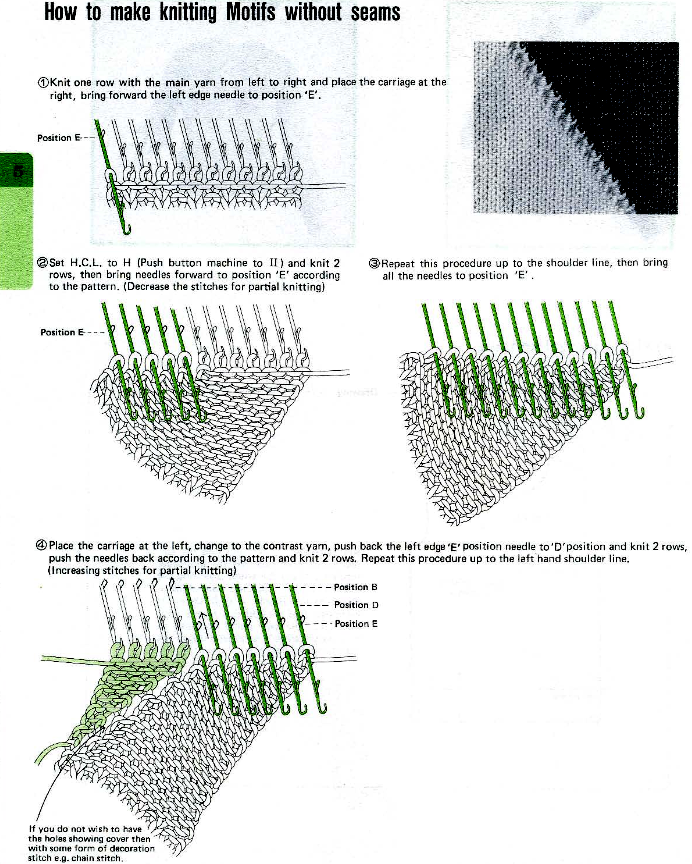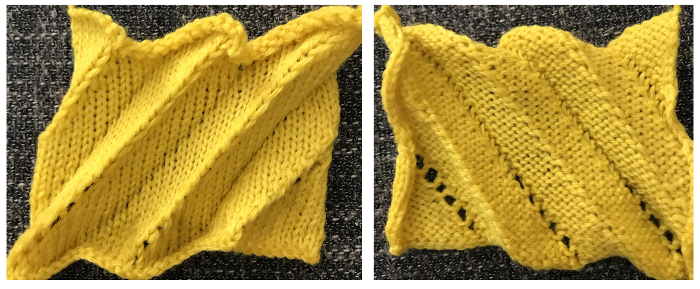Blistered stitches DBJ began to explore some variations for the production of easy knits which resulted in pockets separated by areas of joined stitches, and depending on the design and whether one bed knits more stitches and rows than the other, can make the surface appear 3D to varying degrees.
There are several things to consider in DIY designs.
In my recent browsing and being inspired by “The curse of truchet tiles”, this png was one of the resulting repeats, developed using ArahPaint. It is larger than any previously tested with this technique.
Beginning with a 36X36 file ![]() drawn in test alignment to 108X108,
drawn in test alignment to 108X108, 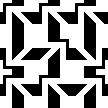 expanding the design through a diagonal choice
expanding the design through a diagonal choice 
![]() into a 72X36 repeat
into a 72X36 repeat ![]()
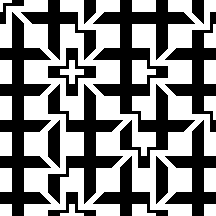 Large repeats require large swatches if gauge matters, but smaller tests serve well to evaluate tension and cam settings. It is a good idea to be consistent in yarn choice.
Large repeats require large swatches if gauge matters, but smaller tests serve well to evaluate tension and cam settings. It is a good idea to be consistent in yarn choice.
Thinking things through:
the white pixel areas will produce the pockets, separating from the ground, and the black pixel areas will compose the joined portions of knit.
To increase the effect, the height of those black pixel areas is reduced by changing their configuration in order to use the slip stitch setting to shorten them.
The first pattern fill requires doubling the height of the whole repeat in order to use the file in a tubular setting. ![]()
 Rather than doubling the file in height, this brush is used to fill the same black pixel areas.
Rather than doubling the file in height, this brush is used to fill the same black pixel areas. 
![]() After a few pixel cleanups, this is the final repeat,
After a few pixel cleanups, this is the final repeat, ![]()
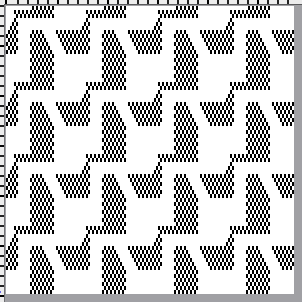 The png was tiled to the number of stitches planned, with the addition of a knit stitch border along each vertical side
The png was tiled to the number of stitches planned, with the addition of a knit stitch border along each vertical side ![]() and knit on 88 stitches for proof of concept.
and knit on 88 stitches for proof of concept.
End needle selection is on.
The carriages are set to slip in opposite directions, in either arrangement A or B.  In one-color knitting starting preselection side does not matter.
In one-color knitting starting preselection side does not matter.
The tension used, since so many stitches will be knitting on alternate beds, needs to approach that used for the same yarn when knitting stocking stitches.
The red yarn stitches mark the knit side of the fabric.
The cotton ball illustrates the formation of pockets.
The color change happened when the first cone of yarn ran out.
The yarns are 2/28 Italian imports of nonspecified fiber content.
The piece measures 10.5 inches in width.
When the settings are changed from tubular to every needle rib, the fabric is considerably wider and ruffles as seen at the top and bottom of the swatch, which could become a planned design feature. 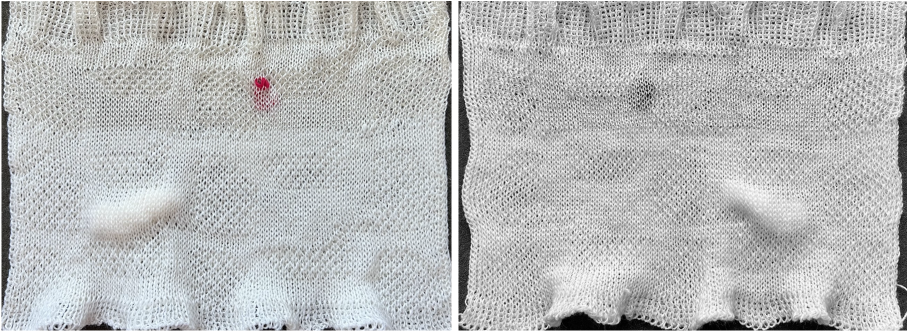 A segment was cropped from the 72X36 drawn once more in repeat to 84X72, repeating the same steps for processing the file
A segment was cropped from the 72X36 drawn once more in repeat to 84X72, repeating the same steps for processing the file 

 alignment check
alignment check 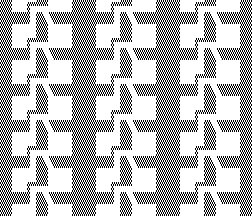 If the plan is to evaluate the effect of tuck stitch on the design, to begin with, the file needs to be color reversed, whether in the drawn png or using machine settings
If the plan is to evaluate the effect of tuck stitch on the design, to begin with, the file needs to be color reversed, whether in the drawn png or using machine settings  Exploring results with the ribber set to knit in on every row, the swatch below the red line was produced with the knit carriage set to knit in one direction, tuck in the other, while in the remainder the knit carriage set to tuck in both directions. The areas that in slip stitch would form pockets knit in every needle rib, while tuck stitch segments produce a lacy effect.
Exploring results with the ribber set to knit in on every row, the swatch below the red line was produced with the knit carriage set to knit in one direction, tuck in the other, while in the remainder the knit carriage set to tuck in both directions. The areas that in slip stitch would form pockets knit in every needle rib, while tuck stitch segments produce a lacy effect. 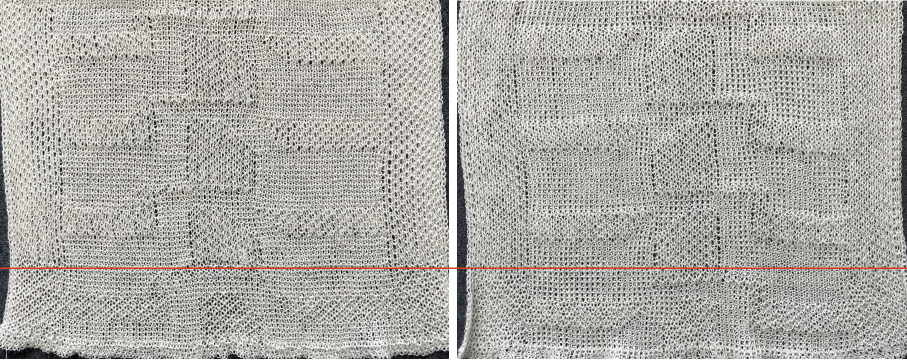 The same design, using the png created prior to color reverse, set for tubular slip stitch
The same design, using the png created prior to color reverse, set for tubular slip stitch  the transition between the changes in knit carriage cam settings results in changes in textures and added width
the transition between the changes in knit carriage cam settings results in changes in textures and added width  The full tuck section (bottom) measures 16 inches in width, and the slip-stitch one (top) measures 11.5 inches.
The full tuck section (bottom) measures 16 inches in width, and the slip-stitch one (top) measures 11.5 inches.
Trying for a half-cardigan repeat with the same yarn produced an extremely wide knit with no discernible design.
Tired of double-bed knitting and swatches in a single color and large enough to cover pillows? the starting image reduced in size X4 to 21X18 pixels opens a new series of opportunities for knitting including on the single bed. 
![]() The design, knit here as DBJ, uses the built-in KRC color separation. At the bottom, the knit carriage is set to slip in both directions. The ribber uses the birdseye setting in both directions with the addition of lili buttons.
The design, knit here as DBJ, uses the built-in KRC color separation. At the bottom, the knit carriage is set to slip in both directions. The ribber uses the birdseye setting in both directions with the addition of lili buttons.
At the top, the knit carriage setting remains unchanged, and the ribber is set to knit in both directions, for a striper backing. The tension remained unchanged. The image illustrates the difference in the aspect ratio of the design and the height and width produced by the respective settings. 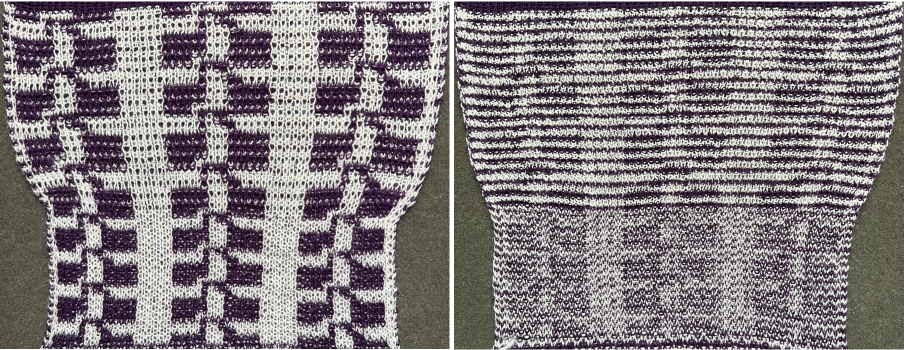 The same design knit as single bed fair isle produces problematic floats on the reverse which would need to be anchored down in a wearable.
The same design knit as single bed fair isle produces problematic floats on the reverse which would need to be anchored down in a wearable. 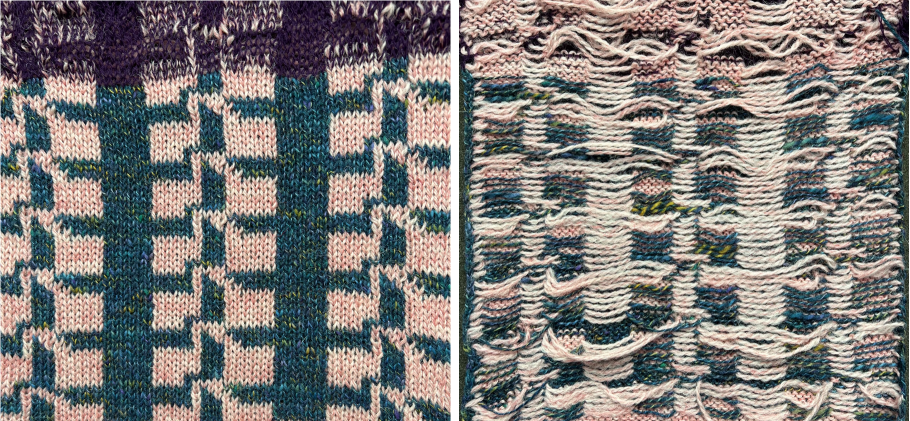 When knitting fair isle end needle selection is used to keep the yarn in the B feeder anchored so as to prevent any separations along the vertical edges of the design.
When knitting fair isle end needle selection is used to keep the yarn in the B feeder anchored so as to prevent any separations along the vertical edges of the design.
Here the light color is 2/8 wool. The yarn in the B feeder is switched to a 2/24 random contrasting color, and the knit carriage is set for thread lace. The white pixels knit both yarns together. Programming a blank row and knitting 2 yarns in this manner is considered by some an alternative to using the plaiting feeder.
End needle selection is canceled. If needles are brought forward, push at least one back to B so the combined yarns knit. In a long piece, a repeat in the width of the planned number of stitches could be planned with one or two blank pixel borders on vertical sides.
Due to the contrast in yarn thickness, the thin yarn creates large stitches that bulge in areas where it knits with the thicker yarn floating behind it, and the areas with combined yarns recede.
The areas in double thickness secure the yarn that produces floats, so that the latter may be trimmed on the purl side, leaving cut ends in any length. When cutting floats, consider sliding something under them and the thin knit so as to avoid cutting it as well, the fabric will release and flatten. 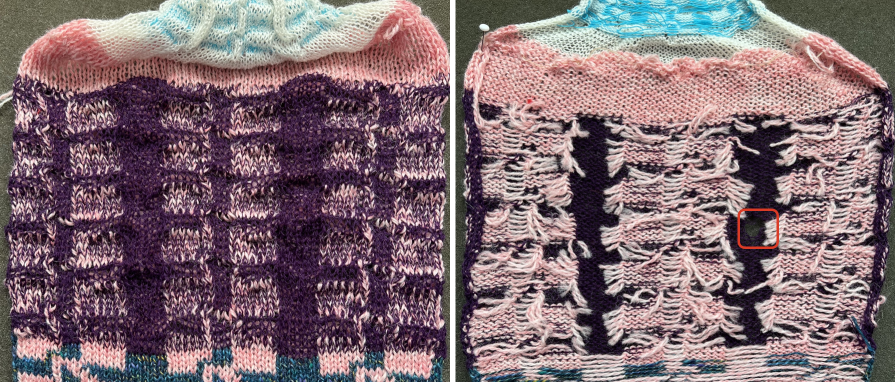 Using elastic, the background yarn used needs to be thinner, here a 2/20. The repeat program is left unchanged, but the position of the yarns is swapped so the elastic/ “thin” is placed in feeder A and the white/ “thick” in feeder B. There is a considerable change in size, observable at the top of the previous images.
Using elastic, the background yarn used needs to be thinner, here a 2/20. The repeat program is left unchanged, but the position of the yarns is swapped so the elastic/ “thin” is placed in feeder A and the white/ “thick” in feeder B. There is a considerable change in size, observable at the top of the previous images.  Aiming for float control, the repeat is edited.
Aiming for float control, the repeat is edited. 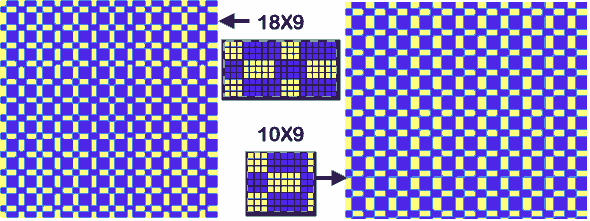 A test of the 18X9 repeat using the fair isle setting measures 6.5 inches in width,
A test of the 18X9 repeat using the fair isle setting measures 6.5 inches in width, 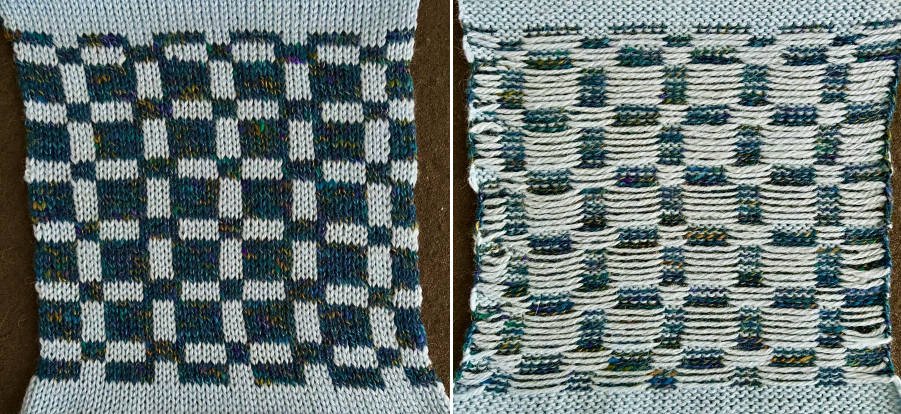 while the same stitch repeat knit using elastic and the thread lace setting adjustments once more, measures just under 2.5 inches in width
while the same stitch repeat knit using elastic and the thread lace setting adjustments once more, measures just under 2.5 inches in width 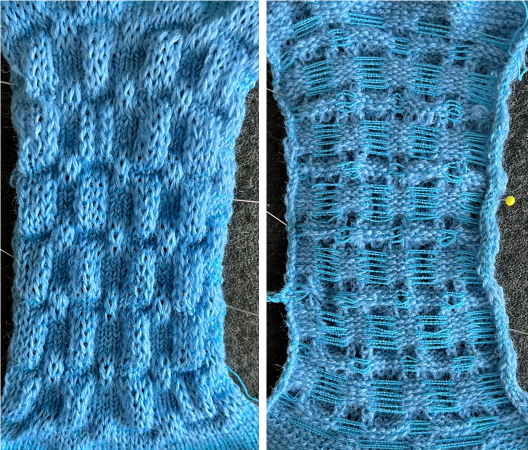
Category: Slip Stitches
More Truchet inspired tiles, a brief look at gradient filter use
The latest ArahPaint user manual download, updated on February 9, 2023, includes added directions for drawing in repeat including a truchet/Smith tile variant.
This post will not provide specific how-tos, the pngs can be downloaded and used to perhaps test Arah’s features or to aid in finding a personal, preferred method for manipulating DIY designs.
There are additional Arahpaint options for altering designs in width and height which may be used progressively on the same image. Some in the group of edits and rotations are evocative of the Passap console’s Alter programming loop.  Lower in the same menu, diagonal mirroring opens yet another series of possibilities.
Lower in the same menu, diagonal mirroring opens yet another series of possibilities. 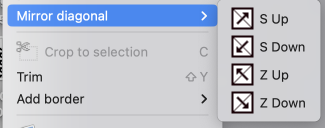 These samples were produced in a Passap workshop, using the console Alter, add commands. Note that mirrored areas have identical pairs of side-by-side pixels at their meeting points,
These samples were produced in a Passap workshop, using the console Alter, add commands. Note that mirrored areas have identical pairs of side-by-side pixels at their meeting points, 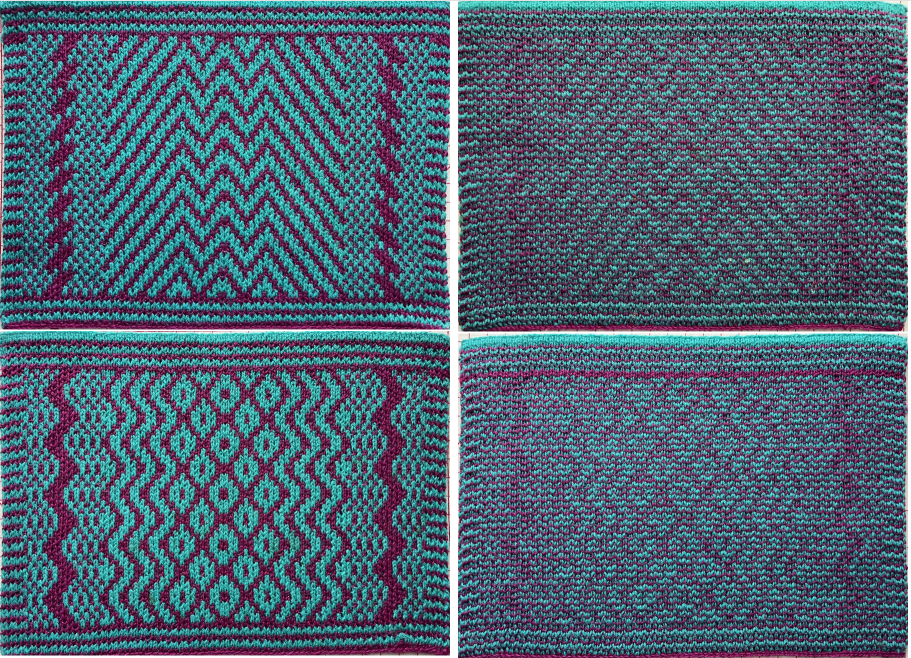 while ArahPaint offers an opportunity to change that, a thing to keep in mind when returning to simpler motifs such as those used for tuck stitch. Performing the rotations, however, will render the result with an odd number of pixels in width, often making them less likely to be usable in punchcard models
while ArahPaint offers an opportunity to change that, a thing to keep in mind when returning to simpler motifs such as those used for tuck stitch. Performing the rotations, however, will render the result with an odd number of pixels in width, often making them less likely to be usable in punchcard models  My area of interest has been primarily and still is in creating textures beginning with small repeats that may grow in complexity and size to make the structures programmable and thus easier to track and execute.
My area of interest has been primarily and still is in creating textures beginning with small repeats that may grow in complexity and size to make the structures programmable and thus easier to track and execute.
Presently I rarely engage in multiple color motif work ie fair isle or other large-scale textile pattern applications but my curiosity in applied techniques has led me down this potential giant rabbit hole.
The speed and ease of drawing variations for repeats using ArahPaint make the process addictive.
The source of inspiration for this design series is “The curse of truchet tiles”.
When recognizable circles are a goal, these tiled motifs often begin with starting sizes as wide as the 24-stitch standard punchcard repeat limitation, and the manipulated larger motifs are suitable only for electronic machine models capable of accepting software downloads. ![]()
![]()
![]()
 Adding lines and extra dots of circles
Adding lines and extra dots of circles
![]()

 Isolating fractions and individually rotating segments to draw again rendering larger repeats
Isolating fractions and individually rotating segments to draw again rendering larger repeats ![]()
![]()

![]()
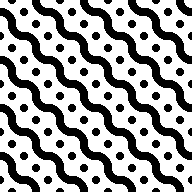 More info on knitting DBJ using more than 2 colors per row:
More info on knitting DBJ using more than 2 colors per row:
DBJ: more than 2 colors per row 3 3/22
Img2track_multiple colors per row dbj, each color knitting only once 1/21
DBJ: more than 2 colors per row 2 12/19
DBJ: more than 2 colors per row 1 12/19
Adding one more color to the last repeat whole planning a knitting a test at a max of 3 colors per row knittable in a single track
![]()
![]() The img2track window
The img2track window 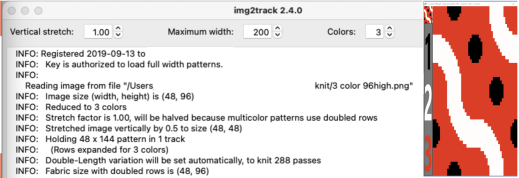 Positions of the respective yarns in the color changer as suggested by the program result in accuracy prompts by the machine on which of the respective colors should be in use at any one time.
Positions of the respective yarns in the color changer as suggested by the program result in accuracy prompts by the machine on which of the respective colors should be in use at any one time. 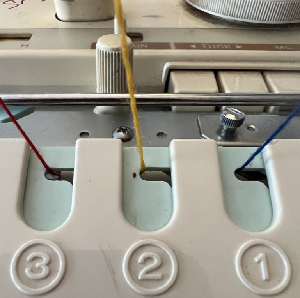 Planning gauge-dependent pieces using large repeats requires large test swatches, generally a minimum of 100 stitches by 100 rows.
Planning gauge-dependent pieces using large repeats requires large test swatches, generally a minimum of 100 stitches by 100 rows.
Adding and varying the colors in the design draft to match the yarns to be used in the repeat helps to visualize the possible result, and allows for using the sequence suggested by the download program to help track the proper color changes.
The test here is 60 stitches wide, knit one full repeat in height, measuring 7.5 inches in width by 11.75 inches in height after resting. On rows where the colors for the dots and squiggles may knit in small parts or not at all, there will be a preselection of large groups of needles such as seen here. 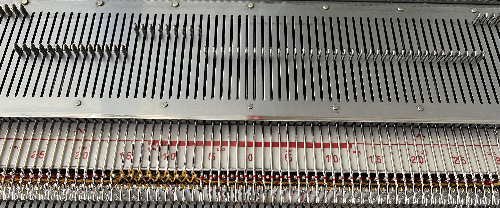 Birdseye setting is used to decrease motif lengthening. The img2track user manual describes the steps necessary for downloading to different model knitting machines and possibly using more than single tracks.
Birdseye setting is used to decrease motif lengthening. The img2track user manual describes the steps necessary for downloading to different model knitting machines and possibly using more than single tracks.  A series inspired by another of the tiles in the linked publication
A series inspired by another of the tiles in the linked publication
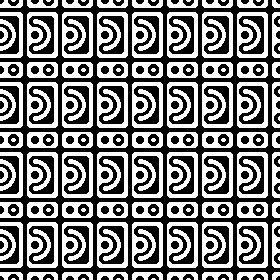
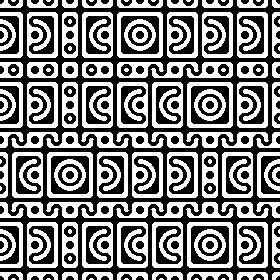
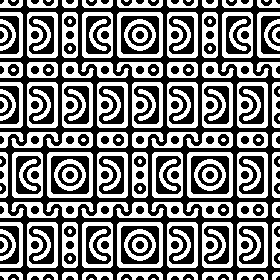
 Similar to one of the source repeats, increasing the balance between light and dark
Similar to one of the source repeats, increasing the balance between light and dark 
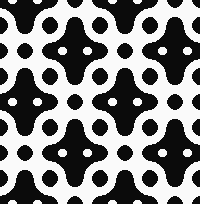 Open areas or specific rotations in the visual space may be created by eliminating or rotating individual segments.
Open areas or specific rotations in the visual space may be created by eliminating or rotating individual segments.
To change the mirroring type, place a mouse pointer over the arrow that you want to change, and press the left mouse button. The arrow will jump to the next mirror type. With only 5 mirror types, you will get what you want in a maximum of 4 clicks. If you press the right mouse button, it will put the arrow to the default orientation.  The result of course is dependent on the original file choice.
The result of course is dependent on the original file choice.  Combining duplicating repeat variations with drawing in repeat helps one develop a DIY library of favored tilings. Begin with a possible background
Combining duplicating repeat variations with drawing in repeat helps one develop a DIY library of favored tilings. Begin with a possible background 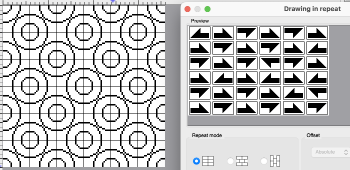
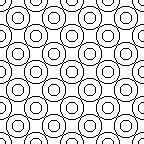 Tools/ Find Repeat
Tools/ Find Repeat ![]() Aiming for knot variations, a cross-over to add to segments of the ground, manipulating individual tiles, adding copy and paste
Aiming for knot variations, a cross-over to add to segments of the ground, manipulating individual tiles, adding copy and paste ![]()
![]()
![]()




 More play with manual duplication of tiles as opposed to drawing in repeat
More play with manual duplication of tiles as opposed to drawing in repeat  Combining different scale repeat segments, starting with 54X36 pixels
Combining different scale repeat segments, starting with 54X36 pixels ![]()

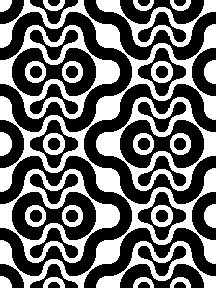 And it’s not all about just circles, a 36X36 pixel design to play with
And it’s not all about just circles, a 36X36 pixel design to play with ![]()
 A reminder, if the plan is to add color in continuous lines, it is best to place the colors after the full design repeat has been developed rather than on the individual starting tile segments, For some, this would be considered a design feature.
A reminder, if the plan is to add color in continuous lines, it is best to place the colors after the full design repeat has been developed rather than on the individual starting tile segments, For some, this would be considered a design feature.  A very different look may be achieved using any of the available filters. A square image of any size may be filled with a color gradient while keeping in mind the fact that knitting is very low resolution and the maximum number of available needles for patterning is 200 or under.
A very different look may be achieved using any of the available filters. A square image of any size may be filled with a color gradient while keeping in mind the fact that knitting is very low resolution and the maximum number of available needles for patterning is 200 or under.
Beginning with a 20-stitch file. ![]() Below the software tool options on the right, click on the tool in the area marked with the red shape
Below the software tool options on the right, click on the tool in the area marked with the red shape  to produce a design that may then in turn be drawn in repeat
to produce a design that may then in turn be drawn in repeat ![]()
![]() No edges were cleaned up in this view. The design meets the maximum 200 pixels/needles size
No edges were cleaned up in this view. The design meets the maximum 200 pixels/needles size 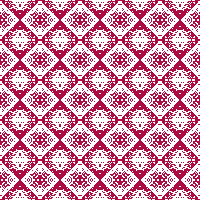 Going larger, an 80-pixel start to end with a 160-pixel blanket or tapestry suitable image with some wiggle room for adding a frame/border.
Going larger, an 80-pixel start to end with a 160-pixel blanket or tapestry suitable image with some wiggle room for adding a frame/border. 


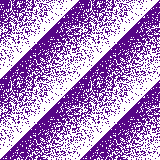
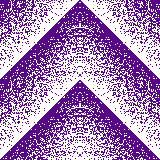 The concept may be used in various densities for use in an accessory such as a scarf,
The concept may be used in various densities for use in an accessory such as a scarf, 
 spaced and colored to your liking,
spaced and colored to your liking, 
 or even sweater bodies and sleeves planned specifically based on stitch and row counts for each of the pieces involved.
or even sweater bodies and sleeves planned specifically based on stitch and row counts for each of the pieces involved. 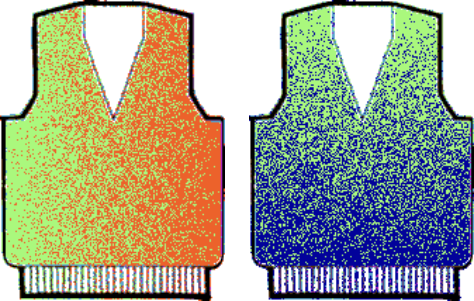 Filters may also be applied in developing other stitch structures in addition to working with color motif designs. That topic merits its own post.
Filters may also be applied in developing other stitch structures in addition to working with color motif designs. That topic merits its own post.
A “fast pattern” user guide shared by the ArahPaint 6 developer October 2023 which demonstrates how to use filters with associated designs https://www.arahne.eu/pdf/fastpattern-EN.pdf
Cross brand pattern interpretations: Dubied to Brother
Reviewing Brother carriages:  I am drawn to published pattern books for different brand machines at different periods of time and enjoy the puzzle of converting their designs to machines I have ready access to.
I am drawn to published pattern books for different brand machines at different periods of time and enjoy the puzzle of converting their designs to machines I have ready access to.
At this point in time most of my swatches are produced on a 930 using img2track to download files when needed while still making an attempt to share repeats usable on punchcard knitting machines when possible.
I have never been in the same space as a Dubied, but have been researching online trying to gather any information that might help me translate more of the patterns presented in the manual “for developing your hand and machine sampling”. These are my personal notes, not meant as accurate teaching tools, but shared to perhaps serve some use to others when decoding cross-brand pattern instructions.
Close to the completion of this post, I acquired the manual for the Dubied N4 model from a friend, with these images and some variations of the text. 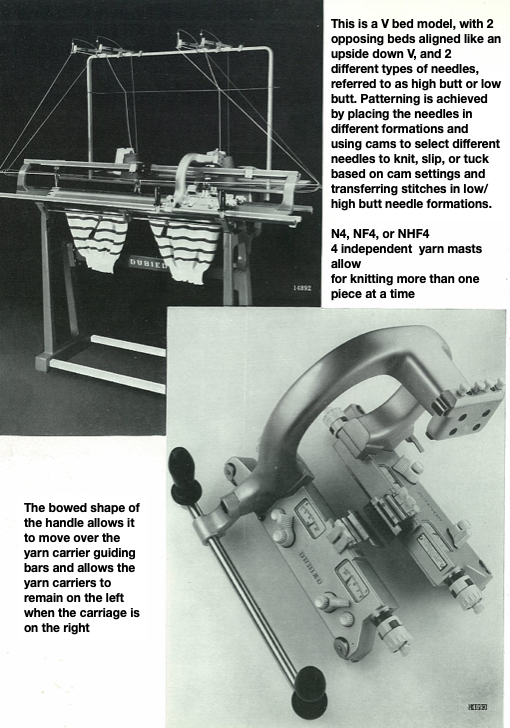 The associated tools from an online sale site:
The associated tools from an online sale site:  Manuals available online for free download
Manuals available online for free download
 Another source of inspiration for a different machine, Italian text only available, with many similar stitch structures:
Another source of inspiration for a different machine, Italian text only available, with many similar stitch structures:  The Coppo numbering for settings in a box format
The Coppo numbering for settings in a box format 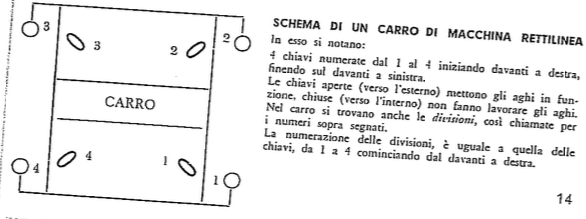 My initial attempts to develop an understanding of functions began with an illustration from the Dubied N4 parts manual
My initial attempts to develop an understanding of functions began with an illustration from the Dubied N4 parts manual  Some related functions, the term cardigan is used to refer to what many of us know as tuck stitch.
Some related functions, the term cardigan is used to refer to what many of us know as tuck stitch.  Visualizations of mirrored matching cam lever positions on opposite beds.
Visualizations of mirrored matching cam lever positions on opposite beds. 
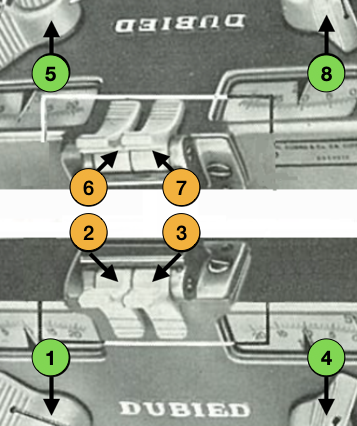
 These machines do not create patterns via punchcards, instead, cams inside the carriages are controlled by switches that alter stitch formations. They are classified by the inclusion of the following symbols
These machines do not create patterns via punchcards, instead, cams inside the carriages are controlled by switches that alter stitch formations. They are classified by the inclusion of the following symbols
N: equipped with rib and tube cams
F: equipped with cardigan cams for the execution of all tuck stitch fabrics
H: fitted with high and low butt needles. The raising cams operate either all the needles or high butt needles only. All machines with these needles are equipped with cam-plates allowing all the knit-and-tuck or all-tuck combination fabrics to be formed
4: 4 yarn carriers, which can be placed on either side and allow the manufacture of different pieces at once.
Basic rib structures are modified further by positioning needles in specific needle arrangements.
Functions and settings are often represented in manuals and publications in varied ways. The N4 manual supplement shows an undercarriage numbering system that uses a different sequence than my illustrations. The particular model introduced the addition of auto cams, allowing for alternate function patterning on needles in different positions. 
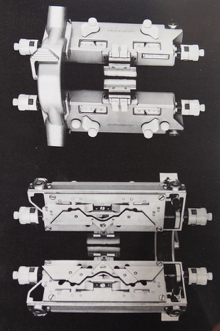
 I find it easier to think of settings on each bed separately, especially in cases where bed instructions also need to be reversed.
I find it easier to think of settings on each bed separately, especially in cases where bed instructions also need to be reversed.
This is my initial effort at illustrating comparisons between the Dubied and Brother settings for knitting specific swatches.
Any fabrics acting on stitches occurring on selective tuck or slip stitches on one or both beds would need to be programmed in Brother machines for patterning on the top bed. On the ribber, the use of lili buttons will automate card 1 needle selection in the pattern on an even number of needles, but in many instances, in executing the Dubied patterns, hand selection in specific needle arrangements may be required as often as every row.  Information from N4 pub after I had created the above, with additions and some paraphrasing: the numbering system for “keys and levers”
Information from N4 pub after I had created the above, with additions and some paraphrasing: the numbering system for “keys and levers” 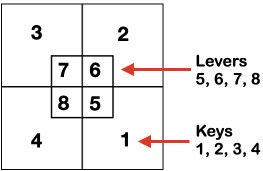 Key positions:
Key positions:
1. closed if turned toward the inside of the carriage, no rows will be knitted ie slip stitch in both directions for a free pass, no knitting, with no yarn using Brother
2. opened if turned toward the outside/ away from the carriage, rows will knit
3. central position for floating threads on the low-heel needles, knit/slip, programming for needle selection in upper work, Brother D, and lower, Brother B, or limited Brother ribber selections using lili buttons
Stitch size dials:
Numbering from 1-20, two on the front carriage, two on the rear carriage, three lengths can be set using the stitch size dial, indicated by three colors red, black, and green  (Cardigan) Levers: each lever can be positioned separately: pointing toward the outside of the carriages/ back: the space between them
(Cardigan) Levers: each lever can be positioned separately: pointing toward the outside of the carriages/ back: the space between them  neutral/middle: if activated will hold the thread on all needles (tuck loops across all needles in work)
neutral/middle: if activated will hold the thread on all needles (tuck loops across all needles in work) pointing toward the inside of the carriage/ forward: if activated will hold the thread (form tuck loops) on the low heel (non-selected needles in Brother)
pointing toward the inside of the carriage/ forward: if activated will hold the thread (form tuck loops) on the low heel (non-selected needles in Brother) Sliding unladen (no yarn) carriage/ free pass: made with keys 1, 2, 3, 4 closed/ Brother carriages set to slip in the direction of knitting
Sliding unladen (no yarn) carriage/ free pass: made with keys 1, 2, 3, 4 closed/ Brother carriages set to slip in the direction of knitting
Plain knit or any rib setting: Keys 1, 2, 3, and 4 open the carriages work on selected needles, levers facing outward/ Brother with both beds set for plain knitting
Combining knit carriage needle selection with racking 2017 and
A racking tale: Passap/Brother 3 in 2019 used this repeat as the springboard for textures that did not match the original in stitch and row counts or racking sequences. The racking handle position is referred to as up or down, similar to the Passap system. 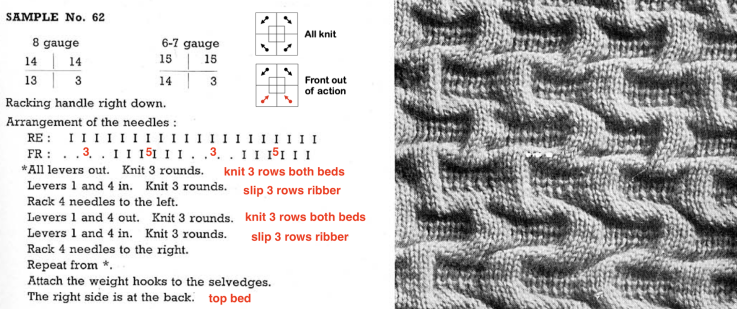 The ribber is used as the front bed.
The ribber is used as the front bed.
I initially interpreted a round as a single row of knitting and held onto that for a while, and my arrangement for needles in and out of work on either bed was reduced.
Sometimes there are good reasons why our swatches do not match the inspiration one, a bit like changing ingredients in a recipe and wondering why the result is different.
The first test: in practice, I was simply unable to get the ribber to rack by 4 positions after only 3 knit rows, the problem was solved by a change in the needle arrangement and racking by only 3 positions in either direction. Another option would have been to add more all-knit rows between racking sequences as seen in the subsequent Coppo machine pattern adaptation, creating deeper folds.
The tension was adjusted to the tightest possible and remained fixed with no variations on either bed.
The gauge is likely looser than that in the Dubied manual, forming larger stitches and resulting in a softer shape definition.
Brother tension adjustments can only be made on one dial on either carriage, while the Dubied offers multiple settings on both beds.
To knit manually changing ribber settings, cast on with racking position on 7.
After casting on and transferring stitches up to the top bed the needles are arranged as follows, blank cells represent needles placed out of work back to A position:  1. Knit 3 rows on both beds
1. Knit 3 rows on both beds
2. Set the ribber to slip in both directions, knit 3 rows on top bed only, and rack to position 10
3. Set the ribber to knit, knit 3 rows on both beds
4. Set the ribber to slip in both directions, knit 3 rows on top bed only, and rack back to position 7.
Repeat the 4 steps, ending with 3 knit rows before binding off.
Elongated stitches happen on the bed with needles out of work, in this case, the ribber, and the texture will appear on the knit side.
The needed racking positions become easy to identify as the knitting begins to grow. If one wishes to track hand techniques along with their respective row numbers and racking positions a spreadsheet can quickly be created including specifics ie in this case row counts, ribber settings changes, and racking positions: 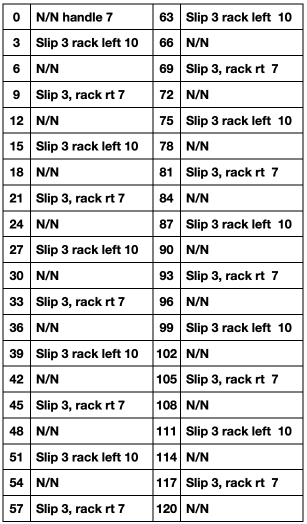 Automating the selection, and swapping beds make the process easier to track: begin on racking position 7, inverting the needle arrangement in order to keep the same racking sequence. Cancel end needle selection whenever any needles are out of work on the main bed and the knit carriage is set to slip in both directions. It is not always necessary, but a good habit to develop.
Automating the selection, and swapping beds make the process easier to track: begin on racking position 7, inverting the needle arrangement in order to keep the same racking sequence. Cancel end needle selection whenever any needles are out of work on the main bed and the knit carriage is set to slip in both directions. It is not always necessary, but a good habit to develop.  The width of the main bed is programmed using a repeat that has 3 rows of punched holes/black pixels, followed by 3 unpunched rows/white pixels repeated X2, for a total of 12 rows.
The width of the main bed is programmed using a repeat that has 3 rows of punched holes/black pixels, followed by 3 unpunched rows/white pixels repeated X2, for a total of 12 rows.  Emptied needles on the knit bed are pushed back out of work to the A position. All ribber needles are in the work position.
Emptied needles on the knit bed are pushed back out of work to the A position. All ribber needles are in the work position.
Needle preselection in Brother on the knit bed will not interfere with racking since ribber needles are continuously in the B position.
Cancel end needle selection, KCII, as in any fabric with slip stitch selection on the top bed combined with needles out of work.
After the repeat is programmed and the first preselection row has been made, racking will happen every 6 rows, first to position 10, and then back to 7.
Starting side does not matter unless color changes are intended on every even number of rows.
Elongated stitches happen on the bed with needles out of work, the texture will appear on the reverse side, where all needles are in work (NOOW). The blue is knit with NOOW and with setting changes on the ribber every 3 rows, while the yellow swatch is knit with the main bed programmed with NOOW and a 12-row repeat using the slip stitch setting in both directions.  When a round is interpreted as 2 rows of knitting, the carriages leave and return to the same side, color changes can be considered. The out-of-work/in-work needle arrangements now match the published counts, along with the repeat for knitting with the top bed set to slip and knit rather than the ribber. The method is the same as previously described.
When a round is interpreted as 2 rows of knitting, the carriages leave and return to the same side, color changes can be considered. The out-of-work/in-work needle arrangements now match the published counts, along with the repeat for knitting with the top bed set to slip and knit rather than the ribber. The method is the same as previously described.
Racking is now planned by four positions, and occurs every 12 rows once the needles are all preselected on the top bed, starting at racking position 6, to 10, and back to 6,  producing a swatch matching the original.
producing a swatch matching the original. 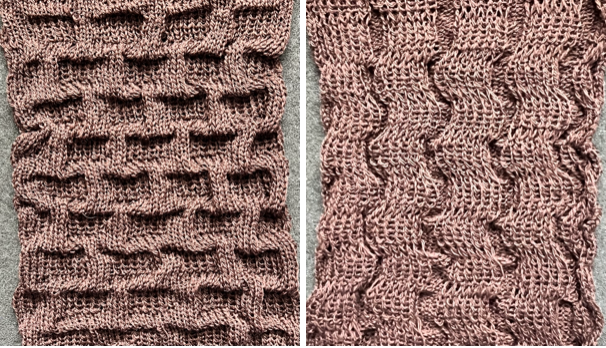
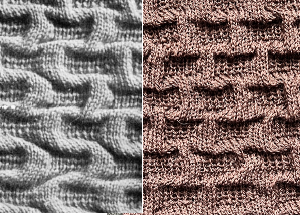 What about adding color changes? An easy place to change color is when the needle selection changes from slip to knit, with each color knitting for 6 rows, remembering to also rack after every 12 rows.
What about adding color changes? An easy place to change color is when the needle selection changes from slip to knit, with each color knitting for 6 rows, remembering to also rack after every 12 rows.
The brown yarn was hard to see clearly on the needle bed. When off the machine there were interesting unplanned areas of dropped stitch lace where dropped stitches on the top bed had been missed.
Tabling the idea of adding other colors to this particular pattern, at least for now, but never say never in knitting (and baking).  And then there is this related pattern in the manual that involves racking by 4 positions and deliberately dropping stitches
And then there is this related pattern in the manual that involves racking by 4 positions and deliberately dropping stitches  With some experience needle setups can be varied to suit, while achieving the same results as published illustrations.
With some experience needle setups can be varied to suit, while achieving the same results as published illustrations.
I prefer to start with racking to left, as a result, the shapes in my swatches are mirrored horizontally when compared to those in the manual’s photo.
There are ways to make casting-on quick for testing small swatches when permanent edging starts do not matter.
One method to do so was described in the post: Ribber cast on comb/ open stitch single bed cast-on and was used here.
Ribber cast on combs traditionally came in different colors. I happened to try to use one of my grey ones presumably a Studio 4.5 mm one and found the spaces between its teeth not matching that between my Brother machine needles evenly. There were no issues when using the “silver” Brother comb. Here it is shown in position, with stitches cast only on the top bed,  and picking up loops for stitches on the ribber as the carriages travel to the opposite side.
and picking up loops for stitches on the ribber as the carriages travel to the opposite side.  The plan is to move ribber stitches to the left by two positions three times before returning them to their original position.
The plan is to move ribber stitches to the left by two positions three times before returning them to their original position.
The ribber carriage is set manually to knit on dark yarn rows and to slip on light yarn rows.
The ribber setting “song”: light/ slip levers up, dark / slip levers down.
The dark forms the dropped stitch lace pattern, it is thinner than the light yarn and the knit steams fairly flat.
Stitches are dropped by disconnecting the ribber carriage and making passes with no yarn, first to drop the stitches, and then to couple it once more with the knit carriage to continue knitting. 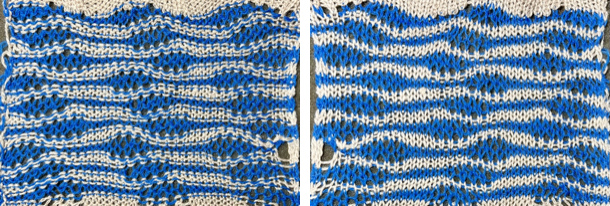 Automating the pattern, switching beds: program a 12-row repeat for 2 rows slipped, 2 knitted across all needles in work.
Automating the pattern, switching beds: program a 12-row repeat for 2 rows slipped, 2 knitted across all needles in work.
Note to self, when you swap beds and the ribber is forming all the knit stitches, do not use the ribber carriage to drop all the stitches on it!
Both yarns here are thin, and steam/press fairly flat.
If a ribber cast on for every other needle is used, remember to change the pitch from P to H after the transfers between the beds have taken place. A check to confirm that indeed needles will not smash into each other is quick to perform and well worth doing before continuing.
My needle arrangement: 
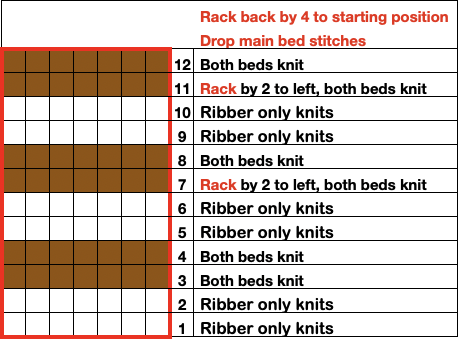

It is interesting that the swatch photographs accompanying directions in the Coppo manual are not “perfect”, some showing pattern adjustments or even sporting holes not part of the design. This texture is very similar to the above
 I initially interpreted 4 rounds as meaning 4 rows of knitting.
I initially interpreted 4 rounds as meaning 4 rows of knitting.
The resulting adaptation: cast on with the racking indicator on 6. The red numbers illustrate the guide provided in the publication and the bold black count adjustments in the actual knitting of the pattern. if attempting to match the original the 6 rows knit on the top bed should actually be 8 prior to racking.
The racking handle is set to 6
1. Knit 4 rows on both beds
2. Knit 4 6 rows on the top bed only
Rack by 4 positions, no direction given, I chose left to 10
3. Knit 4 rows on both beds
4. Knit 4 6 rows on the top bed only
Rack by 4 positions, I chose right to 6
Repeat steps 1-4
The elongated, slipped stitches are formed on the ribber, the bed with needles out of work, and the texture will appear on the knit side.
In any racking, the ribber bed may move beyond the stitches on the knit bed as the carriages move past the needles originally cast on and past the end stitch on one side or the other. This can help create some interesting side edgings.
That said, the first test swatch is knit changing ribber settings from knit to slip. If all needles are in work and the slip stitch setting is used, a float will be formed on the ribber if it has moved beyond the last needles in work on the opposite bed until the yarn reaches the stitches on the main bed as well.
It will not be an issue if stitches on that side are transferred up to the main bed. 
 Automating the process, the beds are reversed, the repeat is now 20 rows high, and the knit carriage will be set to slip in both directions.
Automating the process, the beds are reversed, the repeat is now 20 rows high, and the knit carriage will be set to slip in both directions.  The needle setup matches that given by the manufacturer.
The needle setup matches that given by the manufacturer. ![]() Empty needles are pushed back to the A position after transfers.
Empty needles are pushed back to the A position after transfers.
Racking happens every 10 rows, just after every needle in work preselection on the main bed. 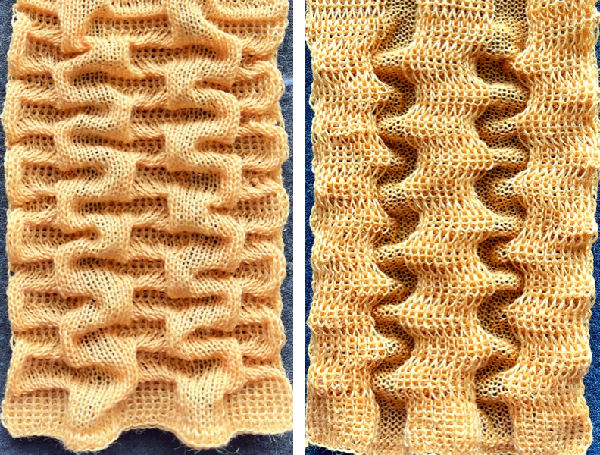 This pattern utilizes the cardigan/tuck function and requires thicker yarn. The wool used here is a 2/8 weight, knit at as tight tension on the ribber as possible, in this case, 6. Here the instructions for knitting include references to specific numbers of rows rather than rounds.
This pattern utilizes the cardigan/tuck function and requires thicker yarn. The wool used here is a 2/8 weight, knit at as tight tension on the ribber as possible, in this case, 6. Here the instructions for knitting include references to specific numbers of rows rather than rounds. ![]()

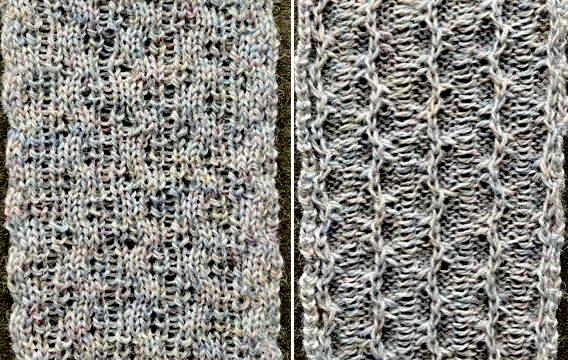 I was unable to reproduce anything like this sample in the manual with the illustrated needle arrangement, revised it.
I was unable to reproduce anything like this sample in the manual with the illustrated needle arrangement, revised it.
 The revised needle arrangement allowed for forming a vertical single-stitch column as in the swatch, and the racked patterns occurred at the center of a purl ground.
The revised needle arrangement allowed for forming a vertical single-stitch column as in the swatch, and the racked patterns occurred at the center of a purl ground.
The swatches are knit in different wool weights. Racking happened by 2 positions after each round/ pair of knit rows, starting side did not matter. 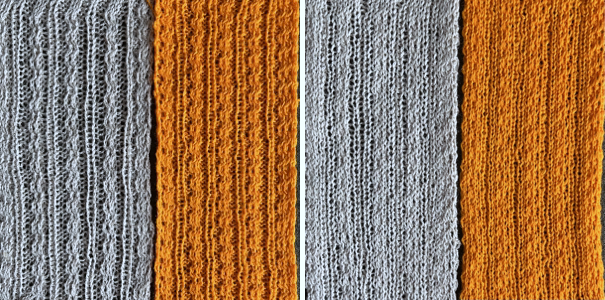 The above were knit using the slip stitch setting.
The above were knit using the slip stitch setting.
Reviewing the manual once more, it was noted that the sample was in the center of a page with the heading: racked fabrics in the cardigan/ tuck stitch. The stitch formations using tuck stitch on alternating Brother and Passap beds are reviewed in the post on Fisherman and English rib.
No specific lever or key instructions were provided. The general advice given to knit the cardigan aka fisherman’s rib is to start with the Dubied carriage on the right, all keys open, and push lever 8 (front left) and lever 6 (rear right) to a neutral position (9). In the outward direction, the carriage knits along the rear needle bed and holds the thread on all the needles of the front needle bed; on the return, it alternates the processes, a tubular tuck.
On Brother, it would be done by selecting opposite tuck buttons, making either the selections on the left or on the right 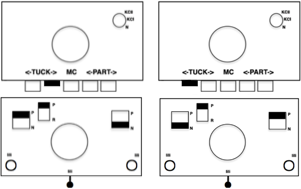 That is simply not happening with the pattern needle arrangement on a Brother machine, there are not enough stitches on opposing beds to anchor down tuck loops.
That is simply not happening with the pattern needle arrangement on a Brother machine, there are not enough stitches on opposing beds to anchor down tuck loops.
Half fisherman, aka English rib, tucks on every needle in work on one pass and knits every needle on the same bed on the return pass.
The new swatch is knitted using the same modified needle arrangement as added to the photo from the manual, starting from the right, with the ribber carriage set to tuck to left, knit to right, and the main bed set to knit every needle. 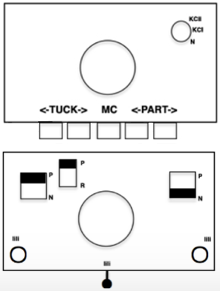 The swatch is shown in progress on the machine with needle placement as it would appear in the starting setup prior to knitting 2 rows.
The swatch is shown in progress on the machine with needle placement as it would appear in the starting setup prior to knitting 2 rows.
The first row tucks on ribber needles when traveling to the left, the second knits on them when returning to the right, followed by racking 2 positions to the left.
Two more tuck/knit rows are followed by racking by two positions back to the right, in the starting needle arrangement.


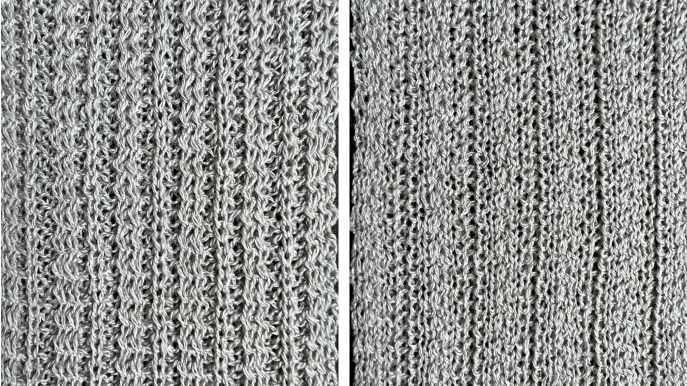 The manual image is shown on the left, and the Brother swatch, mirrored horizontally, is shown on the right.
The manual image is shown on the left, and the Brother swatch, mirrored horizontally, is shown on the right. 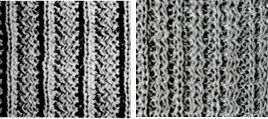 The following Dubied knit was particularly interesting to me and reminded me of this sample knit single bed in a previous post.
The following Dubied knit was particularly interesting to me and reminded me of this sample knit single bed in a previous post. 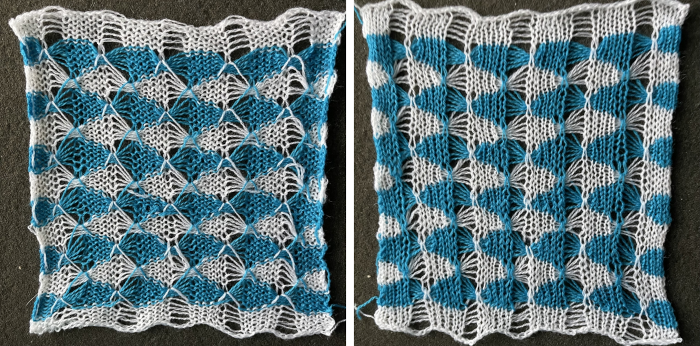 Autocams are drum pattern devices that attach in pairs to the Dubied carriage that modify the stitches much like a punchcard would. It is a drum with pegs of different sizes and positions which rotates with a pass to the opposite side. The cams are selected by fingers. The description is evocative of the Passap needle pattern selection in response to its pusher placements.
Autocams are drum pattern devices that attach in pairs to the Dubied carriage that modify the stitches much like a punchcard would. It is a drum with pegs of different sizes and positions which rotates with a pass to the opposite side. The cams are selected by fingers. The description is evocative of the Passap needle pattern selection in response to its pusher placements.
To execute this swatch, the top bed was programmed with a repeat suitable for punch card machines.
Guilloche fabrics are made with rows of stitches where tuck and knit stitches are combined and alternated for multiple fixed needle selection rows.
The working theory on converting the published instructions:  While the program eliminates having to change cam buttons manually on the top bed, the ribber settings need to be changed with each color change.
While the program eliminates having to change cam buttons manually on the top bed, the ribber settings need to be changed with each color change.
The tucks happen on both beds for 6 rows, so it is a necessity that any Brother sampling is knit using thin yarns. Here the dark is a 2/20 wool, and the light is a 2/28 unknown fiber, possibly acrylic, knit at tension 4 on both beds.
End needle selection is on, KCI.
The repeat is 12 rows in height.
Color changes and carriage settings happen every 6 rows.
The first preselection row is toward the color changer, the design will begin with a tuck pattern on the top bed and the ribber set to knit. 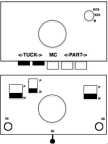 On completion of the first 6 rows, COL, every needle on the top bed will have been preselected to the D position, the warning that a color carriage setting changes are due before continuing to knit. The top bed remains set to tuck but will subsequently knit every needle. The ribber needs to be manually set to tuck in both directions.
On completion of the first 6 rows, COL, every needle on the top bed will have been preselected to the D position, the warning that a color carriage setting changes are due before continuing to knit. The top bed remains set to tuck but will subsequently knit every needle. The ribber needs to be manually set to tuck in both directions.  Upon completion of the 12-row repeat, with COL once more, the top bed will have been preselected in the tuck pattern, the warning that color and carriage setting changes are due before continuing to knit.
Upon completion of the 12-row repeat, with COL once more, the top bed will have been preselected in the tuck pattern, the warning that color and carriage setting changes are due before continuing to knit.
The ribber is set to knit once more, and the process is repeated.
Two views of the needle setup: 
 A small proof of concept
A small proof of concept  One from the Italian language supplement:
One from the Italian language supplement:  For this fabric, the ribber needles need to be manually selected for every other pair of rows. Needle selections on the top bed provide clues as to what the settings should be on the ribber as in the previous swatch.
For this fabric, the ribber needles need to be manually selected for every other pair of rows. Needle selections on the top bed provide clues as to what the settings should be on the ribber as in the previous swatch.
The top bed is programmed with a repeat suitable for punchcard machines ![]() The needle arrangement was set up as given. The end needle selection is on, set to KCI.
The needle arrangement was set up as given. The end needle selection is on, set to KCI.
The main bed remains set to tuck in both directions.
The colors and settings on the ribber are both changed after each 2-row sequence.
The ribber needles need to be manually selected with 1 needle up to the E position for knit stitches followed by 2 needles in the B position for tuck stitches repeating across the knitting width.
The ribber settings also need to be changed and set to tuck in both directions so that the needle selection will knit on the “high”, and tuck on the “low” needles as in the Dubied.
When the two ribber tuck rows have been completed, with the next color change, COL, the ribber carriage is set to knit in both directions once more and patterning reverses beds. 
A simple plaid idea using the slip setting: the 32-row repeat shown on the far right was programmed, and color changes happen after altered preselection on the top bed.
The dominant color (white cells) knits on all needles, while the contrast (dark cells) knits on the ribber only while stitches skipped on the top bed become elongated as they are skipped. 
 Things to consider:
Things to consider:
A. when first changing colors, the yarn may drop the first few stitches or for other reasons even drop a whole row. If the knitting is started on waste yarn prior to any permanent cast-on for the piece, one can insure that color changes happen properly and asses the proper tensions for the yarn used on the specific needle arrangements.
B. the ground color in this instance is changed after 16 rows, the contrast at far shorter intervals. Lengths will form on the color changer side of each contrasting color. They can be intentionally lengthened further so that at the completion of the piece they may in turn be cut, resulting in yarn ends long enough to be woven into the rib. If doing so, make certain those first few stitches after the color change form properly. There are other ways to handle yarn loops and ends like these, test any favorite on long enough swatches first.
C: all rib areas will be slightly wider than those where only a single bed knits
D: in the areas where only a single bed knits there will be some narrowing. 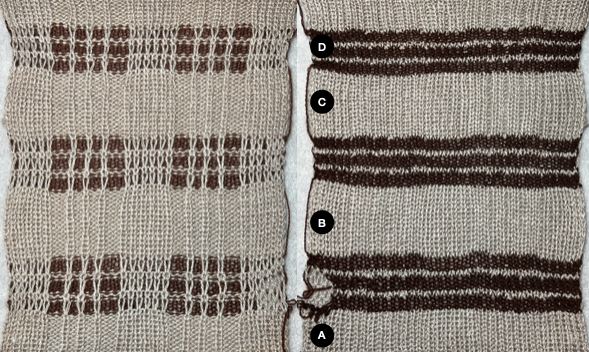 Revisiting Large eyelet lace, hand transferred (or not) 2013
Revisiting Large eyelet lace, hand transferred (or not) 2013
 It would appear the original cast-on for this is performed on the double bed with transfer to the front of all rear stitches.
It would appear the original cast-on for this is performed on the double bed with transfer to the front of all rear stitches.
To duplicate in Brother, cast on every other needle, and transfer all stitches to the knit, top bed, or cast on the top bed. The fabric benefits from the use of even weight.
This sample uses 2/8 wool, tension 8. The setup was changed slightly, resulting in empty needles at alternating side edges.
Planning out the repeats on a multiple of 4+2
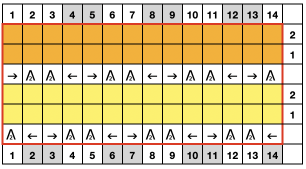 The edge stitch is moved as well. As recommended in the instructions, all empty needles are left in work position B or pushed to E prior to knitting the next row. Knit one round translates to knit 2 rows, which happens after each row of transfers, the carriage will move from and return to the same side.
The edge stitch is moved as well. As recommended in the instructions, all empty needles are left in work position B or pushed to E prior to knitting the next row. Knit one round translates to knit 2 rows, which happens after each row of transfers, the carriage will move from and return to the same side.
The swatch in progress, watch for any loop formation on either side: 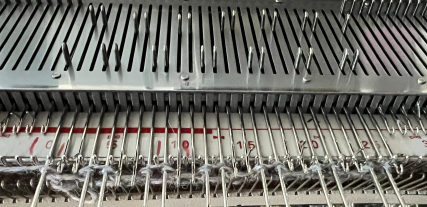 As with any time in knitting when there are 2 side-by-side empty needles, the loops on those needles will not form stitches, but rather, ladders with each carriage pass.
As with any time in knitting when there are 2 side-by-side empty needles, the loops on those needles will not form stitches, but rather, ladders with each carriage pass. 
 The transferred stitches have been knit for 2 rows, so the transfers are made again of single stitches onto the loops on either side of them, securing the loops before knitting continues. Here there is an empty needle on the far left,
The transferred stitches have been knit for 2 rows, so the transfers are made again of single stitches onto the loops on either side of them, securing the loops before knitting continues. Here there is an empty needle on the far left,  and here on the far right
and here on the far right  The resulting swatch, with a dropped stitch I missed on a row shortly after casting on
The resulting swatch, with a dropped stitch I missed on a row shortly after casting on  Before binding off, after a single row is knit, drop one of the double loops, insert a single eye tool back to front, turn it clockwise, and lift the result onto the now empty needle, essentially creating an e-wrap. Work across the row, knit at least 2 rows, and bind off loosely.
Before binding off, after a single row is knit, drop one of the double loops, insert a single eye tool back to front, turn it clockwise, and lift the result onto the now empty needle, essentially creating an e-wrap. Work across the row, knit at least 2 rows, and bind off loosely.
Truchet/Smith inspired designs 2 meet ArahPaint
Added explorations of the Smith tiles.
Most common knitting machines capable of accepting electronic pattern downloads have a number of needles ranging between 180 and 200 on either of the available beds.
Punchcard machines have a 24-stitch constraint in width for repeats that are selected in fixed locations on the top bed, while height row counts can be endless if one keeps joining punchcards together.
The narrow repeat width does not allow for impactful tiling such as seen in the truchet variants.
A 24-stitch initial repeat can be created, but will not align properly ie. here:
the 24X56 png, ![]() colored in and repeated in width and height X3.
colored in and repeated in width and height X3.  It can, however, be drawn in repeat using ArahPaint to produce a new and successful design repeat ie this 48X112 pixels version
It can, however, be drawn in repeat using ArahPaint to produce a new and successful design repeat ie this 48X112 pixels version ![]() and its appearance in repeat on a larger canvas:
and its appearance in repeat on a larger canvas: 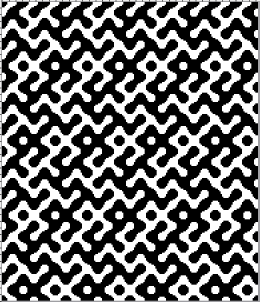 Electronic machines can be used to knit large, non-repetitive designs based on the number of needles available on their beds.
Electronic machines can be used to knit large, non-repetitive designs based on the number of needles available on their beds.
Unless knit-from-screen software is used, the size of the files downloaded to specific machine models varies depending on both the software used and the knitting machine’s available memory.
One of the issues using online generators as seen in the previous post is that the files tend to be high in pixel counts and rendered in RGB mode.
Changing image modes to BW indexed and scaling the large design to a smaller version have an effect on the edge definition of the shapes and are likely to require clean-up to remove or add pixels.
Beginning with small and clearly defined forms, tiling repeatedly to larger ones will allow for results that can be cropped to specific sizes with clean edges along the secondary shapes.
Beginning the proposed method with the Smith tile, a place to start is to choose the smallest successful circular forms.
The repeat works using quarter squares, so the file size needs to be an even number of pixels in width and height.
Getting a sense of the appearance of the edges of small circular shapes, with the intent of choosing one for fabric development, beginning with an 8-pixel diameter, and increasing it in turn by 2 pixels at a time to 20.  The 8-pixel circle is chosen for this exercise.
The 8-pixel circle is chosen for this exercise.
Following the steps outlined by the developer in the video viewable on Instagram and Facebook, open a new picture, and set the image size to 8X8 pixels 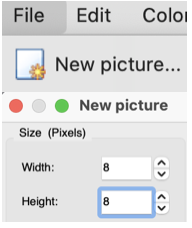 The goal is to create a clean design outline forming shapes that may be filled in to yield the secondary tiling designs.
The goal is to create a clean design outline forming shapes that may be filled in to yield the secondary tiling designs.
To zoom in or out in ArahPaint: use Shift+ or – on Mac, click on the magnifying lens icons in the toolbox,  use the command key and roll the mouse wheel or scroll along the vertical center line of the mouse, or press any number from 0-9 on the keyboard to change zoom directly to that level (1 means 100%, 6 means 600%, O means 1000%).
use the command key and roll the mouse wheel or scroll along the vertical center line of the mouse, or press any number from 0-9 on the keyboard to change zoom directly to that level (1 means 100%, 6 means 600%, O means 1000%).
In RGB mode even if the shapes are drawn in black, when converted to indexed BW some pixels will be lost. If any lines are broken, control in using the bucket fill tool on only selected areas is lost.
To begin with, set the number of colors and the pencil size to one pixel 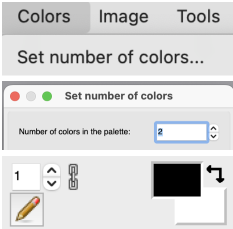 Use the draw circle tool, and select drawing from the center
Use the draw circle tool, and select drawing from the center 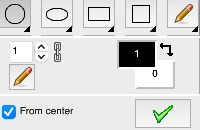 Draw a quarter circle starting on the bottom right of the square, and ending in the center of this image. In this case, there will be 4 white pixels on the left of the line, half the diameter of the planned circle. Click on the pencil tool to set the image.
Draw a quarter circle starting on the bottom right of the square, and ending in the center of this image. In this case, there will be 4 white pixels on the left of the line, half the diameter of the planned circle. Click on the pencil tool to set the image. 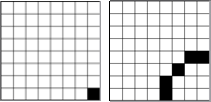 Repeat the Process, drawing a mirrored image beginning on the upper left pixel position, and ending in the center of the image as well
Repeat the Process, drawing a mirrored image beginning on the upper left pixel position, and ending in the center of the image as well  Open the drawing in the repeat window
Open the drawing in the repeat window 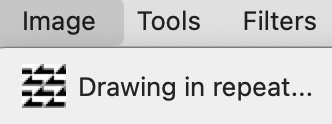 and set the number of repeats vertically and horizontally, done here first in standard alignment. Do not click on random, select new picture, OK. If satisfied, save the png.
and set the number of repeats vertically and horizontally, done here first in standard alignment. Do not click on random, select new picture, OK. If satisfied, save the png.  Undo may be used to revert to the original file unless new picture was left unchecked.
Undo may be used to revert to the original file unless new picture was left unchecked.
For the Smith tile repeat, do click on random to apply different rotations of the repeat.
Load the 8X8 file
Zoom out to check the pattern and view changes adequately
Open the draw in repeat window
Click on random, and the proposed rotations will appear as symbols,  click on new picture and then on OK to view the result, a file that will now be 32X48 pixels. The result can be saved.
click on new picture and then on OK to view the result, a file that will now be 32X48 pixels. The result can be saved. ![]() To preview other arrangements:
To preview other arrangements:
choose undo, return to draw in repeat, random, preview, and with each repeated click on random a new image will appear on the screen. ![]() At any point select a new picture, OK, and save the result.
At any point select a new picture, OK, and save the result. ![]() The final png for test knitting for my test swatch
The final png for test knitting for my test swatch ![]() Its segments bucket filled with black
Its segments bucket filled with black ![]()
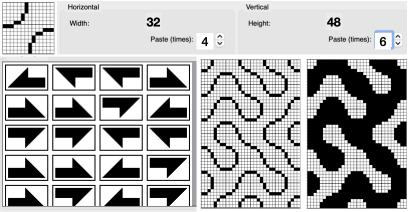 If bucket fill fails selectively and floods the whole image, return to drawing in repeat and click on close. Return to the image and continue the fill-in process.
If bucket fill fails selectively and floods the whole image, return to drawing in repeat and click on close. Return to the image and continue the fill-in process.
Developing a larger repeat to select an area of interest while keeping in mind the maximum needle width of 200. This repeat is perhaps usefully cropped to blanket size.  Seeking a shorter and narrower motif for a scarf, in the range of 60 to 100 pixels in width that may not require too many tracks when programming the 930, the same 32X48 design is drawn in repeat X4 in width, X2 in height to 128X96 pixels.
Seeking a shorter and narrower motif for a scarf, in the range of 60 to 100 pixels in width that may not require too many tracks when programming the 930, the same 32X48 design is drawn in repeat X4 in width, X2 in height to 128X96 pixels.  The above is split directly in half vertically for this exercise, rendering two files, each composed of 64X96 pixels. The left half,
The above is split directly in half vertically for this exercise, rendering two files, each composed of 64X96 pixels. The left half,  and the right
and the right  Checking vertical alignments
Checking vertical alignments 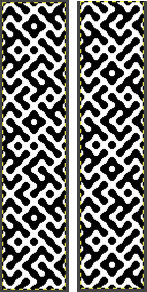 and committing to the one on the right for the test swatch, knitting on 60 stitches for 120 design rows, using KCI, and starting with dark color from left.
and committing to the one on the right for the test swatch, knitting on 60 stitches for 120 design rows, using KCI, and starting with dark color from left. 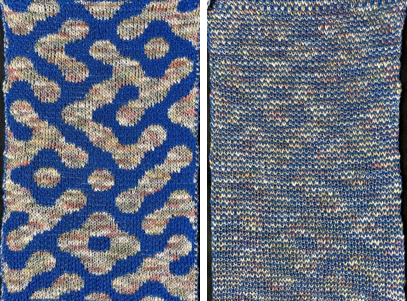 That shape in blue that looks almost rectangular is actually not quite circular in the repeat, seen here color-reversed on the bottom right, with the definition also slightly lost in the knit due to the stitch size and birdseye stitches twist.
That shape in blue that looks almost rectangular is actually not quite circular in the repeat, seen here color-reversed on the bottom right, with the definition also slightly lost in the knit due to the stitch size and birdseye stitches twist.  Comparing the 3 swatches in scale and shape definition:
Comparing the 3 swatches in scale and shape definition: 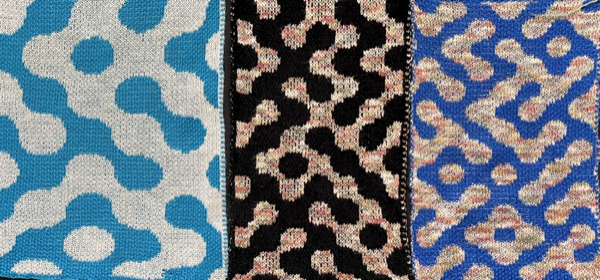 A tiny repeat formed with a thicker line
A tiny repeat formed with a thicker line 
![]() Drawn in random repeat
Drawn in random repeat 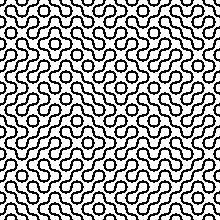 Dividing shapes into symmetrical segments is easy after configuring grid properties, in this case into thirds
Dividing shapes into symmetrical segments is easy after configuring grid properties, in this case into thirds  12X12 in repeat
12X12 in repeat  adding an outline to change the weight of the lines by a single pixel all over without using more specific options
adding an outline to change the weight of the lines by a single pixel all over without using more specific options 
 Using the filled in double circle
Using the filled in double circle  18X18 repeats
18X18 repeats ![]()
![]() drawn in repeat
drawn in repeat  While the definition of true circular shapes may be an issue for some when knitting the Smith variant, others may enjoy variations made by playing with other shapes and angles, here a 16-pixel square was divided into quarters
While the definition of true circular shapes may be an issue for some when knitting the Smith variant, others may enjoy variations made by playing with other shapes and angles, here a 16-pixel square was divided into quarters 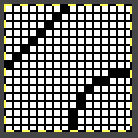
![]()
 adding a single pixel contour
adding a single pixel contour  combining quarter circles sith full squares
combining quarter circles sith full squares 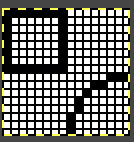
![]()
 Building larger repeats with interwoven intersections
Building larger repeats with interwoven intersections ![]()

![]()

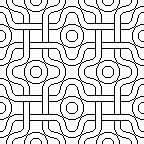 Playing with adding colors. In many instances when tiles are drawn in repeats requiring rotations of the original file, coloring in needs to be done after the final image has been composed.
Playing with adding colors. In many instances when tiles are drawn in repeats requiring rotations of the original file, coloring in needs to be done after the final image has been composed. 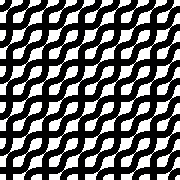
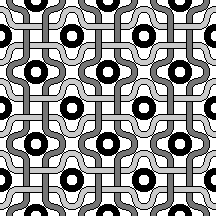
 Color exchanging fine black outlines to white, or filling the white background with black in order to reduce files for knitting no more than 3 colors per row.
Color exchanging fine black outlines to white, or filling the white background with black in order to reduce files for knitting no more than 3 colors per row. 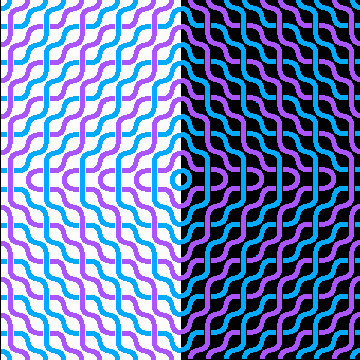 The more complex designs become exponentially larger, require electronic downloads, and must meet the limitations of machine memory. The maximum equivalent for pixel per stitch is 200 pixels in width on 4.5 mm knitting machines, and 180 for Passap, with the possibility of separating the width and length into panels for large pieces ie tapestries, or blankets. Long vertical design segments, depending on their height, may also need to be separated in steps for programming them to produce narrow, long, pieces such as scarves or shawls.
The more complex designs become exponentially larger, require electronic downloads, and must meet the limitations of machine memory. The maximum equivalent for pixel per stitch is 200 pixels in width on 4.5 mm knitting machines, and 180 for Passap, with the possibility of separating the width and length into panels for large pieces ie tapestries, or blankets. Long vertical design segments, depending on their height, may also need to be separated in steps for programming them to produce narrow, long, pieces such as scarves or shawls.
The truchet triangles pose a different issue in knit design.
Quilters are familiar with block designs easily found in print and online that technically may be broken down into triangular blocks joined and meeting to form sharp points. 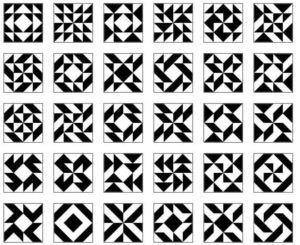 Truchet in his publication used half-square triangles
Truchet in his publication used half-square triangles 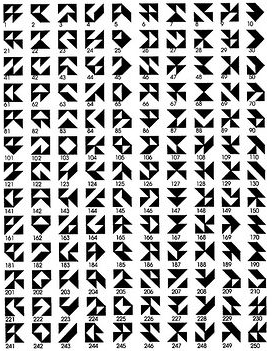 and assigned letters to the segments,
and assigned letters to the segments,  providing alphabetical references in illustrations for the permutations,
providing alphabetical references in illustrations for the permutations,  all far easier to achieve nowadays with the aid of software.
all far easier to achieve nowadays with the aid of software.
In ArahPaint, begin with choosing a square size, in this instance, 8 pixels by 8 pixels, matching that in the exercise using circles, and draw a triangle filling the canvas from corner to corner ![]() Drawing in repeat, the choice is made to repeat the triangles twice in both width and height, the preview symbols for the rotations of the shape are illustrated pointing in the same direction by default.
Drawing in repeat, the choice is made to repeat the triangles twice in both width and height, the preview symbols for the rotations of the shape are illustrated pointing in the same direction by default. 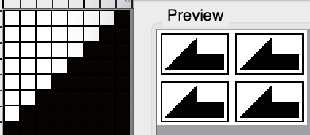 Clicking on any of those half-arrow shapes will rotate the specific shape in the tiled design, this becomes an action that may be influenced manually.
Clicking on any of those half-arrow shapes will rotate the specific shape in the tiled design, this becomes an action that may be influenced manually.  Selecting new image will render this,
Selecting new image will render this, 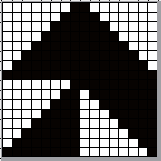 which illustrates what happens when those triangles are used in knit motif designs. Inevitably, there will be areas where corner pixels meet to join others and the choice will need to be made between using the original or the color-reversed version of the repeat.
which illustrates what happens when those triangles are used in knit motif designs. Inevitably, there will be areas where corner pixels meet to join others and the choice will need to be made between using the original or the color-reversed version of the repeat. ![]() Designing for a maximum 200-pixel design, the number of available needles on Japanese knitting machines, and continuing with random selections, paste 25 times in each direction, ultimately saving one of the new images:
Designing for a maximum 200-pixel design, the number of available needles on Japanese knitting machines, and continuing with random selections, paste 25 times in each direction, ultimately saving one of the new images:
 its color reversed version
its color reversed version  Deciding on the first, an isolated area can be cropped to be used in an accessory ie a 72-stitch scarf, retaining full triangles, using the full 200-pixel height.
Deciding on the first, an isolated area can be cropped to be used in an accessory ie a 72-stitch scarf, retaining full triangles, using the full 200-pixel height.  Wanting to retain a 96-row max height for use on the 930, what happens when repeats line up vertically? the isolated 72X96 design
Wanting to retain a 96-row max height for use on the 930, what happens when repeats line up vertically? the isolated 72X96 design  The assumption is that any change in vertical simple repeats will line up forming new triangles at the intersections not visually interpreted as patterning errors, the above repeated 3 times in height to 72X288
The assumption is that any change in vertical simple repeats will line up forming new triangles at the intersections not visually interpreted as patterning errors, the above repeated 3 times in height to 72X288  Committing to a test swatch: the wool ply is 2/13, and the space dyed rayon 20/2 and thinner in appearance. The contrast is not high, to begin with, and since the sample is knit as DBJ, as a result of the difference in yarn thickness the dark color bleeds through behind the lighter, reducing that contrast even further.
Committing to a test swatch: the wool ply is 2/13, and the space dyed rayon 20/2 and thinner in appearance. The contrast is not high, to begin with, and since the sample is knit as DBJ, as a result of the difference in yarn thickness the dark color bleeds through behind the lighter, reducing that contrast even further.
The places where the single pixels at the individual shape corners meet other shapes in the repeat can still be easily located.
The sample repeat size is 68X96 pixels, designed to include 2-stitch vertical borders drawn with dark pixels,  the knit carriage was set to KCII, which allows the formation of distinct single color edges
the knit carriage was set to KCII, which allows the formation of distinct single color edges  Another alternative: beginning with a 9X9 repeat,
Another alternative: beginning with a 9X9 repeat, 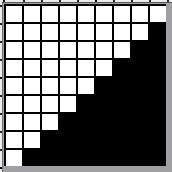 drawn in repeat to 225X225, shapes do not touch in this rendering,
drawn in repeat to 225X225, shapes do not touch in this rendering,  but do if color-inverted.
but do if color-inverted.  Isolating a repeat from the “floating” triangles, 45X81
Isolating a repeat from the “floating” triangles, 45X81 ![]() tiled X3 to 45X243 may look ok
tiled X3 to 45X243 may look ok ![]() but aside from the issue of choosing visually floating shapes vs still touching ones,
but aside from the issue of choosing visually floating shapes vs still touching ones, 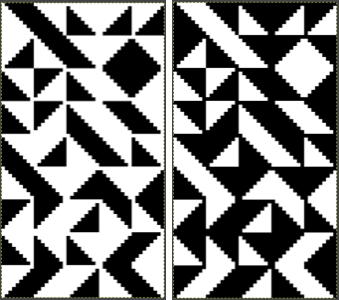 the big problem to be considered is the fact that for the machine KRC color separation to happen correctly, the repeat downloaded must be an even number of rows. A workaround may be to double the original height to 162 rows prior to programming it since one cannot use double height and KRC buttons at the same time in many machine models. Pursuing personal preferences can be endless. I am increasingly fond of the repeat that began with the 8X8 square.
the big problem to be considered is the fact that for the machine KRC color separation to happen correctly, the repeat downloaded must be an even number of rows. A workaround may be to double the original height to 162 rows prior to programming it since one cannot use double height and KRC buttons at the same time in many machine models. Pursuing personal preferences can be endless. I am increasingly fond of the repeat that began with the 8X8 square.
Working with quarter-filled segments: multiplied by 20 in each direction to a 200-pixel repeat. 
![]() Drawn using random/ preview/ prior to saving the file
Drawn using random/ preview/ prior to saving the file 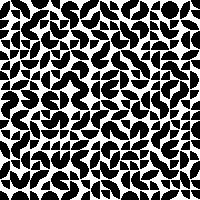 Its color reversed view
Its color reversed view 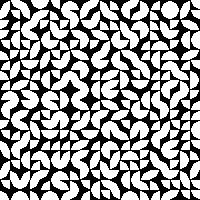
Truchet tiling design inspiration 1
For many years my knitting of accessories and wearable pieces was my source of income, guided by what pricing the local market would bear, the limitations of mylar sheets or that of an early Passap interface to program repeats, and the amount of time required to complete each piece.
There is practicality and ease in playing with colors using small motifs single-bed, and varying materials and yarn plies allowed me to aim for limited edition designs without looking at identical finished products more than once or occasionally a few times.
At first, Ayab and then img2track changed the playing field in terms of downloading and programming designs.
Eventually, my knitting moved from production pieces for sale to creating samples for my blog almost exclusively.
I have had a long and continued interest in math-based designs, and knit a line of accessories using automata-inspired repeats, often limiting the repeats in size to ones that would align vertically without having to program multiple DBJ segments, reducing the possibility of programming errors in scarves that would often require around 1200 knit rows in length.
A 930 followed the 910, this, knit in July 2021, was my first try at using img2track to download multiple tracks.  There are many ways to yield math-based patterns, and nowadays online generators and reference sites abound, making it possible for nongeeks to use the resulting files to create knit suitable designs.
There are many ways to yield math-based patterns, and nowadays online generators and reference sites abound, making it possible for nongeeks to use the resulting files to create knit suitable designs.
Some recent Truchet tile images shared on Instagram brought me back to exploring math-based images and what by default needs to be executed as larger-scale design motifs in knitting.
Sebastian Truchet was a Carmelite priest whose “Memoir sur les Combinasions” was published in 1704. It is a wealth of patterns built up from a simple motif, which you can see here
http://gallica.bnf.fr/ark:/12148/bpt6k3486m.image.f526.langFR and in which he discussed squares, half black, half white, split into triangles, with four possible orientations for each tile. He was also the inventor of the point system for indicating the sizes of typeface fonts.
His method of tiling by the combination of manipulating four-letter codes, A, B, C, and D, in rotations using triangular shapes inspired new variations in tilings.
Cyril Stanley Smith introduced two alternatives to the basic Truchet tile in 1987. One uses only diagonal lines to create maze-like designs where the coloring is removed and only the boundaries remain. The other, resulting in the designs produced in this post, uses quarter circles that may be filled or used as outlines and rotated to form the final shapes. ![]()

 Distinctions in naming the tiles are not often made. “Truchet” is the commonly used generic term.
Distinctions in naming the tiles are not often made. “Truchet” is the commonly used generic term.
Some articles on the tilings:
Generalizations of truchet tiles, Multiscale Truchet Patterns, The Tiling Patterns of Sebastien Truchet and the Topology of Structural Hierarchy, and More on tiles, fun with portraits.
Basic elements include contrasting triangles, quarter circles, and diagonal lines.
One may find code for programming DIY in various GitHub links. Python is far beyond my interest or skill, there are many ways to achieve the designs.
Spreadsheets are also programmable, but require the development of formulas.
Developing patterns from online sources, beginning with the Smith variation using quarter circles: the Wolfram site is a computing and math one well worth exploring, the files there are Computable Document Files, a document standard developed by Wolfram Research. They can be saved and opened using the Wolfram CDF Player, which is a standalone application and a Web browser plug-in provided for free.
To preview search results in a browser: https://demonstrations.wolfram.com/TruchetTiles/.
Ad blockers may interfere with proper previews in Safari but appears to not be an issue using Chrome as the browser.
Files cannot be saved from the preview results other than as screengrabs.
What is cdf
For permanent access to preferred CDFs:
CDF Wolfram player download is available for Mac and Windows, you will be asked to provide an email address.
After the player is installed and opened, click on the central option,  and search for your area of interest.
and search for your area of interest.  Any demonstration may be saved for future use, most are customizable to varying degrees.
Any demonstration may be saved for future use, most are customizable to varying degrees.
In my first effort, I used colors and left the black outlines. The second, simpler method of editing follows below it. 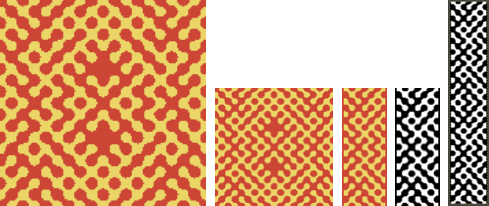 The swatch png, 58X150, includes 2 stitch vertical borders in the dark color. The machine was set to the built-in KRC color separation for DBJ. Some of the circular shapes have been already edited, but if I were to reuse the repeat, I would clean up more of the design shape edges
The swatch png, 58X150, includes 2 stitch vertical borders in the dark color. The machine was set to the built-in KRC color separation for DBJ. Some of the circular shapes have been already edited, but if I were to reuse the repeat, I would clean up more of the design shape edges
160 design rows were knit, measuring 7.5 inches by 20.5.
The dark color is a chenille from an unmarked cone with uncertain yardage. The space-dyed is an 8/2 rayon slub.
Tension was set at 5/5, the knit carriage on KCI, and the ribber using lili buttons for birdseye backing. KCII may be used as well if preferred, the side vertical edges will have a slightly different appearance. 
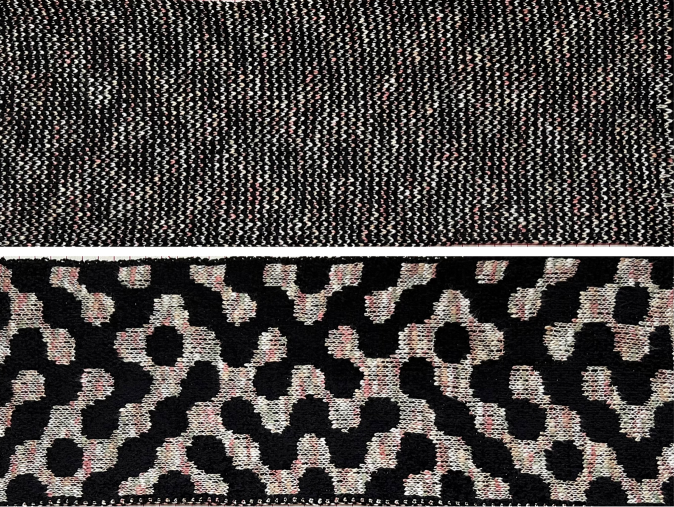 Developing an added repeat:
Developing an added repeat:
the working file in the cdf is a default 600 by 600 pixels. If the goal is to save a black-and-white downloadable png, the present plan is to fill in portions of the design with black while leaving others in white.
Checking tiling insures continuous designs at any point in the process.
It is possible to directly scale size in the cdf, but the shape outlines become broken in the automatic % reduction, so the filling-in process I suggest fails to be contained. 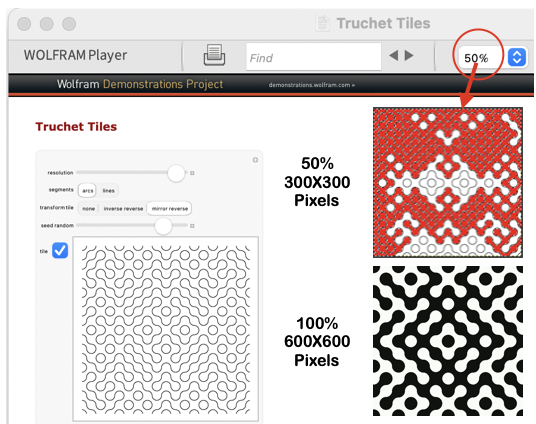 In this exercise, none of the other available parameters were changed. When the player is launched, click on the tile, it will be surrounded by an orange line,
In this exercise, none of the other available parameters were changed. When the player is launched, click on the tile, it will be surrounded by an orange line, 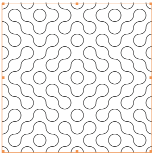 copy the image, and it can then be pasted directly into Gimp.
copy the image, and it can then be pasted directly into Gimp. 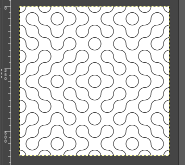 Change the Image Mode to BW Indexed before proceeding further.
Change the Image Mode to BW Indexed before proceeding further.
Using the fuzzy select tool  click on any area in the design, it will be surrounded by dotted lines
click on any area in the design, it will be surrounded by dotted lines 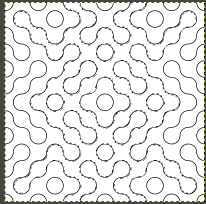 select bucket fill, to fill the selected area with black.
select bucket fill, to fill the selected area with black.
Edit, undo will revert to the previous steps in sequence at any point.
If satisfied, select the rectangle tool.
Clicking on the selected area  will allow its use for copying and pasting the outlined segment on a new canvas or cropping the area to the selection for saving while clicking anywhere in the Gimp work window fixes the results. The dotted lines disappear. Repeat the process on the remaining image.
will allow its use for copying and pasting the outlined segment on a new canvas or cropping the area to the selection for saving while clicking anywhere in the Gimp work window fixes the results. The dotted lines disappear. Repeat the process on the remaining image.  The processed file will measure 600X600 pixels.
The processed file will measure 600X600 pixels.
Anyone working with large-scale images and reducing file size to make them available for knitting as single panels on a standard machine is familiar with the loss of detail and the need for cleanup of edges as incremental decreases in file size are attempted.
Magnifying any of these will help evaluate forms and scaling decisions for final repeats to be used in knit test swatches.
Downloading or copying and pasting them from here for personal use may change the image mode to RGB in the process, check mode and convert them to indexed BW if needed before any further use.
300X300 200X200 pixels
200X200 pixels  150X150 pixels
150X150 pixels 
 The proof of concept was knit using the 100X200 repeat without any pixel cleanup.
The proof of concept was knit using the 100X200 repeat without any pixel cleanup. 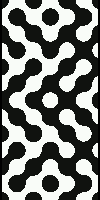 The blue yarn is a 2/20 wool, and the white is a 2/28 Italian yarn of unspecified fiber content from my stash. Both beds were set at 2/2. The KRC setting separated the colors so each color in each row knits only once, but it takes 2 passes to complete one row, so 100 design rows translate to 200 rows of knitting. In this instance, img2track used on the 930 broke up the design into 2 tracks, a 66-row first track, followed by a 134-row one.
The blue yarn is a 2/20 wool, and the white is a 2/28 Italian yarn of unspecified fiber content from my stash. Both beds were set at 2/2. The KRC setting separated the colors so each color in each row knits only once, but it takes 2 passes to complete one row, so 100 design rows translate to 200 rows of knitting. In this instance, img2track used on the 930 broke up the design into 2 tracks, a 66-row first track, followed by a 134-row one.
Each track needed to be programmed sequentially.
The ribber was set for birdseye backing, which in this case results in an interesting shadowing of the pattern 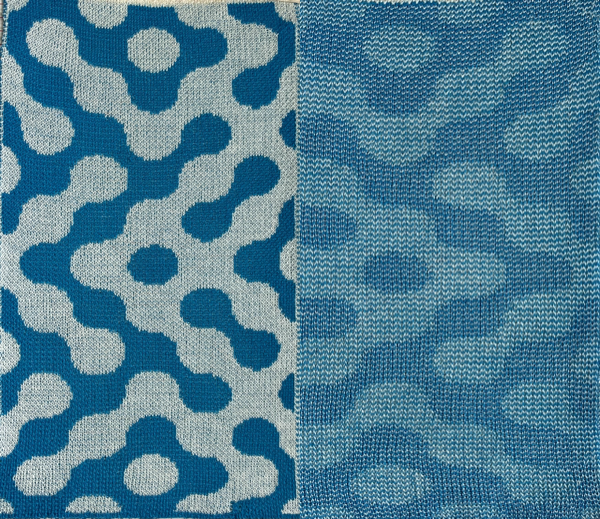 Comparing the two swatches:
Comparing the two swatches: 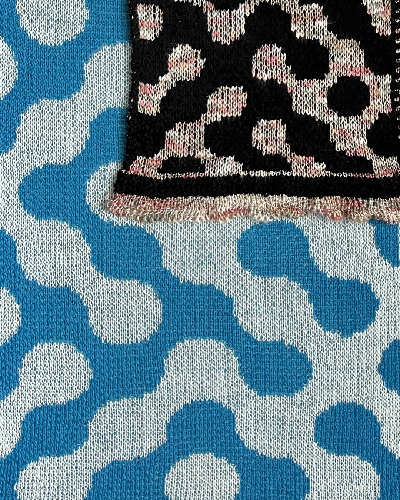 Variations in tiles made by changing variable view options
Variations in tiles made by changing variable view options 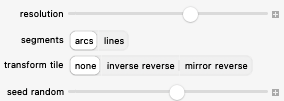 will still align when combined, easily producing a range of new designs at merging points. Use guides to help narrow down segments of interest, here they are placed at even 100-pixel intervals on two adjoining 600-pixel images.
will still align when combined, easily producing a range of new designs at merging points. Use guides to help narrow down segments of interest, here they are placed at even 100-pixel intervals on two adjoining 600-pixel images. 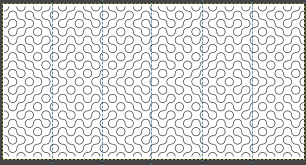 To remove a single guide after placing it, go to Edit, Undo Add the Horizontal or Vertical Guide. To remove all guides, go to View, and uncheck Show Guides.
To remove a single guide after placing it, go to Edit, Undo Add the Horizontal or Vertical Guide. To remove all guides, go to View, and uncheck Show Guides.
And for those not averse to developing any larger motifs from scratch, the limitations of any geometric shape, when reduced to low-resolution knitting, mean the search must begin for what one determines to be a pleasing circular form.  My original circle was placed on a 40X40 grid with outlines every 10 cells, the central circular 20X20 repeat was isolated and split into quarters, in turn generating these 2 tiles out of the 8 total required, also 20X20, with the second the color-reversed image of the first.
My original circle was placed on a 40X40 grid with outlines every 10 cells, the central circular 20X20 repeat was isolated and split into quarters, in turn generating these 2 tiles out of the 8 total required, also 20X20, with the second the color-reversed image of the first. ![]()
![]() A similar approach can be used in color to visualize the initial 8 tile repeats and their rotations in order to form new shapes. This technique may be useful in planning floor tile patterns but is cumbersome for developing knit designs.
A similar approach can be used in color to visualize the initial 8 tile repeats and their rotations in order to form new shapes. This technique may be useful in planning floor tile patterns but is cumbersome for developing knit designs. 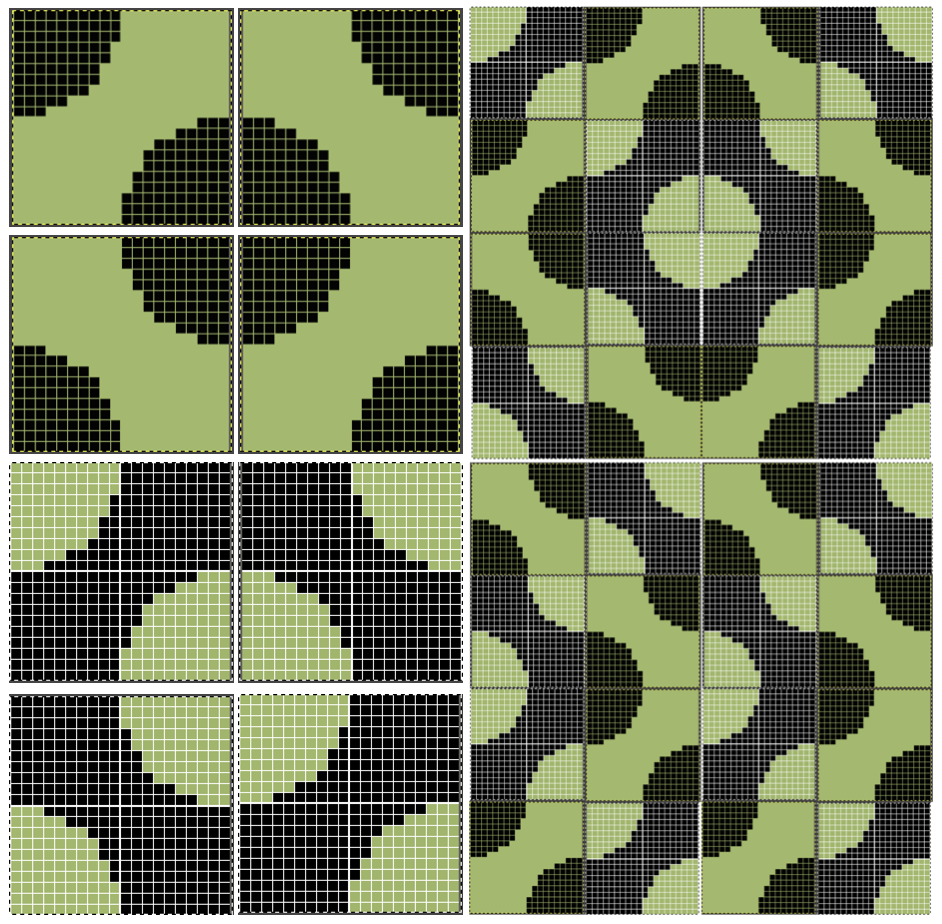 Facilitating and speeding up the process: in my post on using ArahPaint and Gimp in knit design, I briefly touched on the Drawing-in-repeat feature in Arah to produce random tiling.
Facilitating and speeding up the process: in my post on using ArahPaint and Gimp in knit design, I briefly touched on the Drawing-in-repeat feature in Arah to produce random tiling.
 Thanks to the developer there now is a video, viewable on Instagram and Facebook, on how to use the feature for this type of tile, which allows for very quick DIY versions that can be trimmed as needed for knitting. This is my very first try, a how-to will follow in the next post.
Thanks to the developer there now is a video, viewable on Instagram and Facebook, on how to use the feature for this type of tile, which allows for very quick DIY versions that can be trimmed as needed for knitting. This is my very first try, a how-to will follow in the next post.  And the second, composed of triangular forms
And the second, composed of triangular forms For spreadsheet users, this one generates the various tiles in Google Sheets and a related article.
For spreadsheet users, this one generates the various tiles in Google Sheets and a related article.
Figurative designs in mosaic knitting
Designs may be developed to incorporate lines and grids by outlining motifs, filling in the results with grids or lines, and even color inverting the results.
From an early 2013 post:
Each number on the grids below represents 2 consecutive rows of knitting. The design may be elongated in the drawing of the final repeat itself prior to punching holes, marking mylar or pixels, or elongated using the built-in setting in the KM used, whether electronic or punchcard.
Color changes are required every 2 rows.
The grids:  After a motif has been separated, usually color 1 is represented in row 1, and all odd-numbered rows
After a motif has been separated, usually color 1 is represented in row 1, and all odd-numbered rows
color 2 is represented by row 2 and all even-numbered rows
long horizontal lines in mazes usually occur on odd-numbered rows
even-numbered rows typically have no more than 2 black squares marked side by side
on odd-numbered rows, the white cells slip
on even-numbered rows, the black cells slip
odd-numbered rows are knitted in the primary color (black cells)
even rows are knitted in the contrasting color (white squares)
Forming shapes and or text on the vertically symmetrical grid:

 2023
2023
These single-bed knits are ideal when float control is an issue, or when one wishes to reduce the bulk of fair isle techniques. There are, however, geometric design restrictions and the resulting patterns may be too “busy” for some.
Separated designs interrupted by black or white lines rather than single-cell dots are knit using slip stitch on the single bed, or in every needle rib with the knit carriage set to slip or even tuck in both directions on the top bed, and the ribber set to knit in both directions, a very different fabric.
The basic procedures for drawing figurative repeats may be worked out using graph paper or image processing programs, depending on what tools are available.
Working in Gimp, generate a file in a basic grid, which in turn may be tiled to any dimensions needed. ![]()
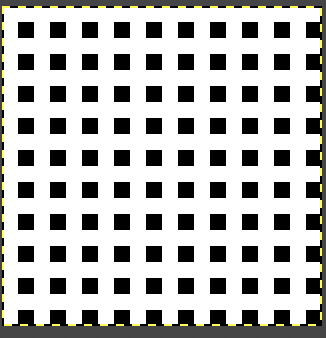

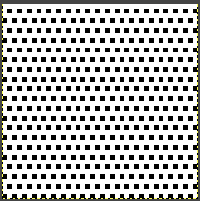 Using the bottom grid is problematic in creating figurative mosaics using the connect-the-dots technique. Attempted vertical lines do not connect cleanly.
Using the bottom grid is problematic in creating figurative mosaics using the connect-the-dots technique. Attempted vertical lines do not connect cleanly.  Cautious planning is required in executing figurative designs.
Cautious planning is required in executing figurative designs.
Clean-up will often result in solid color surrounding shapes or the addition of some short solid lines.
Doodling with blocks on both grids in a spreadsheet.  Text becomes more complicated if one seeks to emulate favorite fonts or to work on a small scale.
Text becomes more complicated if one seeks to emulate favorite fonts or to work on a small scale.
A spreadsheet using multiple colors may make the drawing easier to start with. By necessity, repeats will once more need to be large.
With practice, one develops favorite ways of reaching the chosen goal. 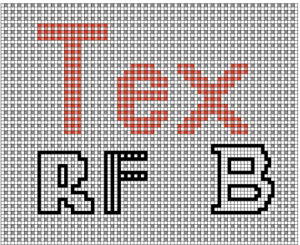 Large shapes may be superimposed on either dotted grid for final editing depending on what sort of border one wishes to add in designs for end-use in large pieces such as blankets.
Large shapes may be superimposed on either dotted grid for final editing depending on what sort of border one wishes to add in designs for end-use in large pieces such as blankets.  Figurative drawing occurs on rows marked with black pixels on the grid where black dots line up vertically.
Figurative drawing occurs on rows marked with black pixels on the grid where black dots line up vertically.
White rows remain blank except where the black dots in the shape’s outline need to connect vertically.
After the outline for the motif is created, the filling-in of the shape is executed connecting dots once again.
By necessity, these shapes need to be large.
My first design is 68 stitches wide by 40 high. ![]()
 Processing the image is done on the same design. When color-separating Mosaics the design is not elongated.
Processing the image is done on the same design. When color-separating Mosaics the design is not elongated.
Using the steps described in previous posts on a copy of the initial file: color invert, ![]()
 It is interesting to observe that the knitted result matches this image.
It is interesting to observe that the knitted result matches this image.
The file may begin as black and white indexed, but prior to adding colors the mode needs to be changed to RGB.
Add a third color beginning on every other row beginning on row 1,  using layer, transparency, and color to alpha, the third is removed, leaving black and white.
using layer, transparency, and color to alpha, the third is removed, leaving black and white. 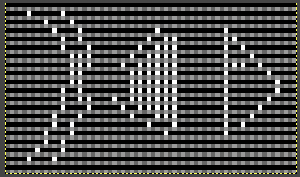 The alpha file is copied and pasted on the original resulting in a knittable mosaic repeat that requires elongation X2.
The alpha file is copied and pasted on the original resulting in a knittable mosaic repeat that requires elongation X2.
Check that the file is in indexed BW mode prior to saving it for knitting, it will need to be elongated X2 if used as is. ![]()
 The above doubled in height, now 68 stitches wide by 140 high, may be knit as is.
The above doubled in height, now 68 stitches wide by 140 high, may be knit as is. 
 Those solid black areas are OK. On the corresponding design rows, needle selections on nearly every needle will take place, those needles will knit the color in use at the time.
Those solid black areas are OK. On the corresponding design rows, needle selections on nearly every needle will take place, those needles will knit the color in use at the time.
The tuck setting is possible, the final appearance will be quite different. For my swatch, I used the slip setting.
Slip-stitch pieces tend to have vertically straight side edges, while tuck ones tend to have wavy ones.
The floats on the purl side are still only 2 stitches wide.
The all-knit areas are not reduced in height, so they ripple initially and became flattened with blocking in this case, but caused the top and bottom of the horizontally striped segment to curve.
Starting knitting using the light color as opposed to dark will color invert the design.
The blue yarn used here is wool and the yellow is acrylic.
The swatch was steamed and pressed.
The dark color is dominant.  Visualizing the color inverted image using the photograph of the swatch rather than actually knitting it:
Visualizing the color inverted image using the photograph of the swatch rather than actually knitting it:  A 48X46 heart to play with for DIY
A 48X46 heart to play with for DIY 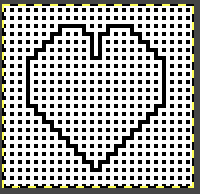
![]() Beginning in a spreadsheet followed by transitioning to Gimp can use a similar dot-to-dot design concept. It offers the opportunity to make adjustments before fixing on placement for the final black pixels over other colors. Moving away from dot to dot to “visually pleasant” does not necessarily work.
Beginning in a spreadsheet followed by transitioning to Gimp can use a similar dot-to-dot design concept. It offers the opportunity to make adjustments before fixing on placement for the final black pixels over other colors. Moving away from dot to dot to “visually pleasant” does not necessarily work.
The flower design chosen and committed to for the moment is 37X32, visualized on possible backgrounds, and placed on a final one drawn with straight diagonal lines in pattern, for the test knitting ![]()
 Aside from whether accurate tiling is possible for that final repeat, it has far too many white rows uninterrupted by black squares. As in any slip-stitch fabric, a stitch is held in every white cell or unpunched area location until a black cell or punched hole follows it, the result is very elongated single stitches on the knit side:
Aside from whether accurate tiling is possible for that final repeat, it has far too many white rows uninterrupted by black squares. As in any slip-stitch fabric, a stitch is held in every white cell or unpunched area location until a black cell or punched hole follows it, the result is very elongated single stitches on the knit side: 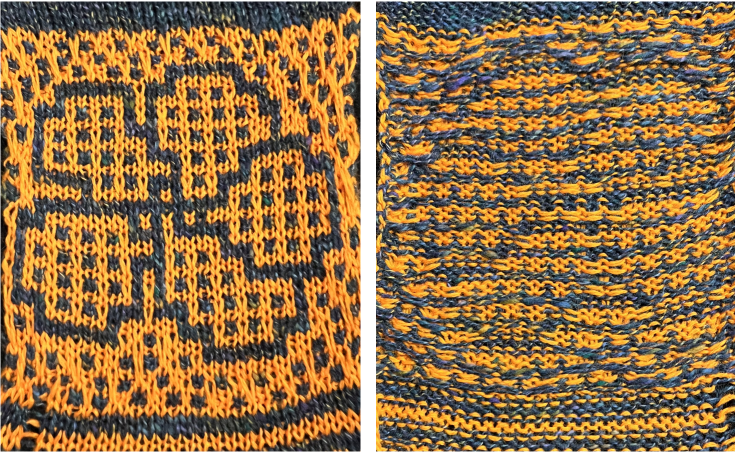 There is a limit as to how big a part of any final mosaic repeat can truly be freeform.
There is a limit as to how big a part of any final mosaic repeat can truly be freeform.
It helps to develop a library of personal grid variations, to be willing to observe some basic rules, and to have an affinity for the overall look of the results.
In terms of the basic grids, the horizontal stripes have already been shown in the fish to produce 2-row all-knit stripes in alternating colors where they are placed in the design.
The vertical stripes create this result when proofed, and it can be recognized in the png for the body of the fish  Developing a DIY background: I find it easier to work on such designs on a large table in Numbers, which allows for placing a variety of colors and in the same document more easily, and then converting the outcome to a BW indexed png in Gimp.
Developing a DIY background: I find it easier to work on such designs on a large table in Numbers, which allows for placing a variety of colors and in the same document more easily, and then converting the outcome to a BW indexed png in Gimp. 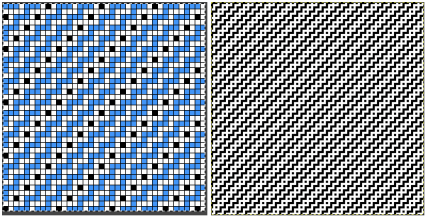 The smallest isolated repeat, in this case, is a square, 20X20
The smallest isolated repeat, in this case, is a square, 20X20 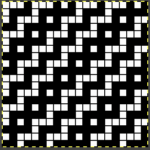 Make certain it tiles correctly before proceeding:
Make certain it tiles correctly before proceeding:
 The final file doubled in length shows no areas where extended slip stitch rows might be an issue. This step is not necessary as one begins to trust the process.
The final file doubled in length shows no areas where extended slip stitch rows might be an issue. This step is not necessary as one begins to trust the process.  Returning to that flower, on the white-to-alpha ground, a 37X32 saved file, open it in Gimp.
Returning to that flower, on the white-to-alpha ground, a 37X32 saved file, open it in Gimp.
Open a second file, using the background-repeat, and tile it X2 in both height and width to a matching 40X40 size.
Copy and paste the flower onto it in what appears to be a visually pleasing location, clean up the surrounds, and save the png. 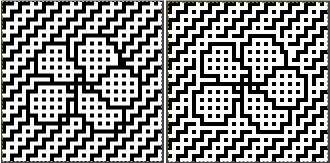
![]() Proceed with the now familiar steps:
Proceed with the now familiar steps:  The final repeat must be elongated X2, color inverting may provide a better sense of what cells knit or slip, and it may be used to knit the design.
The final repeat must be elongated X2, color inverting may provide a better sense of what cells knit or slip, and it may be used to knit the design. 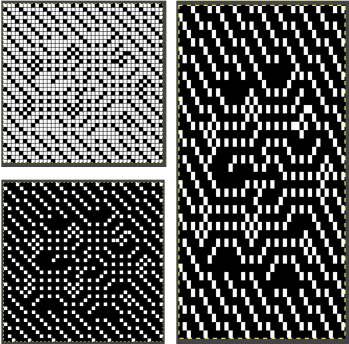 The working 40X80 repeat:
The working 40X80 repeat: ![]()
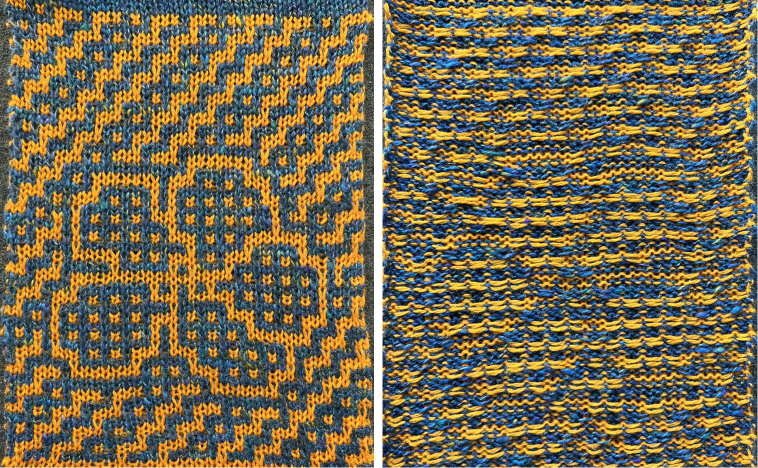 Once again, the completed swatch visually matches the original file, color inverted.
Once again, the completed swatch visually matches the original file, color inverted.
The latter provides a sense for guessing if the knit results are pleasing and it offers a way to explore different colorways or matching yarn colors.
Pursuing the dot-by-dot concept can lead to endless DIY designs. Playing with motif scale in Numbers: 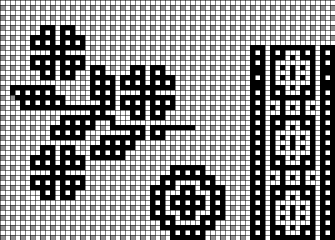 Isolating part of the design in Gimp: 42X44
Isolating part of the design in Gimp: 42X44 ![]() A variation using multiples on an 80X80 canvas.
A variation using multiples on an 80X80 canvas.  Loving that DIY background? To create a frame
Loving that DIY background? To create a frame
1. choose a finished canvas size, ie 120X120, and fill it by tiling the DIY background
2. open a second file to, in this case, 80X80, in any color including white. I chose yellow as a way to place black border lines more easily
3. copy and paste the second file onto the first
4. add a solid color border at the inner and outer edges of the frame, outlining the shape at its center.  At this point, any image also 80X80 may be simply opened in Gimp, copied, and pasted over the yellow.
At this point, any image also 80X80 may be simply opened in Gimp, copied, and pasted over the yellow. 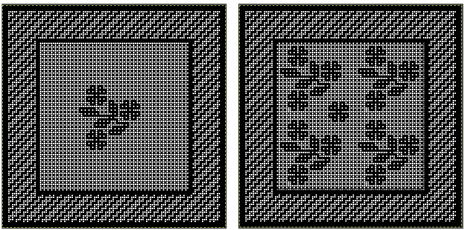 Files to play with: the frame with a transparent center
Files to play with: the frame with a transparent center 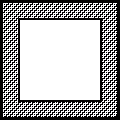 to be pasted in place on other graphic files,
to be pasted in place on other graphic files,  Here with a dot-to-dot center to draw on,
Here with a dot-to-dot center to draw on, 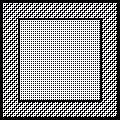 and the file with central flower motifs to use or edit further.
and the file with central flower motifs to use or edit further.  The final choice then needs to be made as to how to use the final image.
The final choice then needs to be made as to how to use the final image.
One option is to separate the motif for use as a single bed 2 color slip stitch, and the second is to simply use the built-in KRC color separation in electronic machines to knit it as DBJ.
Motif definition requires large-scale designs limited by patience and imagination.
Autofill, command key and other shortcuts can help execute them more easily and quickly in spreadsheets as a first step.
This start of a hummingbird, inspired by a small segment of a Pinterest find, is already 54X101 pixels, ending my exploration of these knits for the moment. 
When editing or developing large images a series of guides may be useful. To configure them, see pos:t Gimp update for Mac 2
Color separations for larger scale mosaics and mazes
There are generators online for many generators to aid with knitting design. In 2015 I published a post on working with generated mazes: Gimp charting 1
The mosaic and maze graphics prior to their color separations are not suitable for fantasy fair isle double bed knitting as a shortcut. There are simply too many vertical white pixel rows begging for carriage jams no matter the machine used. The same long lines of black or white cells make them unsuitable for traditional fair isle knitting as well.
Visual clues are helpful as steps get navigated. In small-scale repeats, a different option from the method that follows is to begin with a file previously used and separated, magnified to 1800X.
1. using the rectangle select tool, begin on row 1, extending handle outside the image, I work from left to right
2. hold down the shift key, and continue selecting every other row. As each row is selected, it is outlined with dots. The handles to the right and left of that row serve as guides as to the last row worked, moving up as separation progresses. Clicking on the rectangle select tool at any point fixes the layer, and the dotted lines will disappear. 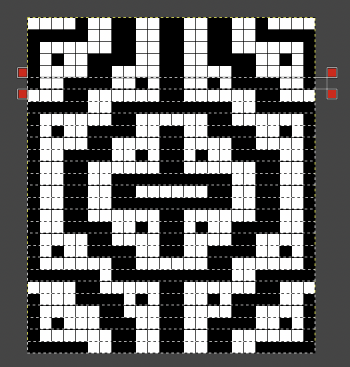 The process could be performed in steps, with guides placed prior to color inverting the previous steps in the sequence and moving onto the next.
The process could be performed in steps, with guides placed prior to color inverting the previous steps in the sequence and moving onto the next.  The guides remain until they are removed by clicking on the check mark beside show guides,
The guides remain until they are removed by clicking on the check mark beside show guides, ![]() or with the / / command.
or with the / / command.
In large designs, I would guess this may be more easily error-prone than when using layers.
3. after each pertinent row has been selected, choose the color invert option, and save the resulting file. The first step is completed in the separation.
The file then needs in turn to be color-inverted and lengthened X2 prior to knitting. The result matches the separation in the previous post.  Holding down the shift key when using the pencil tool on any image produces very different results.
Holding down the shift key when using the pencil tool on any image produces very different results. 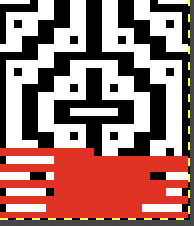 My samples continue to be knit on the 930 using img2track, a download program I find reliable and easy to use. The only errors in programming I have encountered were due to operator errors, not software ones.
My samples continue to be knit on the 930 using img2track, a download program I find reliable and easy to use. The only errors in programming I have encountered were due to operator errors, not software ones.
Since 2015 working with larger images has become far less daunting as my methods for color separations of mazes and mosaics have evolved.
Laura Kroegler’s online Mosaic Pattern Generator is still available. Returning to it, and using these parameters  the pngs were downloaded both in red and then again in black and white.
the pngs were downloaded both in red and then again in black and white. 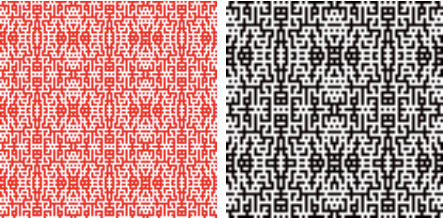 A 38X38 stitch repeat was isolated, and using Layer/Transparency/Color to Alpha a knittable mosaic design was obtained which, when knit, would require elongation X2 for color changing every 2 rows
A 38X38 stitch repeat was isolated, and using Layer/Transparency/Color to Alpha a knittable mosaic design was obtained which, when knit, would require elongation X2 for color changing every 2 rows ![]()
 The last file, doubled in length to 76 rows in height, requires no further processing
The last file, doubled in length to 76 rows in height, requires no further processing ![]() The separations are achieved now in just minutes.
The separations are achieved now in just minutes.
The proof of concept swatch: when using repeats that are so much wider, one must commit to far larger swatches to test them. In addition, the placement in the final piece may matter with shifting the pattern to highlight a preferred center, here the machine was allowed to place the design as a simple overall one on 78 stitches by 116 rows. 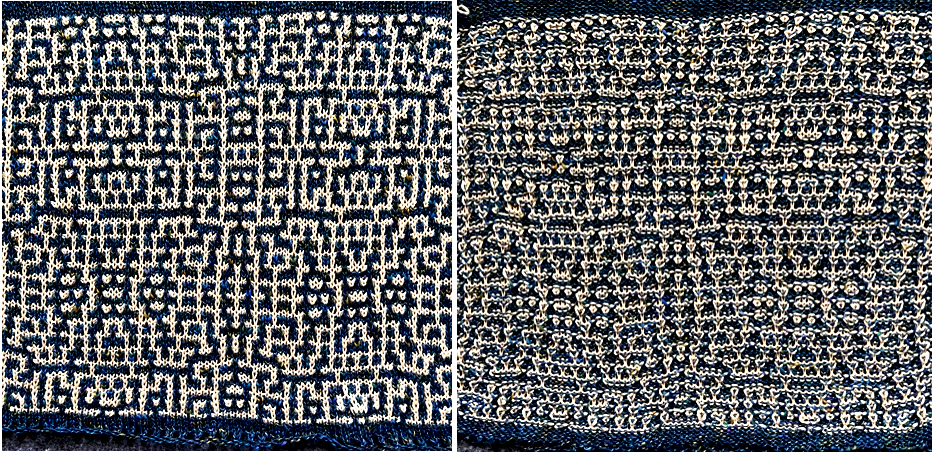 There are droves of inspiring large-scale mosaic crochet images published nowadays, which led me to wonder about DIY similar large graphic mosaics in machine knitting.
There are droves of inspiring large-scale mosaic crochet images published nowadays, which led me to wonder about DIY similar large graphic mosaics in machine knitting.
I performed the first color separation with shortcuts, used mirroring the cleaned-up repeat, did not verify each step with tiling, and committed to knitting a test swatch. A 68X136 repeat X2 in width and at least with 40 more rows in height, produced a 16X24 inch test swatch, wherein a couple of missing pixels became noticeable.
The swatch was also knit using slip in both directions on the main bed, which produces a narrow, short fabric as opposed to wide and also short when using the tuck setting.  Back to the drawing board.
Back to the drawing board.
The initial approach is similar to that used in creating mock filet crochet shapes on the machine.
With present tools the results process is easy and quick: to begin with, choose any symmetrical design where the shaping of the motif occurs in single rows, this one measures 23X23 ![]()
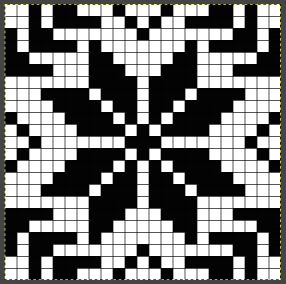 scale the file X3 in both directions to 69X69
scale the file X3 in both directions to 69X69 
 save this brush to use later for bucket-fill in the design.
save this brush to use later for bucket-fill in the design.  Choose fuzzy select by color/black, each shape will be surrounded by a dotted line
Choose fuzzy select by color/black, each shape will be surrounded by a dotted line 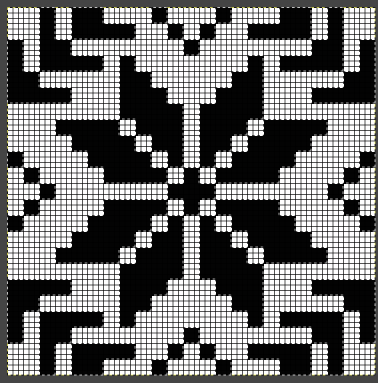 bucket fill the selections with the saved pattern
bucket fill the selections with the saved pattern  click on rectangle select to fix the layer, work on and clean up the repeat, and check a magnified version for any missing or misplaced pixels.
click on rectangle select to fix the layer, work on and clean up the repeat, and check a magnified version for any missing or misplaced pixels.  Save the png. for reference before continuing to work.
Save the png. for reference before continuing to work.  Make one of 2 choices. If the goal is to place a motif, and to add borders or horizontal additional design stripes, create a new canvas, larger in size than the above, fill it with the same pattern, and then Colors/Invert. Click on the rectangle tool to fix the layer.
Make one of 2 choices. If the goal is to place a motif, and to add borders or horizontal additional design stripes, create a new canvas, larger in size than the above, fill it with the same pattern, and then Colors/Invert. Click on the rectangle tool to fix the layer. 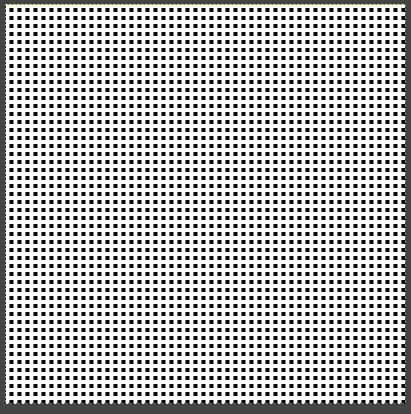 Change the white color to alpha in the previously processed snowflake, click on the rectangle tool again
Change the white color to alpha in the previously processed snowflake, click on the rectangle tool again 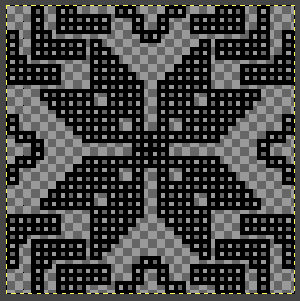 copy and paste the file onto the color-reversed grid, and click on the rectangle tool. Check the pasted image visually, and continue adding any other designs.
copy and paste the file onto the color-reversed grid, and click on the rectangle tool. Check the pasted image visually, and continue adding any other designs. 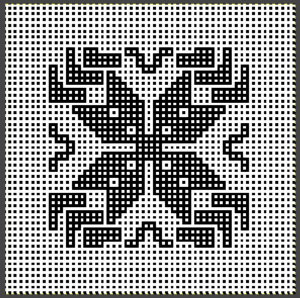 If the goal is to produce an all-over design, crop the shape on the dotted ground, and save it as a 69X69 repeat. Pasting the original on an equal size color reversed dotted ground does not work.
If the goal is to produce an all-over design, crop the shape on the dotted ground, and save it as a 69X69 repeat. Pasting the original on an equal size color reversed dotted ground does not work. 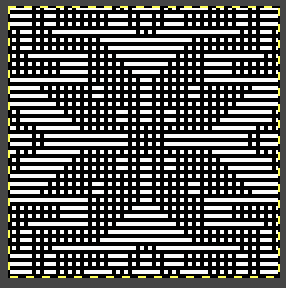 Tiling the result of the cropped repeat will show the need for cropping it by one row at the top and one column to the right.
Tiling the result of the cropped repeat will show the need for cropping it by one row at the top and one column to the right.  The resulting repeat, 68X68
The resulting repeat, 68X68  tiled X3 in each direction for a visual check.
tiled X3 in each direction for a visual check. 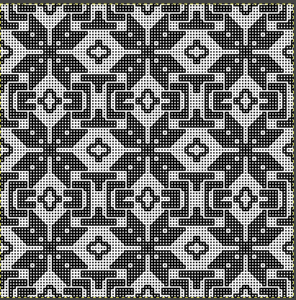 Using the process previously described
Using the process previously described
1. open the 68-stitch file in Gimp, and magnify it to at least 800X for a visible grid
2. open file/new, equal size and magnification
3. copy and paste 1 on 2, click on the rectangle select tool
Colors/invert, click again on the rectangle tool or anywhere in the work window 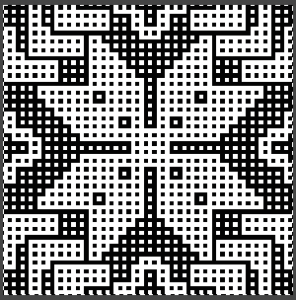 4: magnify further if needed. Using the pencil tool fill in every other row beginning with row 2 in a contrasting palette color, and click on the rectangle tool
4: magnify further if needed. Using the pencil tool fill in every other row beginning with row 2 in a contrasting palette color, and click on the rectangle tool  5. Layer, transparency, color to alpha, as described in the last post, click on rectangle tool
5. Layer, transparency, color to alpha, as described in the last post, click on rectangle tool 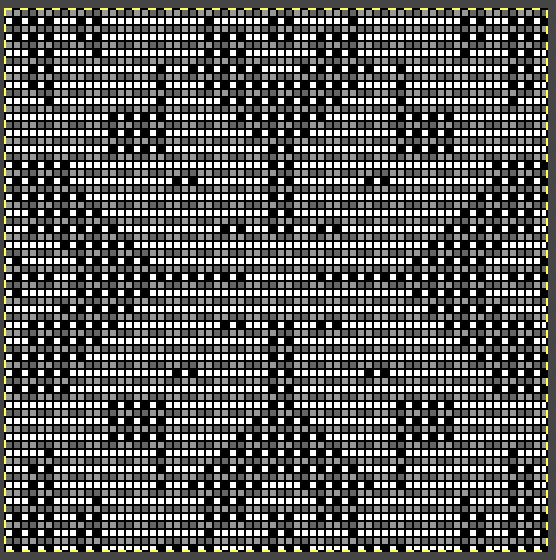 6. Copy and paste this result onto the 68-stitch file in the first window, there will be lots of dotted lines onscreen
6. Copy and paste this result onto the 68-stitch file in the first window, there will be lots of dotted lines onscreen  Click on the rectangle select tool to paste the image in place.
Click on the rectangle select tool to paste the image in place. 
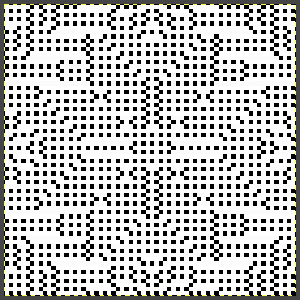 Since those large areas of white will be knitted in a tuck or slip fabric, the above result needs to be color inverted. If used as is, set the machine’s built-in double-length function.
Since those large areas of white will be knitted in a tuck or slip fabric, the above result needs to be color inverted. If used as is, set the machine’s built-in double-length function. 
 Doubling the length of the file prior to the download to km
Doubling the length of the file prior to the download to km  Part of the view on the img2track screen for the 68X136 file ready for download.
Part of the view on the img2track screen for the 68X136 file ready for download.  Committing to proving the concept:
Committing to proving the concept:  Using the same approach of tripling the original, here the repeat
Using the same approach of tripling the original, here the repeat 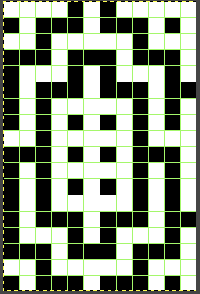 was used in an attempt to render a larger-scale mosaic. The process becomes fiddly because using the fuzzy select tool and then the bucket-fill-in pattern does not work cleanly on areas that are only 3 pixels wide.
was used in an attempt to render a larger-scale mosaic. The process becomes fiddly because using the fuzzy select tool and then the bucket-fill-in pattern does not work cleanly on areas that are only 3 pixels wide.
That said, it is possible obstinately, in stages, to get from this, 36X54 ![]()
 To a 36 by 56 mosaic
To a 36 by 56 mosaic
![]()
 A last edit
A last edit![]()
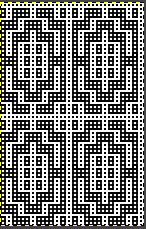 Perhaps falling in the category of “don’t have to simply because I can”.
Perhaps falling in the category of “don’t have to simply because I can”.
Images at this stage of the process may be knit double-bed as a “fantasy fair isle” with no further separation.
On an electronic machine, download the repeat, program it for the number of needles in use on the top bed, and select the KRC separation button.
The first preselection row will need to be from left to right.
The main bed is set to tuck in both directions, the ribber to N in both directions.
There will be lots of non-selected needles tucking on rows with large numbers of side-by-side white cells. Because the fabric is being knit using every needle on both beds, each main bed tuck loop will have a knit stitch on the opposite bed anchoring it down. Those rows will appear more compressed, producing narrower horizontal lines  The yarns used were very thin single strands of 2/28 at tension 4/3. The result is a very lightweight and loose knit with lots of drape. The 72 stitches by 140 rows swatch measured 16 inches in width by 10 rows in height. Perhaps a good method for summer shawls, worth exploring in thicker yarns for blankets. A closer look at the structure:
The yarns used were very thin single strands of 2/28 at tension 4/3. The result is a very lightweight and loose knit with lots of drape. The 72 stitches by 140 rows swatch measured 16 inches in width by 10 rows in height. Perhaps a good method for summer shawls, worth exploring in thicker yarns for blankets. A closer look at the structure: 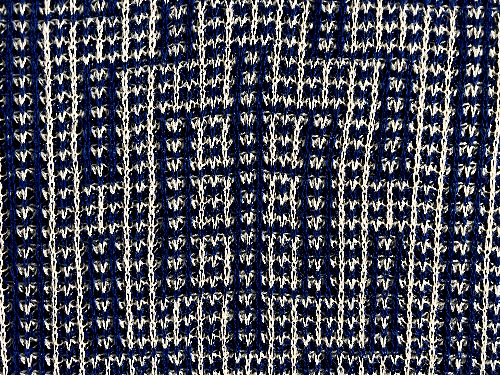 A larger BW design was processed using no modification of the original 75X71 motif. When using Gimp/File/Save, the result is a .xcf document similar to PSD files in Photoshop. It will store layers, transparency settings, and more information associated with and parts of the same project.
A larger BW design was processed using no modification of the original 75X71 motif. When using Gimp/File/Save, the result is a .xcf document similar to PSD files in Photoshop. It will store layers, transparency settings, and more information associated with and parts of the same project. 
 Note to self: before deleting the .xcf make certain that at least the final png has been saved.
Note to self: before deleting the .xcf make certain that at least the final png has been saved.
If one is familiar with image processing and fond of the maze appearance in designs, there is a font to try: Mazeletter
The downloadable associated documentation and source for inspiration: http://mazeletter.xyz/Mazeletter.pdf.
A very quick random type sample rendered with no advance planning: 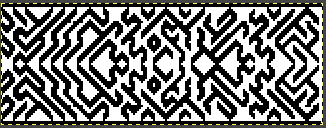
Another, mosaic4way, is potentially usable for single bed fair isle or dbj.  The drawback has been that my sample pngs for both were created in RGB mode, and conversion to BW or scaling loses details.
The drawback has been that my sample pngs for both were created in RGB mode, and conversion to BW or scaling loses details.
It is possible to begin on an all-white canvas, set the mode to indexed to start with, type text, merge layer down, crop to content, and have workable indexed black and white knittable results, but the degree of success appears to depend on the font size used.
Another thing to investigate 😉
Ribber trims 4
Ribber trims 2 presented a series of ideas for edgings I meant to return to. Rather than adding more to that post presently, I am expanding on the topic here.
Scalloped trims are popular in single-bed knits. Preventing any needles from knitting for any number of rows will form a wave. If automatic needle selection is used, they may be formed using both the tuck and slip stitch settings.
This version from the Brother Ribber Techniques, with knitting directions included in Ribber trims and edgings 1  If there is a problem in double bed versions using loops formed by holding stitches or tuck patterning, try completing a tubular cast-on before starting either sequence.
If there is a problem in double bed versions using loops formed by holding stitches or tuck patterning, try completing a tubular cast-on before starting either sequence.
Using tuck stitch rows created manually way can work as a cast-on method:
Begin with a familiar yarn and tensions to form the usual zig-zag row from right to left
Set the ribber to slip in both directions
Bring every 6th needle on the top bed out to hold, and set the knit carriage to knit. 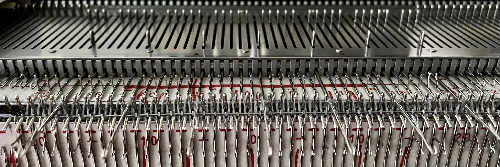 At that point the yarn will be knitting solely on the top bed, so tension needs to be adjusted closer to what may be normally used in knitting it in stocking stitch.
At that point the yarn will be knitting solely on the top bed, so tension needs to be adjusted closer to what may be normally used in knitting it in stocking stitch.
Set the ribber to slip in both directions.
Make at least 4 passes on the main bed, 6 will yield more of an effect but may be hard to manage on Japanese machines while in Passap, the strippers facilitate the process.
My first swatches were knit using 2/8 wool, which pushes the limits for smooth knitting in every needle rib on the 4.5mm machine. After knitting 5 rows the top bed stitches began riding up.  The next row needs to be knit across both beds, sealing the scallop.
The next row needs to be knit across both beds, sealing the scallop.
Bringing the top bed needles all the way forward can help with that, but to ensure gathered loops will knit off properly, a bit of fiddling may be required, any tool can be used to push down lightly on alternating sides of the loops to keep the stitches to their side from unraveling. 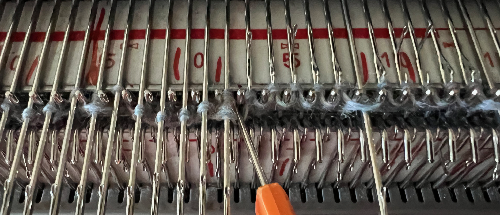 Release the hold lever on the top bed, set the ribber to knit in both directions, and continue in every needle rib to the desired length
Release the hold lever on the top bed, set the ribber to knit in both directions, and continue in every needle rib to the desired length
The top images show the result of forgetting to set the ribber to knit, so there are 2 extra all-knit rows on the top bed, the bottom images were knit with the proper setting transition 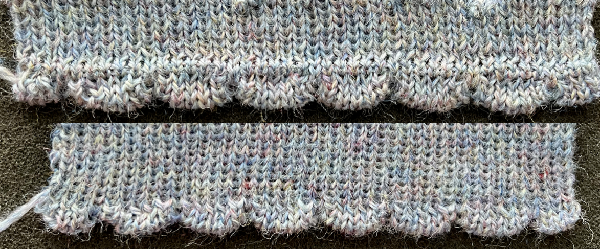 Since the top bed only knits for several rows, the ribber stitches can be seen elongated on this side of the knit
Since the top bed only knits for several rows, the ribber stitches can be seen elongated on this side of the knit  Switching to a 2/20 wool, the same needle spacing, and holding stitches for 6 rows:
Switching to a 2/20 wool, the same needle spacing, and holding stitches for 6 rows: 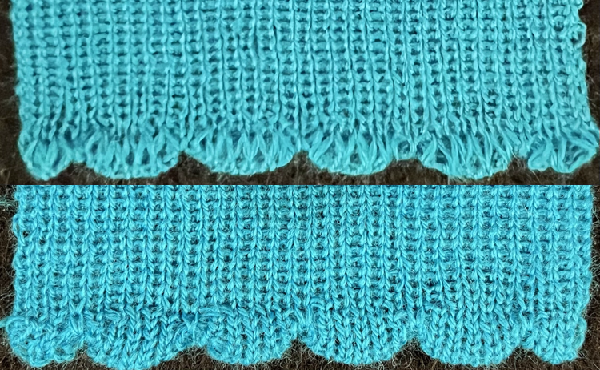 One last fiber switch, a different 2/20 wool shade.
One last fiber switch, a different 2/20 wool shade.
Here the detail is used at the bottom of the stocking stitch swatch rather than a ribbed one.
Watch for loops hung up on gatepegs, seen below in the top swatch.
The scallop shape wanted to turn toward the knit side but did set with some steaming.
Upon completing the holding sequence, transfer all ribber stitches to the top bed.
The tension in the swatch remained the same throughout, but in the bottom views, a loose joining row (perhaps too loose) was knit after transferring all ribber stitches to the top bed, as is often done for smoother transitions in single-bed hems. After the single loosely knit row, the tension is adjusted set to a number appropriate for the specific yarn in single-bed work.  This information and pngs expand on the knit charts in the 2019 post. If the pngs are copied, check that mode has not been altered to RGB automatically, and index back to BW mode prior to downloading them to machines for knitting.
This information and pngs expand on the knit charts in the 2019 post. If the pngs are copied, check that mode has not been altered to RGB automatically, and index back to BW mode prior to downloading them to machines for knitting.
Though, in general, starting side does not often matter, when testing techniques consistently beginning on the same side and leaving a yarn end will help identify which surface is knit facing or purl facing and whether that is of implications in the specific design.
Designing the repeat tiled for the width of the bed when working on electronic machines allows one the opportunity to add all knit borders in specific widths and to program the result as single motifs without concerns about needle placements on the knit bed or how to influence edges.
Punchcard knitters are faced with fixed 24-stitch locations on the needle bed, all knit borders would require manually bringing the needles involved out to E before each carriage pass.
As always, white pixels/unpunched areas tuck, and black pixels/ punched holes knit.
These repeats can make for interesting all-over fabrics as well as serve for edgings that flair and form bottoms that are wavy to different degrees.
12X18![]()
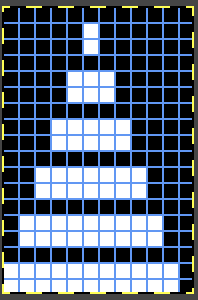 Knit using a superfine 2/18 merino: the tension on either or both beds may need to be adjusted repeatedly for stitches to form and knit off properly, reflected in stitch size variations here.
Knit using a superfine 2/18 merino: the tension on either or both beds may need to be adjusted repeatedly for stitches to form and knit off properly, reflected in stitch size variations here. 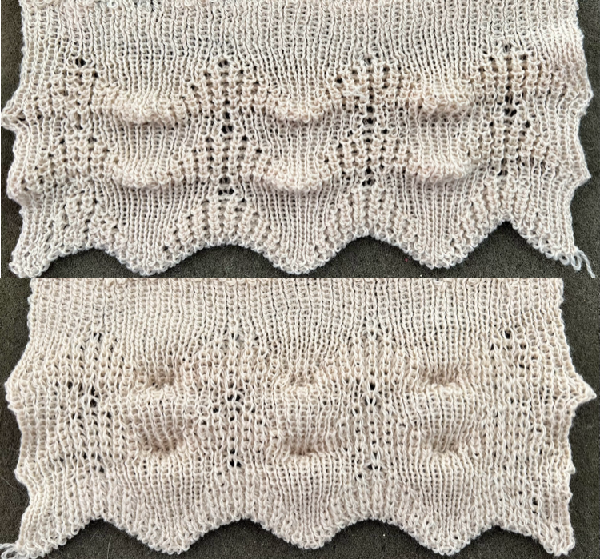 What happens when one is so engrossed with watching stitch formation that the fact that the cone has just run out of yarn is completely missed
What happens when one is so engrossed with watching stitch formation that the fact that the cone has just run out of yarn is completely missed 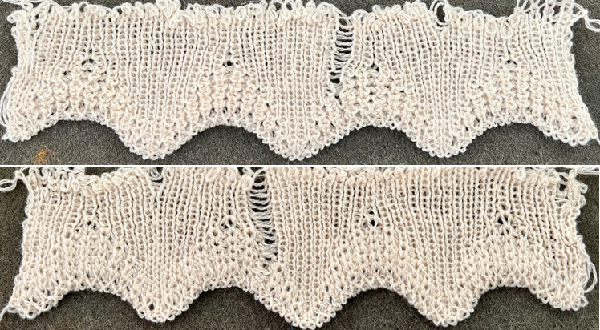 12X24
12X24 ![]()
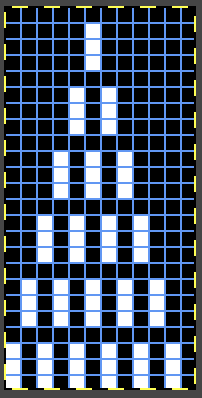 Switching yarn to 2/18 silk wool at the same tension produces knit with a very different density and drape. Light bounces off this yarn interestingly, making it harder to photograph in sharper focus.
Switching yarn to 2/18 silk wool at the same tension produces knit with a very different density and drape. Light bounces off this yarn interestingly, making it harder to photograph in sharper focus. 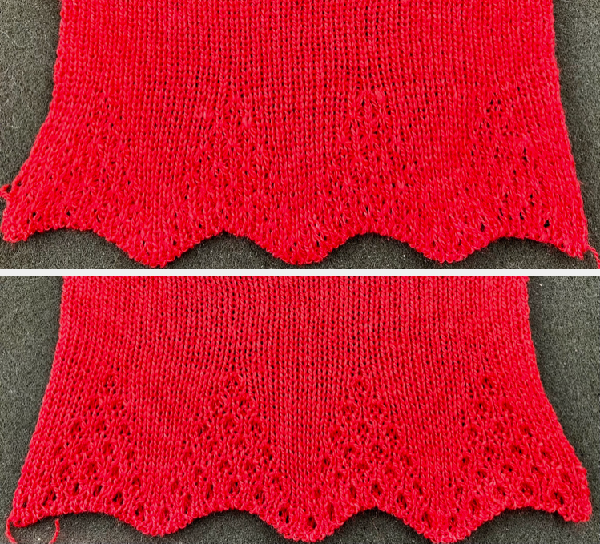 Here the same brand and weight yarn, steamed and pressed lightly, resulting in some flattening of the tuck texture’s 3D effect. Different colors or even different dye-lots of the same color in any yarn can behave differently with all else being equal. The relaxed and stretched view
Here the same brand and weight yarn, steamed and pressed lightly, resulting in some flattening of the tuck texture’s 3D effect. Different colors or even different dye-lots of the same color in any yarn can behave differently with all else being equal. The relaxed and stretched view 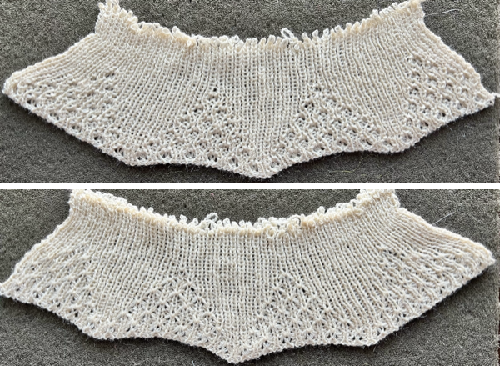 and an attempt at showing its ruffling effect.
and an attempt at showing its ruffling effect.  A very interesting surprise: a few years ago during one of my temporary obsessions I developed racked scale-like 3D patterns, this series reflects some of my first attempts
A very interesting surprise: a few years ago during one of my temporary obsessions I developed racked scale-like 3D patterns, this series reflects some of my first attempts  One of several illustrated repeats designed for assistance from needle patterning preselections
One of several illustrated repeats designed for assistance from needle patterning preselections 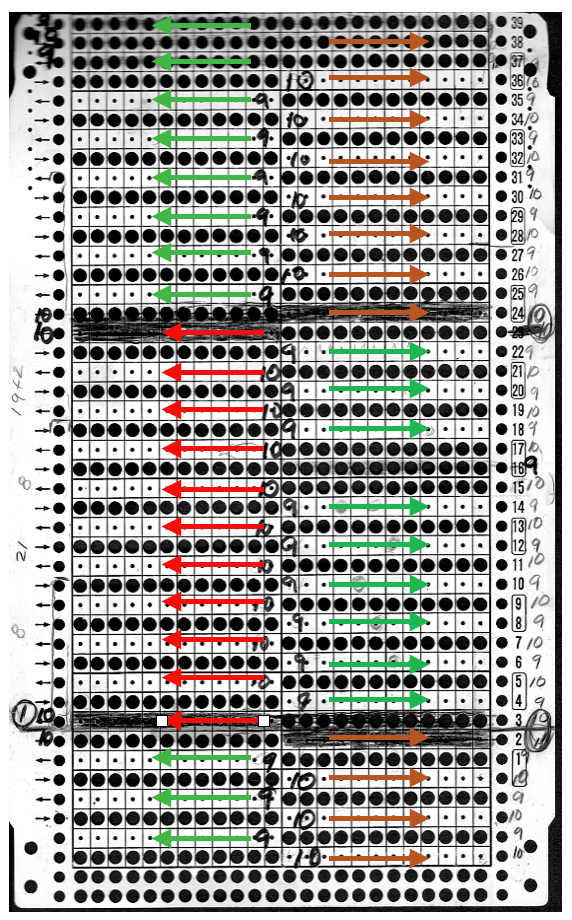 I wondered whether the triangular repeat for the trim above modified to a diamond shape might produce similar results. The proof of concept swatch was far easier to knit, with no racking, and no critical tracking of all-knit row locations than the every needle rib version.
I wondered whether the triangular repeat for the trim above modified to a diamond shape might produce similar results. The proof of concept swatch was far easier to knit, with no racking, and no critical tracking of all-knit row locations than the every needle rib version.![]()

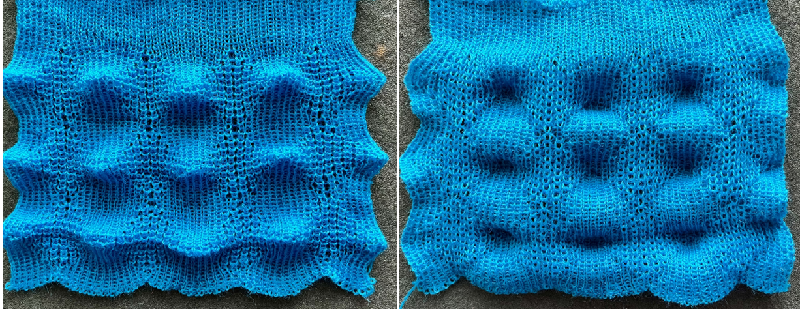
 12X24, rendered suitable for punchcard use
12X24, rendered suitable for punchcard use ![]()
 The tiled repeat for a sense of resulting pattern movement
The tiled repeat for a sense of resulting pattern movement 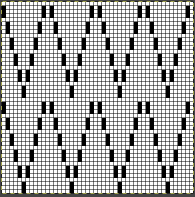 10X24 is missing the single all-knit vertical column seen above
10X24 is missing the single all-knit vertical column seen above ![]()
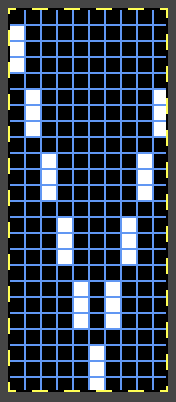 also tiled for visualizing the pattern’s movement
also tiled for visualizing the pattern’s movement 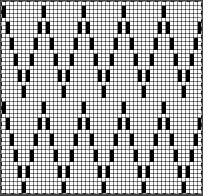 12X12 knit using the tuck setting,
12X12 knit using the tuck setting, ![]()
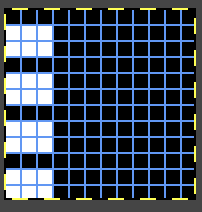
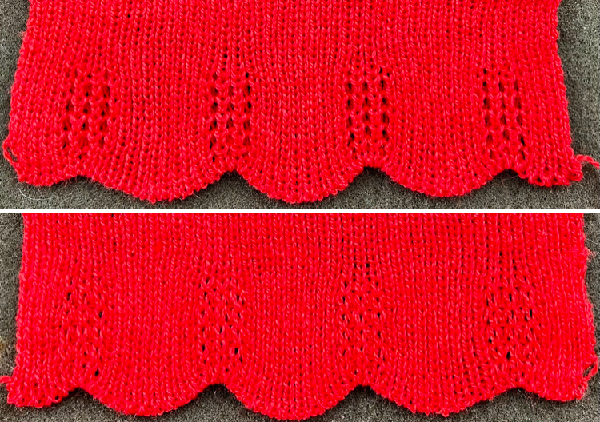 or the slip stitch setting, making for more subtle results
or the slip stitch setting, making for more subtle results 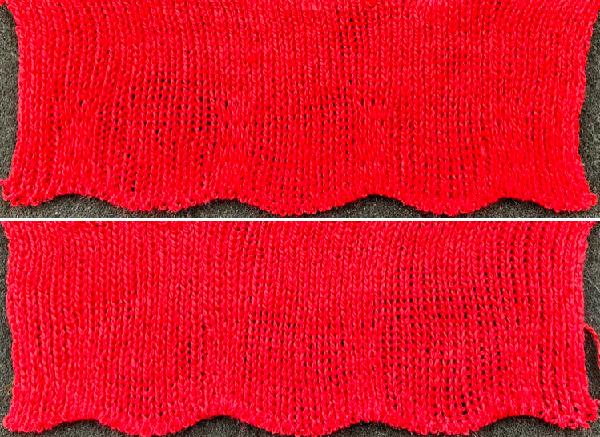
Pintucks 2, ripples in knits using the ribber
This content, on a topic I intended to expand on further, had been “tucked” away as a draft last March.
Ripples in knits are created by knitting an unbalanced fabric, with one of the beds knitting more rows than the opposite bed.
Depending on the design, the fabrics may share similarities with blistered stitches DBJ.
Pintucks vs shadow pleats introduces fair isle patterning possibilities on the top bed.
Pintucks are created by knitting on one bed and slipping on the other for often as many as 6-10 rows followed by plain knitting on both beds to seal the fabric together.
Nopps are made in a similar fashion, but using the tuck setting and for fewer rows. Before moving on to exploring added textures, this shares a few of the many options.
Both fabrics may be knit with or without added automatic patterning.
Pintucks tend to be firmer and with less stretch than fabrics using tuck settings.
Some published sources for single-color versions, though intersections could be isolated and horizontal colored stripes continuing on both beds may be introduced:
fromStudio punchcard volumes included samples, calling the fabric punch pin tuck
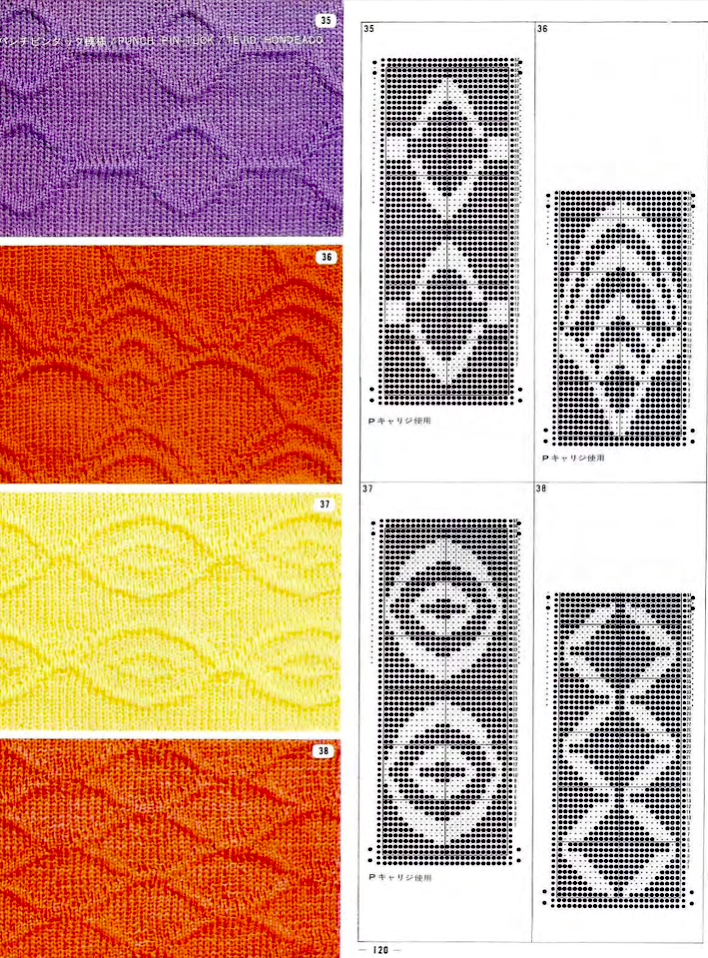
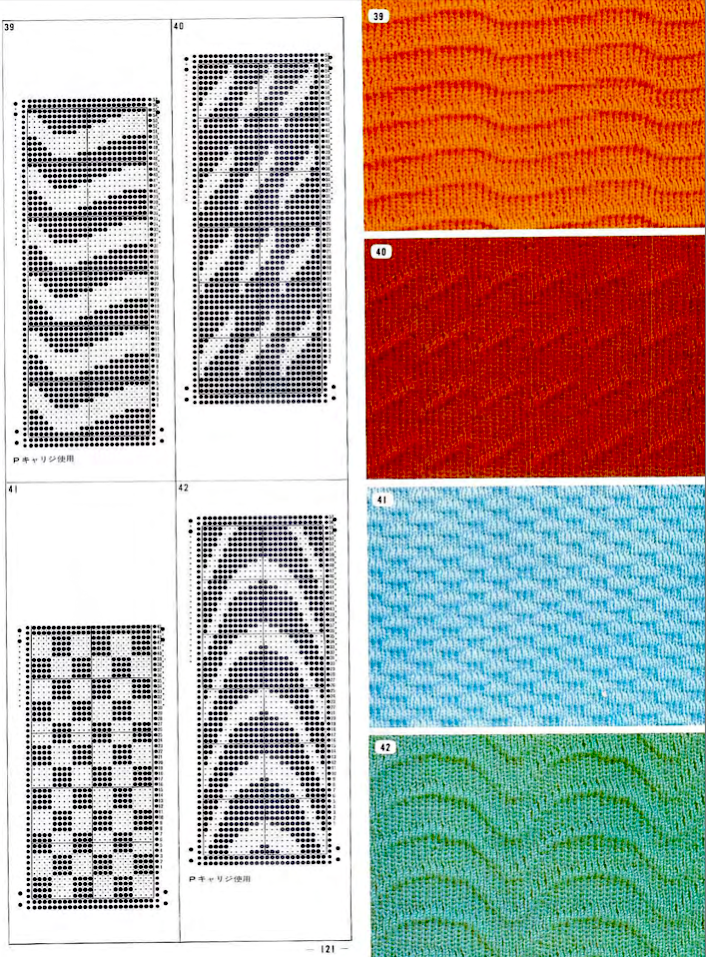 Brother introduced the idea in their Ribber Techniques Book:
Brother introduced the idea in their Ribber Techniques Book: 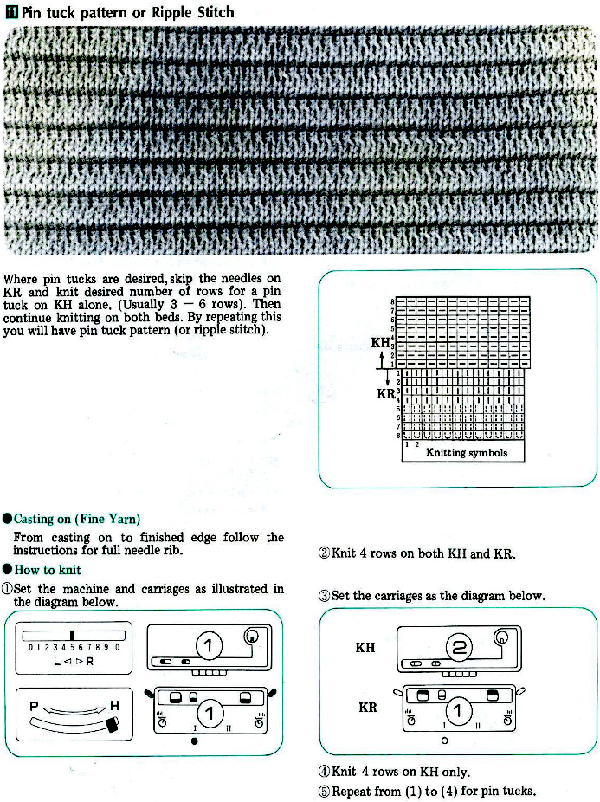
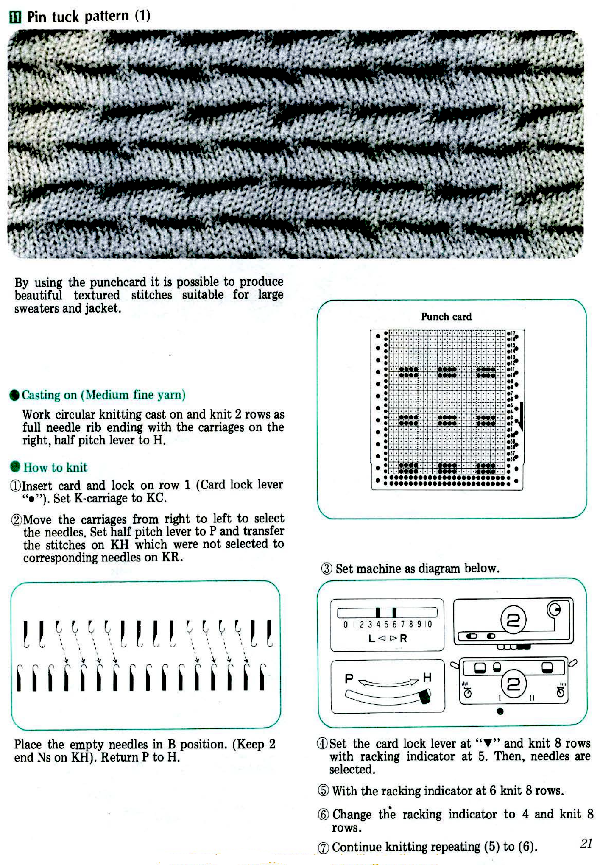
 My experience in knitting these fabrics has been using Brother and Passap. In my blog posts, I discuss fabrics and settings I am able to test and reproduce, so specific ones for other machine brands are not usually included for specific techniques.
My experience in knitting these fabrics has been using Brother and Passap. In my blog posts, I discuss fabrics and settings I am able to test and reproduce, so specific ones for other machine brands are not usually included for specific techniques.
In creating DIY textures, an extra needle is generally used on the bed used to knit the sealing rows.
Nonautomated patterning may be created by leaving needles out of work on either bed. Adding racking changes the fabric even further.
If automatic patterning is used along with tuck or slip settings, the end needle selection on the patterning bed is canceled or the needles on either side of the ones out of work will knit the stitches rather than tucking or slipping them.
Many decisions are made in the process, beginning with a simple variation, A, followed by B with a small number of needles out of work on the top bed,
 which will create ladders between knit spaces as would happen in any single-bed knitting.
which will create ladders between knit spaces as would happen in any single-bed knitting.
Switching to needles out of work on the ribber renders the main bed knitting with blocks of pattern and no floats, C.
The remaining pintucks are created with 6 rows of knitting on the top bed. C: racking sequence is by one position in either direction, followed by another pintuck with no racking before every sealing row
D: racking is by one position in each direction, before every sealing row
E: racking by one position X4 before each sealing row, then reversing the sequence in the opposite direction. The effect on the knit side is subtle.  Additional swatch photos in each post
Additional swatch photos in each post
Ribber fabrics produced with 2 knit carriages selecting needles
racking  Adding lots of texture: Combining knit carriage needle selection with racking and needles out of work. The surface here is more dramatic, it is best to use yarns with memory such as wool, and to have a memo provided by the machine if possible or some other way to help track the racking sequence without errors in long projects.
Adding lots of texture: Combining knit carriage needle selection with racking and needles out of work. The surface here is more dramatic, it is best to use yarns with memory such as wool, and to have a memo provided by the machine if possible or some other way to help track the racking sequence without errors in long projects.  Racking by more positions as well as more knit rows on the top bed.
Racking by more positions as well as more knit rows on the top bed.  Racking: Passap/Brother 3 Combining knit carriage needle selection with racking
Racking: Passap/Brother 3 Combining knit carriage needle selection with racking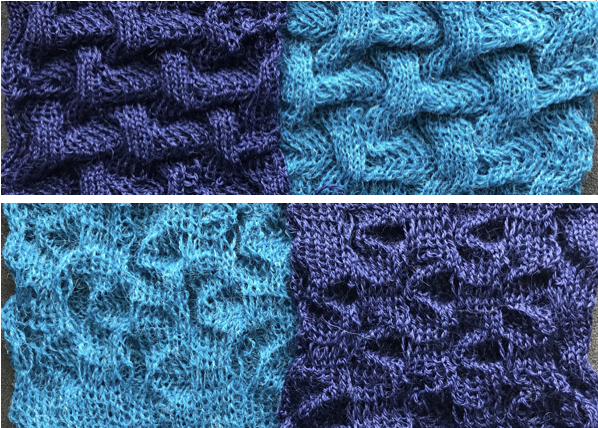 Adding complexity with transfers from one bed to the other to racking
Adding complexity with transfers from one bed to the other to racking  A Passap special begins with deciding on which bed to produce patterning, at first with manual selection on the back bed, then with a programmed repeat on the front bed, no racking
A Passap special begins with deciding on which bed to produce patterning, at first with manual selection on the back bed, then with a programmed repeat on the front bed, no racking 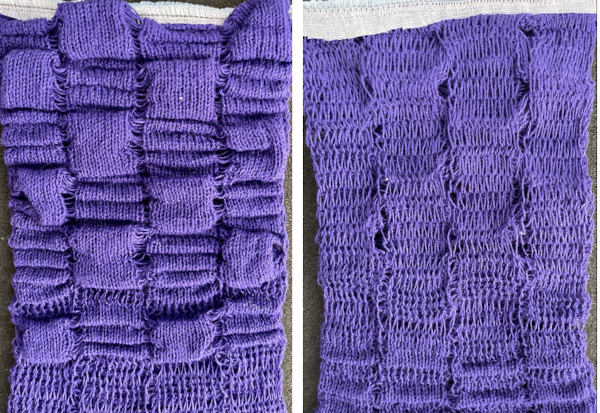 At the top of the swatch, to secure stitches, a strip of woven interfacing was ironed on, and a zig-zag stitch was added with a sewing machine before further trimming.
At the top of the swatch, to secure stitches, a strip of woven interfacing was ironed on, and a zig-zag stitch was added with a sewing machine before further trimming.
A subtle effect with diagonal pattern movement. More details in the post on diagonal patterning in machine knits. ![]()
 and one with evenly distributed, more pronounced folds
and one with evenly distributed, more pronounced folds ![]()
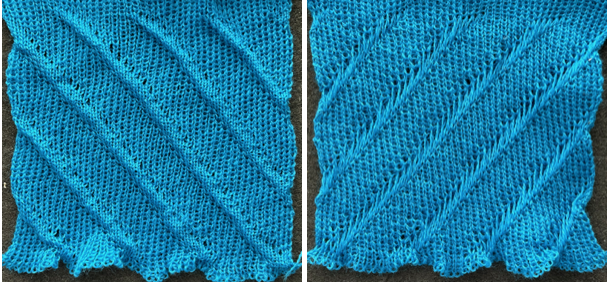
Working with diagonal patterning in machine knitting
After a slow down in my blog posts for a variety of reasons I find myself playing catch up with the eternal list of knit fabrics that I wish to explore out of my own curiosity and the attempt to answer questions from knitters who contacted me directly via the blog or have asked them in the online forums in which I am a member.
Stephen West is a prolific designer of colorful hand knits in a variety of techniques and complexity. This honey-striped scarf is an example.  Slip-stitch patterning is a likely way of knitting a similar effect combined with
Slip-stitch patterning is a likely way of knitting a similar effect combined with
the use of the concept familiar to many when making bias cast-on rags.
A fixed number of stitches is cast on and positioned as far to one side of the machine as possible. They are then decreased on a fixed side and increased on the opposite one.
The strip moves across the needle bed, when far enough on the side opposite to the starting one, it is returned to the original needle bed position and the process is repeated until the desired length is reached.
If the moves to and from are performed on solid color rows matching needle selections may not be an issue. If the repeats in other cam settings are to match, then proper needle placement can be assisted by marking the metal bed, the factory-supplied needle tape, or a custom-printed one, and hand-selection for the first design row may be required and planned.
This chart attempts to visualize the proposed movement using colored stripes. Stitches are bound off on one side and cast-on on the other to maintain a fixed width with shaped edges. 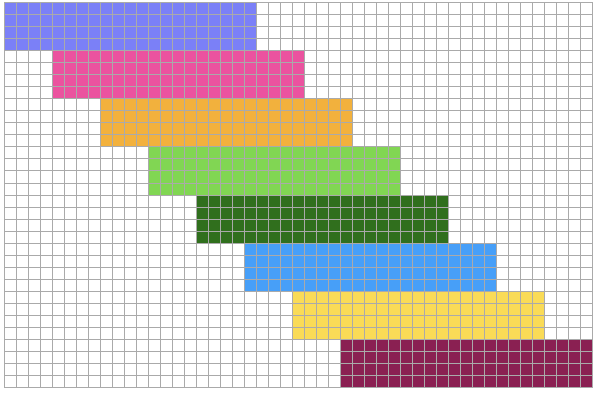 If the goal is to maintain straight bias edges, the design repeat would need to be rendered wider in order to compensate for the shifts on the needle bed in turn modifying increases and decreases at a different rate The black cells represent the adjusted stitch counts needed for each pattern band.
If the goal is to maintain straight bias edges, the design repeat would need to be rendered wider in order to compensate for the shifts on the needle bed in turn modifying increases and decreases at a different rate The black cells represent the adjusted stitch counts needed for each pattern band. 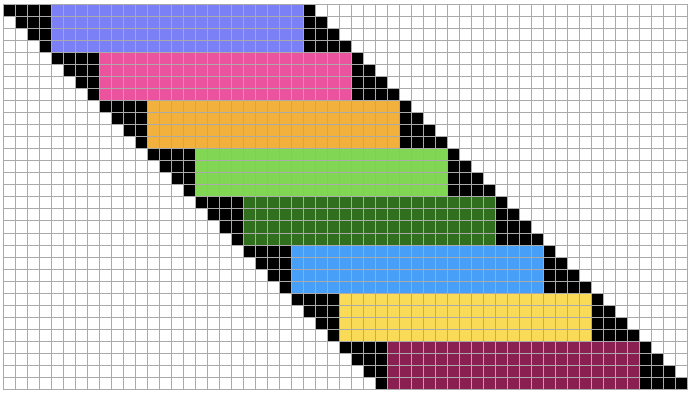 When an item such as a scarf is worn, both options will appear as diagonals.
When an item such as a scarf is worn, both options will appear as diagonals. 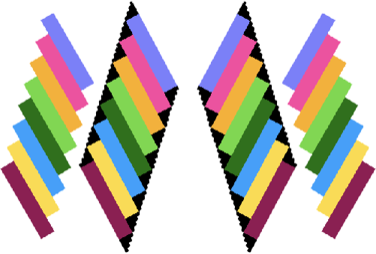 If any picture knitting is included and the direction of it matters when the piece is worn, appreciated particularly in representational fair isle, such accessories are best knit as 2 pieces knit from the bottom up, and grafted together at their center after the fact.
If any picture knitting is included and the direction of it matters when the piece is worn, appreciated particularly in representational fair isle, such accessories are best knit as 2 pieces knit from the bottom up, and grafted together at their center after the fact.
Increases and decreases are calculated based on the knit gauge carefully for garments. The approach to accessories may be more casual.
Stripes heights are varied to accommodate any specific design motifs or cam settings and in turn, are added to the base visualization charts.
Here an attempt at 45-degree striping is made by beginning on a 3-stitch tab. Increasing on the carriage side creates loops, while those opposite the carriage form knots.
Increases and decreases are indicated by arrows.
Increases are made on alternating sides, opposite the carriage, to produce matching edges.
The red cells in the chart represent the carriage side prior to each pass.
Table cells have been rendered rectangular in a 4 to 3 ratio, estimating the difference in gauge between stitches and rows.
Striping for an even number of rows matters if color changes are made on a fixed side ie if a color changer is in use.  Yarn ends at color changes may be cut or the yarn can be carried up the side depending on preference and the number of rows involved. If carried up for long stretches, the alternate color yarn not in use may be secured by e wrapping it on the end needle periodically. Care needs to be taken that the float up the side is not so short as to have an effect on the swatch length and having an effort to remedy that will leave yarn ends too short to be secured.
Yarn ends at color changes may be cut or the yarn can be carried up the side depending on preference and the number of rows involved. If carried up for long stretches, the alternate color yarn not in use may be secured by e wrapping it on the end needle periodically. Care needs to be taken that the float up the side is not so short as to have an effect on the swatch length and having an effort to remedy that will leave yarn ends too short to be secured.
The result is not going to produce a proper square, garter stitch is the only knit stitch that results in approximately true square shapes.
If the center of the machine is always used for swatches, keep an eye on the stitch formation. If loops are formed repeatedly on specific needles akin to tuck stitches or problem areas such as those in the center of this swatch are encountered, they can be caused by damaged needles or sticky latches that may result from frequent use. 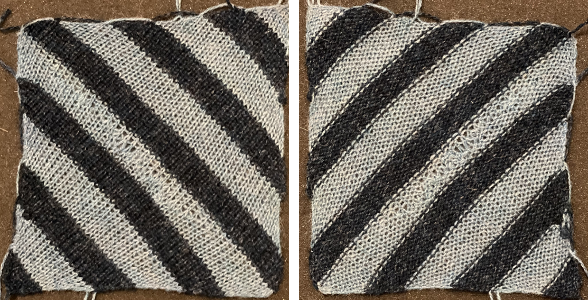 Diagonal lines in knits that maintain straight sides are also achieved using short row/holding intarsia techniques. Segments are planned in specific orders
Diagonal lines in knits that maintain straight sides are also achieved using short row/holding intarsia techniques. Segments are planned in specific orders 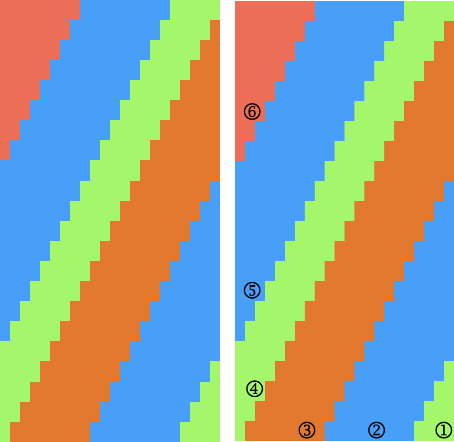 which can be varied to form added shapes.
which can be varied to form added shapes.  Chevrons would be more easily created by knitting separate strips and seaming as you knit or after the fact.
Chevrons would be more easily created by knitting separate strips and seaming as you knit or after the fact. 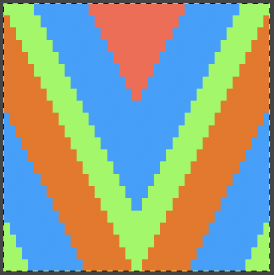 The addition of small-repeat fair isle patterns is also possible. Keep in mind when bringing needles back into work to reverse shaping, needle preselection for accurate patterning in Brother machines needs to be maintained by hand selection.
The addition of small-repeat fair isle patterns is also possible. Keep in mind when bringing needles back into work to reverse shaping, needle preselection for accurate patterning in Brother machines needs to be maintained by hand selection. 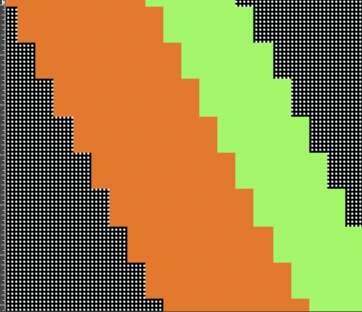 Some of the published punchcard patterns can serve as a source for diagonal lines that may be tiled and programmed for the full design in addition to being used for their original intent. Numbers 52, 384, and 328 (published with error), are suitable for tuck, slip, and FI with moderately wide floats, while 335 would fail as a tuck stitch.
Some of the published punchcard patterns can serve as a source for diagonal lines that may be tiled and programmed for the full design in addition to being used for their original intent. Numbers 52, 384, and 328 (published with error), are suitable for tuck, slip, and FI with moderately wide floats, while 335 would fail as a tuck stitch.
Tiling as in any patterning will reveal errors, such as here for 328. 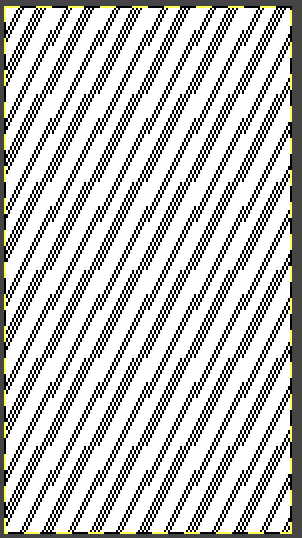 The latter was edited to a 22-stitch wide repeat, becoming suitable for only electronic machine models.
The latter was edited to a 22-stitch wide repeat, becoming suitable for only electronic machine models.
The charts with the red grid on the top row were rendered as tables in Numbers. Since their end use is different, they are the color-reversed version of the cards, whose screengrabs were in turn processed in Gimp to create knittable pngs.
The smallest repeats suitable for electronics are given in the center row of images, the amended 328 cannot be reduced in size. The last row illustrates tiling for all files as BW images that may be opened and amended to suit the size of the pieces planned.
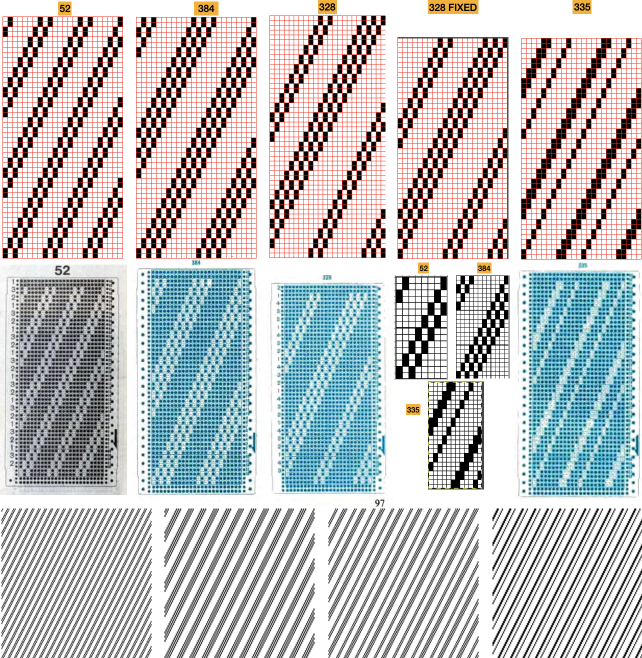 Files in png formats for the group: if pngs generated by me in BW indexed mode are downloaded and opened in editors such as Gimp, they will open in RGB mode. To make them suitable for download programs, convert them to indexed BW mode again and save the result. There should be no loss of data.
Files in png formats for the group: if pngs generated by me in BW indexed mode are downloaded and opened in editors such as Gimp, they will open in RGB mode. To make them suitable for download programs, convert them to indexed BW mode again and save the result. There should be no loss of data.
384, 12X24![]() 12X48
12X48 ![]() 144X144
144X144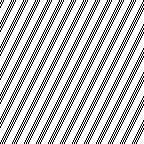 328, 22X44
328, 22X44 ![]()
176X176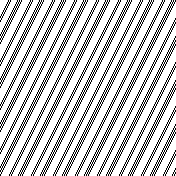
335, 12X24![]()
24X48 ![]() 144X144
144X144 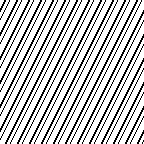 52, 8X16
52, 8X16![]()
24X48 ![]() 192X192
192X192  The black lines formed by units 2 rows in height can be followed or erased to establish short rows shaping a stitch at a time every two rows, in a view of at least 2X2 full repeats to check color placement as seen here.
The black lines formed by units 2 rows in height can be followed or erased to establish short rows shaping a stitch at a time every two rows, in a view of at least 2X2 full repeats to check color placement as seen here.  The method was used to isolate the previous ungridded color illustrations. Another instance of a published Toyota 901#11diagonal tuck card, in this case, incorporates a combination of 2 and 4-row tuck patterning. The repeat is 24X48
The method was used to isolate the previous ungridded color illustrations. Another instance of a published Toyota 901#11diagonal tuck card, in this case, incorporates a combination of 2 and 4-row tuck patterning. The repeat is 24X48 ![]()
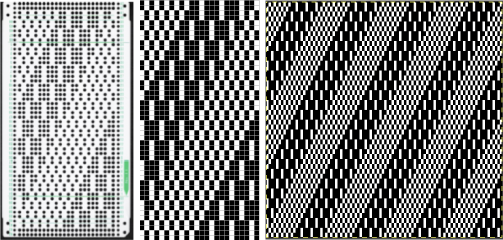 The previews may be used to replace color selections with those matching yarn colors used in the project to develop some idea as to how color shifts might affect the final piece.
The previews may be used to replace color selections with those matching yarn colors used in the project to develop some idea as to how color shifts might affect the final piece.
EON diagonal patterning surrounding blocks containing other shapes may be maintained with slight variations in the size of the shapes used to fill those blocks 
![]()
 References published for weaving can be a source of charts usable for this type of design.
References published for weaving can be a source of charts usable for this type of design.
The repeats are given in terms of width (shafts) and height (picks). For proper alignments, the provided charts need to be reproduced in full, or in DIY adaptations careful editing with erasures or additions can still maintain the proper tiling.
A page from an 1898 pub 
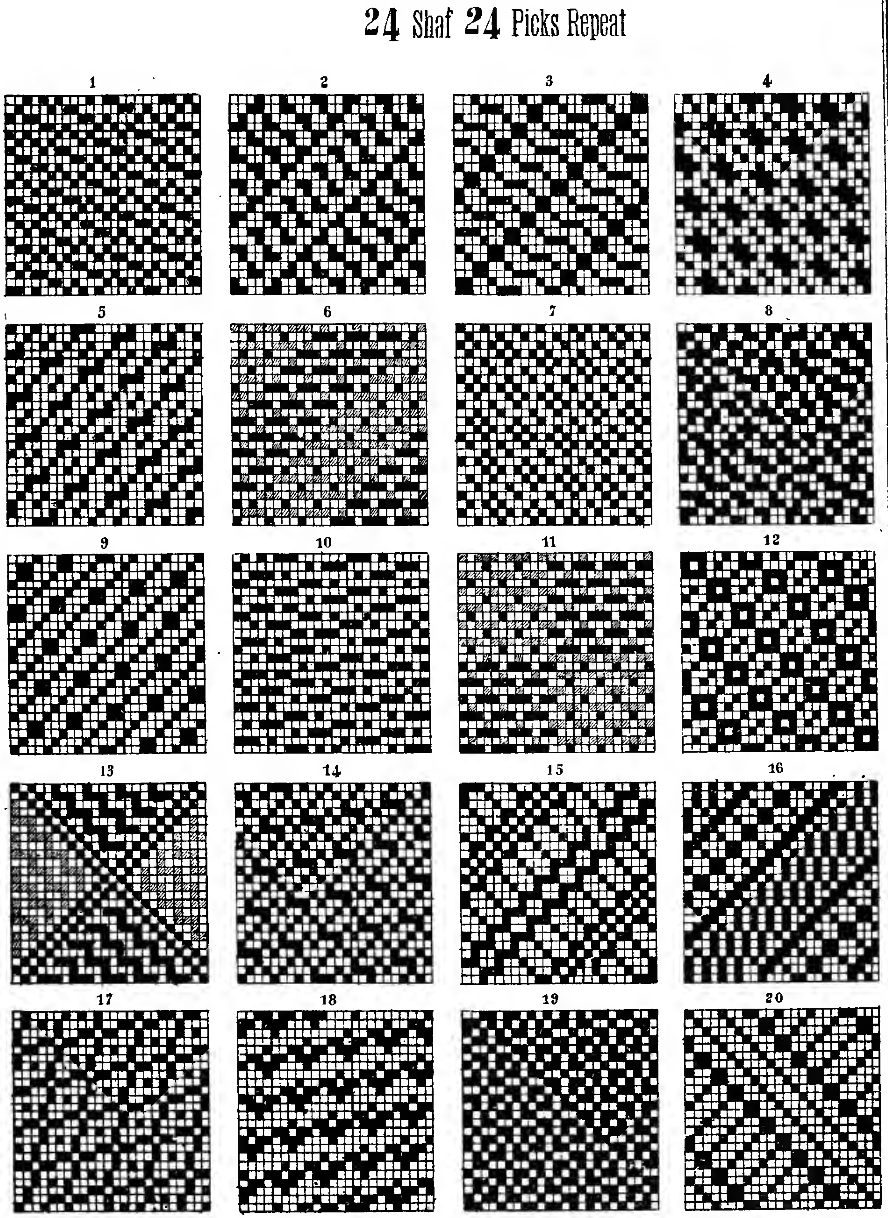 Playing with using #20 and #16 mirrored, isolating, erasing, or combining elements of each while keeping fixed some of the details that move diagonally to touch sides of the repeats, with the process illustrated in color.
Playing with using #20 and #16 mirrored, isolating, erasing, or combining elements of each while keeping fixed some of the details that move diagonally to touch sides of the repeats, with the process illustrated in color.
Consider the width of the floats if planning for fair isle patterning.
Check the original for any errors, marked in the color chart in black. They are often not noticeable until the design is drawn in repeat. 
 The editable png for the center 24X24 design is tiled on the far right above. It is also suitable for punchcards
The editable png for the center 24X24 design is tiled on the far right above. It is also suitable for punchcards ![]()
Handweaving drafts such as those found at handweaving. net provide endless inspiration for designs, including diagonals.
8X8
![]()
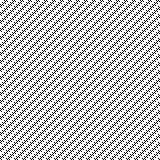 12X12
12X12
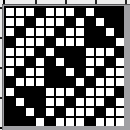
![]() drawn in repeat X7
drawn in repeat X7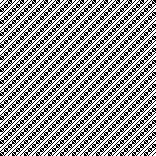 12X12
12X12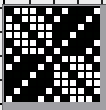
![]() drawn in repeat X7
drawn in repeat X7 15X15
15X15
![]()
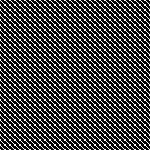 color reversed
color reversed 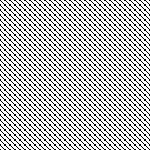 using color invert and quarter rotations to 30X30
using color invert and quarter rotations to 30X30 ![]()
 16X16
16X16
![]()
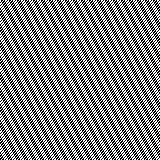 16X16
16X16

![]()
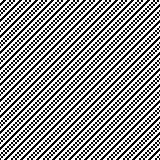 16X24
16X24
![]() drawn in repeat to 160X168
drawn in repeat to 160X168 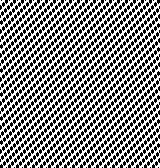 20X20
20X20
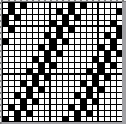
![]()
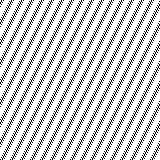 32X32 with rotated segments
32X32 with rotated segments ![]()
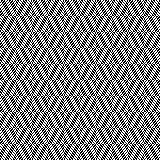 playing with rectangles, squares, and fill-ins24X24
playing with rectangles, squares, and fill-ins24X24
![]()
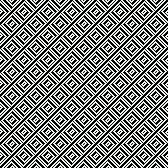 Chevrons can be developed from partial repeats. This is from Toyota 950#12, 24X20
Chevrons can be developed from partial repeats. This is from Toyota 950#12, 24X20 
![]() drawn in repeat to 144X140
drawn in repeat to 144X140 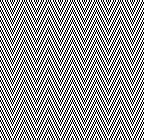 Whether in use for a punchcard model or an electronic one, the convention if the end goal is a tuck stitch fabric, is to color reverse the design
Whether in use for a punchcard model or an electronic one, the convention if the end goal is a tuck stitch fabric, is to color reverse the design 
![]() Taking diagonal patterning to the double bed for creating pintuck effects using the slip-stitch setting, this 24X48 repeat explores some of the potential spacings and the resulting ridges.
Taking diagonal patterning to the double bed for creating pintuck effects using the slip-stitch setting, this 24X48 repeat explores some of the potential spacings and the resulting ridges. ![]()
 The next 2 repeats tested, both 24 stitches X 48 rows:
The next 2 repeats tested, both 24 stitches X 48 rows: 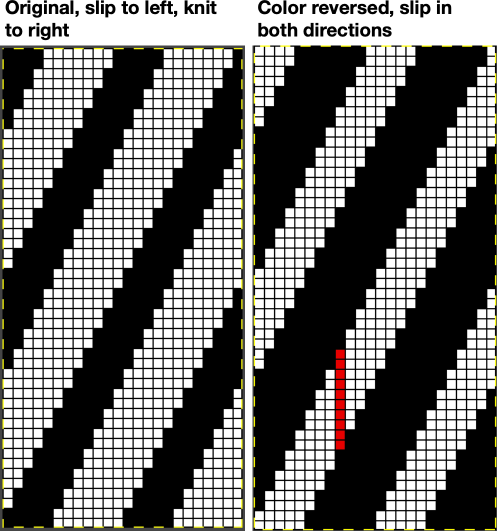 The red line is a reminder that the slipped stitches are being held for as many as 8 rows. It is best to use thin yarn that does not break easily and to watch for the knit stitches riding up.
The red line is a reminder that the slipped stitches are being held for as many as 8 rows. It is best to use thin yarn that does not break easily and to watch for the knit stitches riding up.
Slipping in one direction produces a very subtle texture, ![]()
 while the color-reversed design produces even-sized identifiable folds
while the color-reversed design produces even-sized identifiable folds ![]()
 Adding lettering or small shapes and maintaining the diagonal can result in distortion of the motifs.
Adding lettering or small shapes and maintaining the diagonal can result in distortion of the motifs.
One option to add such motifs is to form the knit by beginning on 3 stitches as in this shared swatch and planning the stripes to heights and widths that accommodate adding designs or fonts. 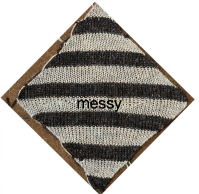 Short-row intarsia will also produce diagonal striping, from simple to complex as seen in this chart, with knitting sequence numbered for each segment.
Short-row intarsia will also produce diagonal striping, from simple to complex as seen in this chart, with knitting sequence numbered for each segment. 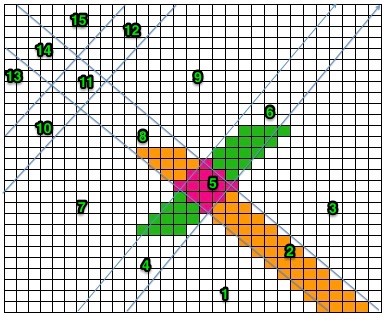 A limited number of rows may be knit in stocking stitch in areas following shapes not simply to travel to the opposite side and reverse shaping, but also to add small rolls or hems.
A limited number of rows may be knit in stocking stitch in areas following shapes not simply to travel to the opposite side and reverse shaping, but also to add small rolls or hems.
Another use might be to add small vertical motif details or patterning in their usual orientation.
The limit appears to be a maximum of 8 rows of alternative patterns, in order to keep the short-rowed areas from developing into distorted edges, which may be variable depending on the yarn and pattern used.
This first swatch was knit using progressively thinner yarns, wool, wool rayon, and a 2/24 acrylic in the FI segment. FI is a slip stitch that narrows the knit. The dark acrylic color stitch definition here gets lost. The band is seen pulling in the short-row segments on both sides. The shaping in both the top and bottom segments is by 2 stitches at a time.  The result in different yarns of equal thickness, with the FI band knit at a tension one full number looser than the stocking stitch areas, with the top and bottom solid color segments now shaped 3 stitches at a time.
The result in different yarns of equal thickness, with the FI band knit at a tension one full number looser than the stocking stitch areas, with the top and bottom solid color segments now shaped 3 stitches at a time. 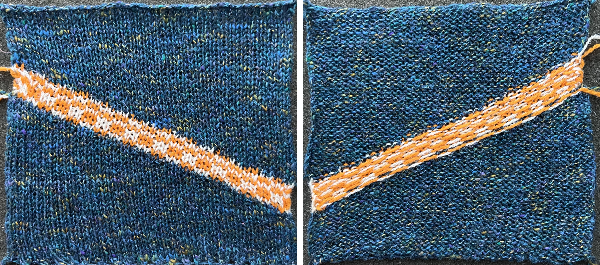 There is a trick when making A-line skirts to change the triangles that would poke out normally at the bottom if shaping were to begin immediately used as a design feature in many runway knits recently. If between an inch or 2 are actually knit up straight before shaping starts, the problem is eliminated. Depending on the design this may be a solution or it may read as a patterning error.
There is a trick when making A-line skirts to change the triangles that would poke out normally at the bottom if shaping were to begin immediately used as a design feature in many runway knits recently. If between an inch or 2 are actually knit up straight before shaping starts, the problem is eliminated. Depending on the design this may be a solution or it may read as a patterning error.
There are some conventions and “rules” for short-row techniques, but they do not always apply.
Keeping good notes helps to make successful experiments reproducible.
Two more tries began to experiment with working on the first and last groups in the holding techniques on a different number of stitches than the remaining shapes, noting differences. In the first an all-knit row is made across the short-row eyelets, reducing the planned FI band from 6 rows to 5. A rough spot in maintaining even stitches on one side is noticeable. 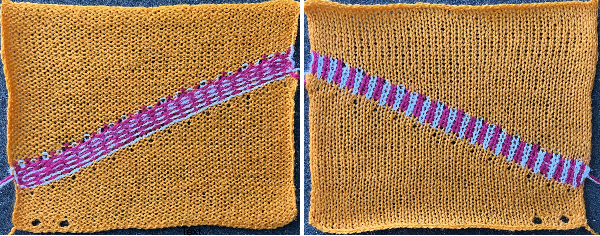 Progress: holding happened at the start of the bottom wedge, the FI was knit at 2 tension numbers looser than the stocking stitch, for 6 rows.
Progress: holding happened at the start of the bottom wedge, the FI was knit at 2 tension numbers looser than the stocking stitch, for 6 rows.  The goal in the short row shaping for the triangles is to maintain vertical edges that appear as straight as possible to the eye. One need not work on large swatches, small ones can provide clues as to differences resulting from variations in the starting side of the short-row shapings.
The goal in the short row shaping for the triangles is to maintain vertical edges that appear as straight as possible to the eye. One need not work on large swatches, small ones can provide clues as to differences resulting from variations in the starting side of the short-row shapings. 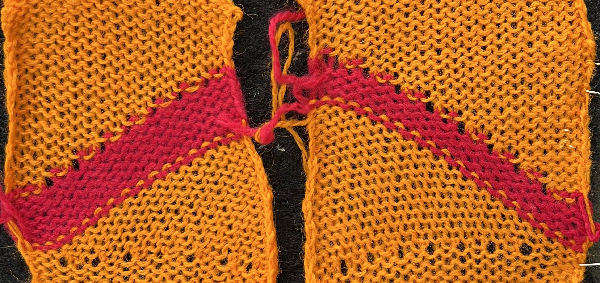 Studying the results can lead to many variations. There are student theses and careers based on exploring limited techniques to the max.
Studying the results can lead to many variations. There are student theses and careers based on exploring limited techniques to the max.
Building a theoretical true square or other predictable shapes is subject to the yarn and tension used. Beginning with a small sample, this shows the order of knitting 2 triangular shapes with the carriage beginning to knit each shape from alternate sides. In this case, 2 stitches are to be brought in and out of holding at a time.  Because each color knits for 2 rows, small slits happen in the fabric resulting in eyelets. They may be used as design features, or attempts can be made to reduce their size. One way to do so is to have plain knit rows between holding selections to keep the small slits from intersecting and becoming double height. On the left swatch, one yellow row was knit to the left before reverse shaping in the same color. In the swatch on the right, in addition, 2 rows were knit in the blue prior to reverse shaping.
Because each color knits for 2 rows, small slits happen in the fabric resulting in eyelets. They may be used as design features, or attempts can be made to reduce their size. One way to do so is to have plain knit rows between holding selections to keep the small slits from intersecting and becoming double height. On the left swatch, one yellow row was knit to the left before reverse shaping in the same color. In the swatch on the right, in addition, 2 rows were knit in the blue prior to reverse shaping.  Reviewing the concept and developing a chart for larger swatches: the cyan color cells represent stitches in the hold position and the white cells stitches that will be knit.
Reviewing the concept and developing a chart for larger swatches: the cyan color cells represent stitches in the hold position and the white cells stitches that will be knit.
At the top of the first wedge, most needles will be in the hold position, return them all to the B position manually before knitting the next row.
With the carriage on either side, set it for KCI with the cam buttons to slip for a free pass to the opposite side, the first FI pattern row will pre-select. Holding need not be canceled, since no needles are brought far enough out for the technique.
Cancel the slip setting, change the cam setting for FI knitting, place the pairs of colors in their corresponding feeders, and knit 6-8 rows of pattern.
Bring all needles out to hold except for the first desired group, if the holding lever has been canceled, reset it and commence reverse shaping.  Merrily knitting along and you forget to loosen the tension for the fair isle stripe:
Merrily knitting along and you forget to loosen the tension for the fair isle stripe:  And what if the FI were to actually follow diagonal colored stripes? The approach is the same. I am right-handed, my default is often to begin on the right. Left-handed knitters can mirror charts as needed to make them easier to follow.
And what if the FI were to actually follow diagonal colored stripes? The approach is the same. I am right-handed, my default is often to begin on the right. Left-handed knitters can mirror charts as needed to make them easier to follow.
The first triangle is shaped from right toward left, subsequent ones begin on the left, then to wrap or not wrap becomes the question. 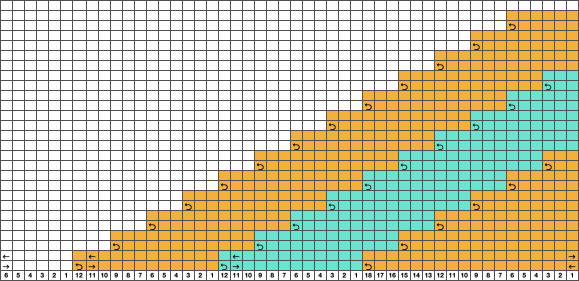 Review of wrapping, which does not disturb the stitch on or the position of the wrapped needle:
Review of wrapping, which does not disturb the stitch on or the position of the wrapped needle:  I obstinately use random yarns at hand, sometimes too thin for the task at hand, true here. Any type of intarsia, of which holding is one, will be accompanied by lots of yarn ends that will require weaving in. Some of the stitches were wrapped here, some not, and maybe the eyelets could be considered a pleasing design feature. The 8 rows of FI, knit at 2 full tension numbers higher than that used for stocking stitch, minimizes the size of the eyelets all on their own on both sides of its stripe. Errors in bringing an added group or not into work may not always be immediately visible, frogging this type of knitting can be painful.
I obstinately use random yarns at hand, sometimes too thin for the task at hand, true here. Any type of intarsia, of which holding is one, will be accompanied by lots of yarn ends that will require weaving in. Some of the stitches were wrapped here, some not, and maybe the eyelets could be considered a pleasing design feature. The 8 rows of FI, knit at 2 full tension numbers higher than that used for stocking stitch, minimizes the size of the eyelets all on their own on both sides of its stripe. Errors in bringing an added group or not into work may not always be immediately visible, frogging this type of knitting can be painful.
I would not use the last 6 stitch modification in any future swatches. 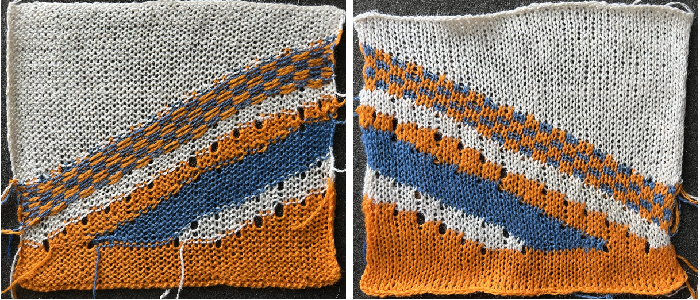 Elizabeth Zimmermann published many patterns for hand knitting utilizing garter stitch and striped diagonal wedges for garment shaping.
Elizabeth Zimmermann published many patterns for hand knitting utilizing garter stitch and striped diagonal wedges for garment shaping.
Multiple colors per row patterning may be maintained by beginning planning with diagonal straight lines, seen here in a 32X32 repeat. ![]() Opened in img2track
Opened in img2track  The design will be elongated, and 256 passes are required to finish a single repeat
The design will be elongated, and 256 passes are required to finish a single repeat  Each color may be edited to suit. Quick visualizations of a few of the possible repeat arrangements using the file as is
Each color may be edited to suit. Quick visualizations of a few of the possible repeat arrangements using the file as is  Avoiding lots of extra knit rows by eliminating one of the colors.
Avoiding lots of extra knit rows by eliminating one of the colors. ![]()

 The larger designs may need to be knit in sections depending on the available memory in the knitting machine model being used.
The larger designs may need to be knit in sections depending on the available memory in the knitting machine model being used.
Machine-knit stitches do not form as close to square ones found in garter stitches. Rendering the full-scale garment on a knit leader would make knitting to gauge while avoiding tons of math calculations possible.
DIY is a bit like assembling paper cut-outs that are required to fit together, first attempts at planning do not always succeed. One may begin at different parts of the piece and seam two halves together if necessary in order to keep matching stitch formations in both directions. Stripes may be added to form secondary intersecting shapes. 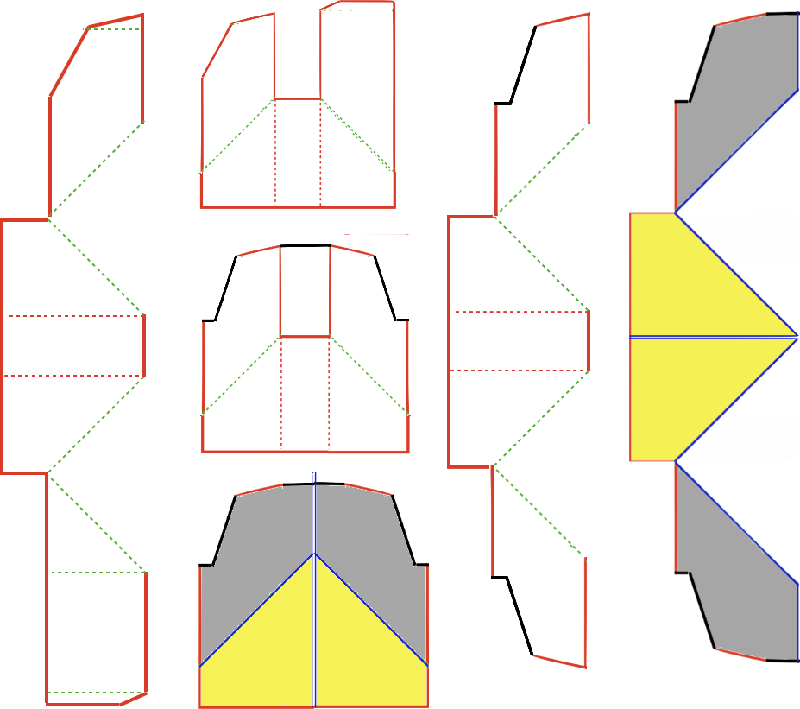 On the left is a simple one-piece vest concept with no miters in the back panel, which may be knit from the bottom up or as two pieces with a center seam.
On the left is a simple one-piece vest concept with no miters in the back panel, which may be knit from the bottom up or as two pieces with a center seam.
The bolero style is repeated in 2 separate pieces with mirror shaping in the second and would be joined at the center back.
The knit gauge is easier to maintain in short or small wearables. 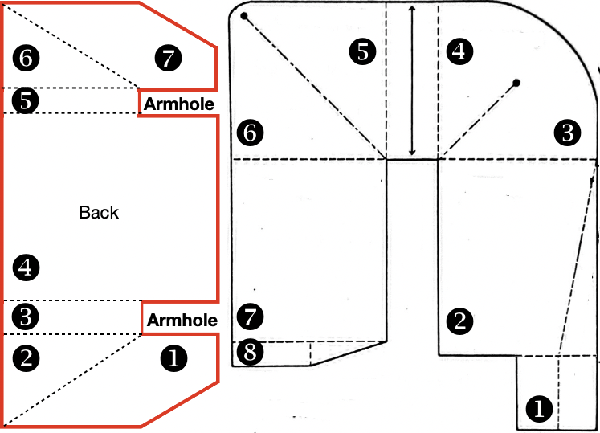 Many garments may be made following the concepts for creating “pies”.
Many garments may be made following the concepts for creating “pies”.
Decades ago batwing sweaters based on a sideways circular knit concept were standard presentations at knit seminars. Short-row diagonal graduated wedges were followed by varying amounts of all knit rows.
This idea for a short sleeve garment is from a Japanese magazine. In creating such illustrations because of the scale of the publication, the aspect ratio is distorted. In the final garment, the bottom circumference can in fact be far narrower than it might appear to the eye in the sketch and may be gathered or left released depending on design goals. The neckline diameter at the end of the project, after joining one shoulder, is gathered with evenly distributed decreases to the desired measurement prior to knitting the collar.  A way to form a long sleeve item, using binding off and casting on stitches in addition to shaped wedges followed by all knit rows.
A way to form a long sleeve item, using binding off and casting on stitches in addition to shaped wedges followed by all knit rows.  Knitting a garment on the bias at 45 degrees will produce a knit fabric that drapes differently.
Knitting a garment on the bias at 45 degrees will produce a knit fabric that drapes differently.
Horizontal patterning can turn into diagonals and chevrons, and fancy decreases may be used in the center shaping of the garment.
Pre-computer programs and knitleaders, an easy way to sort out shaping for garments, was to begin by drawing on large sheets of graph paper. An all-square grid is fine.
Calculate a 10 cm/4 inch knitting gauge to the second decimal point before any rounding off. For example, if the gauge works out to be 5.728, and the measurement needed is 19.5 inches, the multiplied value result is 111.696, which can be rounded off to a 112-row line on the graph paper.
Working in cm can actually lead to easier calculations and is required when using a charting device.
Each cell in the graph paper grid equals one stitch and one row.
For knitting on the straight grain, based on gauge, draw series dots placing them on the beginning and the ending pots for each measurement, and connect them with straight lines.
Curves such as those necessary for necklines may be composed of short straight-line segments.
When knitting from the bottom up, continue with a colored pencil, filling in squares as they jog in or out, maintaining the new outline as close to the first as possible.
For the bias knit, whether on graph paper, the computer, or a charting device, begin by drawing a 45-degree line.
Rotate and trace the unmodified original straight-line image in place, follow the lines, and mark in and out jogs once more in color for contrast.
This is a very small chart so outline jogs in far larger pieces cannot be reflected. They would produce edges not as straight as in standard knitting, which will need to be considered when joining finished pieces.
As the piece is rotated, a wider grid base is required. Consider that the motif images as they are worked on the purl side will be mirrored horizontally on the knit side, a particular consideration if any text is introduced. 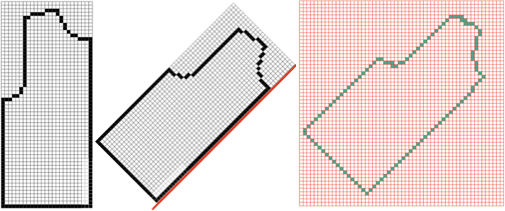
 Comparing theoretical purl as opposed to knit views on the left, two purl views on the right.
Comparing theoretical purl as opposed to knit views on the left, two purl views on the right.  Fonts in various stitch and row counts are useful when planning knit text.
Fonts in various stitch and row counts are useful when planning knit text.
The point at which the text or pattern is introduced needs to have enough stitches in work on the machine to contain the intended words, ie for the above, a minimum ground, independent of shaping, would need to contain more than 9 rows if solid color stripes are to be added above and below it, and 26 stitches in width in this case.
A proof of concept swatch with arbitrary shaping on every other row illustrates the need for shaping based on a calculated gauge if a square is indeed the aim.
I knit on a 930 where mirroring is automated for programmed designs, so the text was programmed as drawn.
Sometimes less information is more. It became evident very soon that the placement of the text on the left was wrong if the aim was to have it centered in the final shape, and that more rows were needed at the top of the design.
On the right, the purl side as it faces the knitter is shown, with black pixels used to represent increases and decreases. The center red line separates the needle placements on either side of 0, and the text is shown in the default mirroring.  The respective swatches after their rotation preview one of the potential results
The respective swatches after their rotation preview one of the potential results 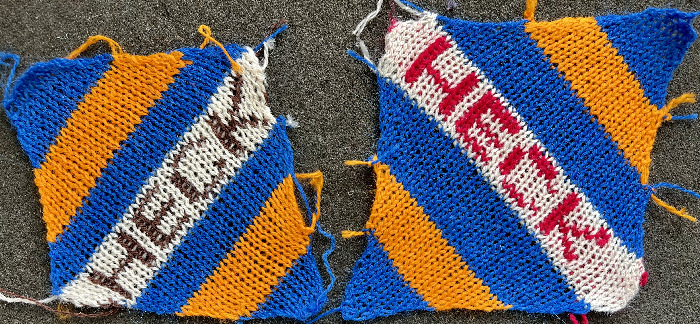
 A true diagonal repeat may be planned for motif patterning knit from the bottom up. The drawback is that for executing a fair isle using more than 2 colors or with multiple color changes, partially illustrated on the far right, the 32X32 repeat would need to be rotated and knit as above.
A true diagonal repeat may be planned for motif patterning knit from the bottom up. The drawback is that for executing a fair isle using more than 2 colors or with multiple color changes, partially illustrated on the far right, the 32X32 repeat would need to be rotated and knit as above. ![]()

From the Brother machine knitting techniques book, a suggestion for dividing a sweater front into diagonal halves created by using the holding technique 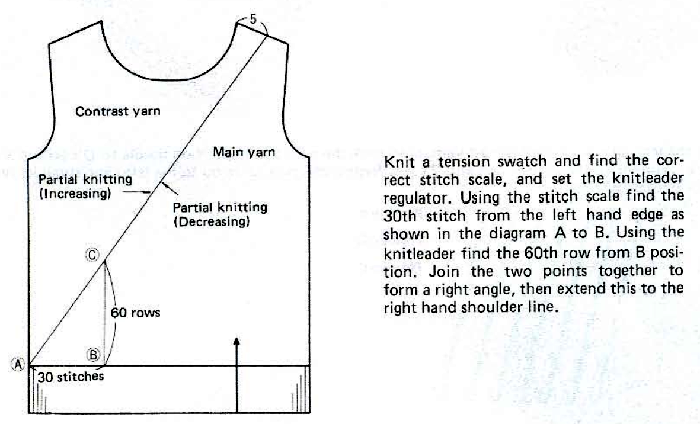
The idea of chaining the eyelet areas to reduce the size of the slits is an interesting one that up to now I have not tested.
